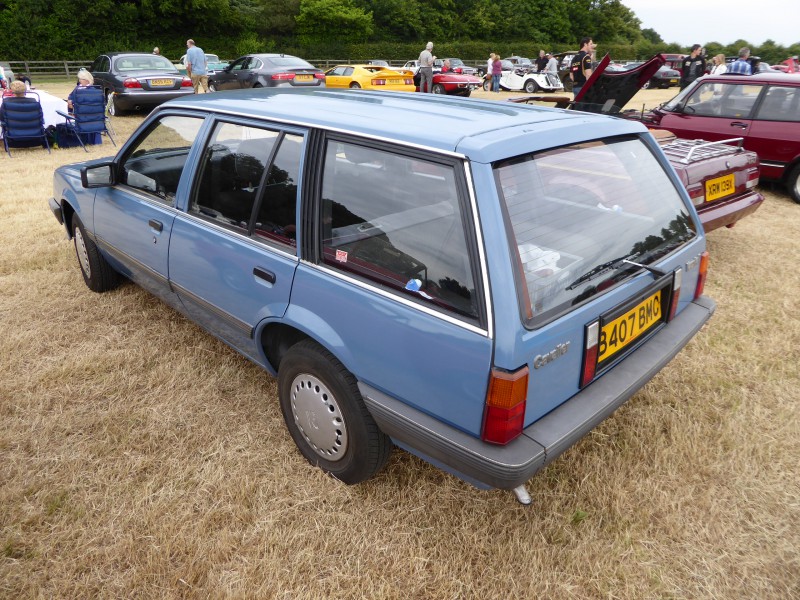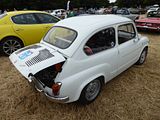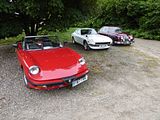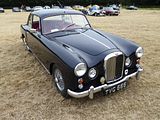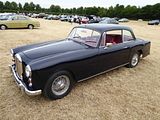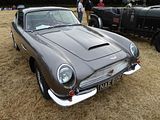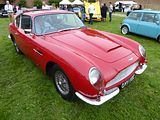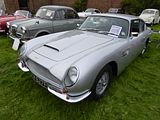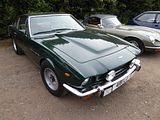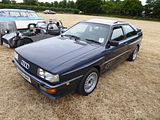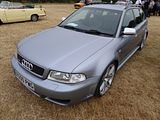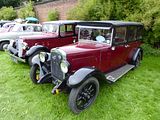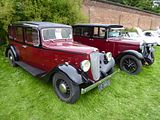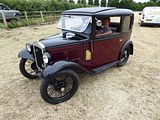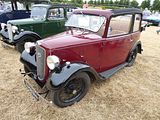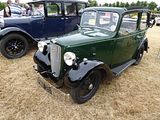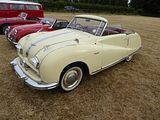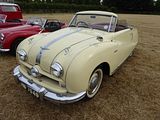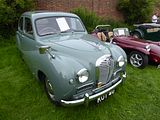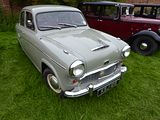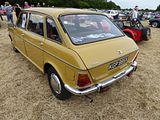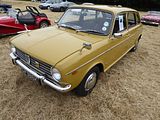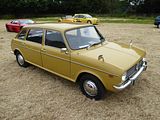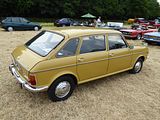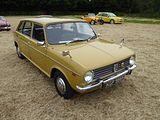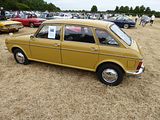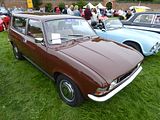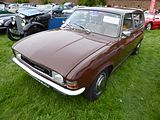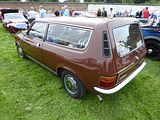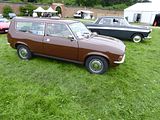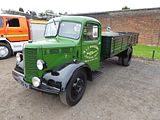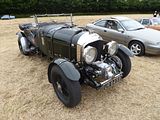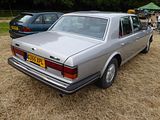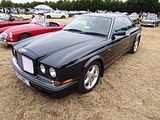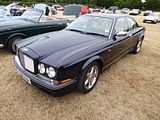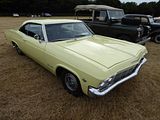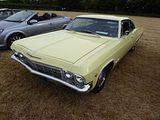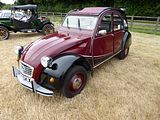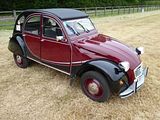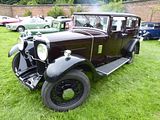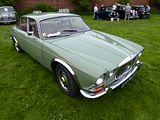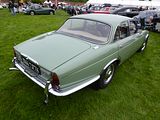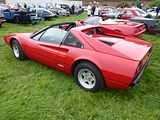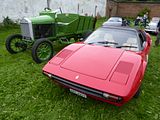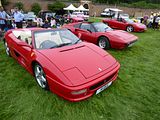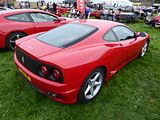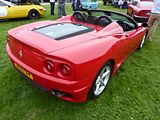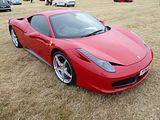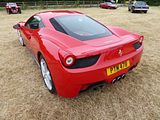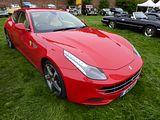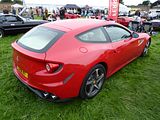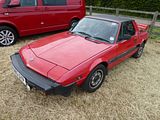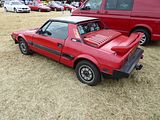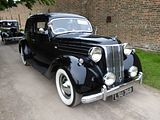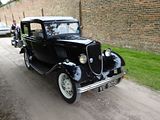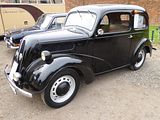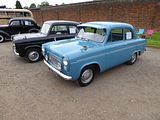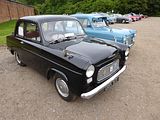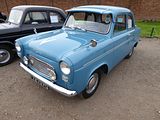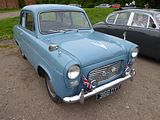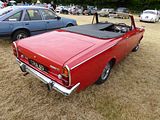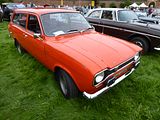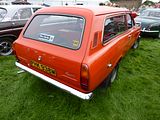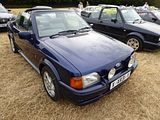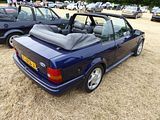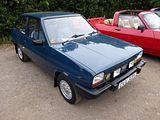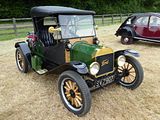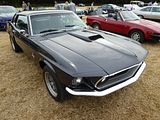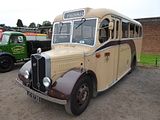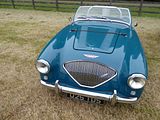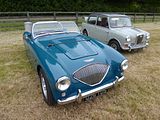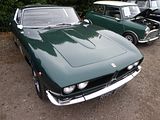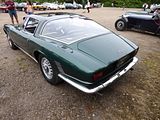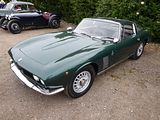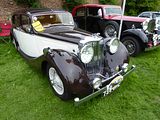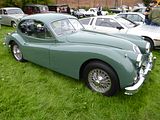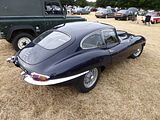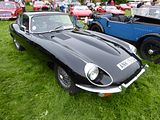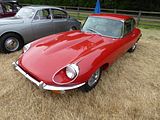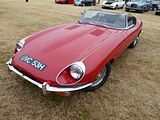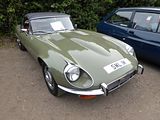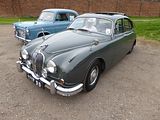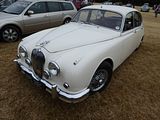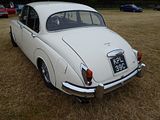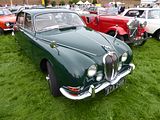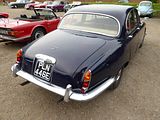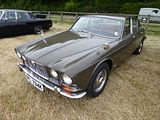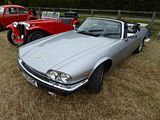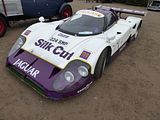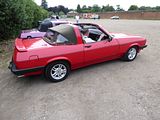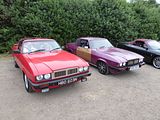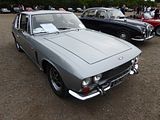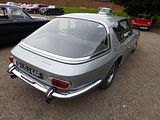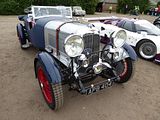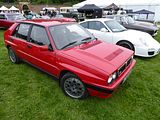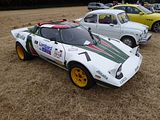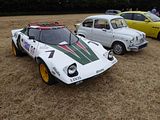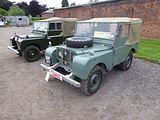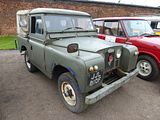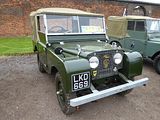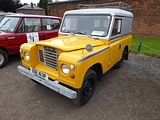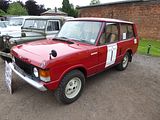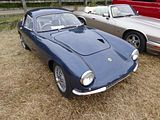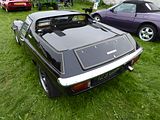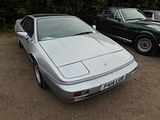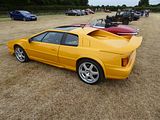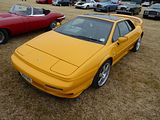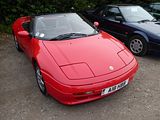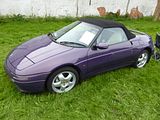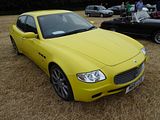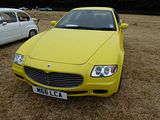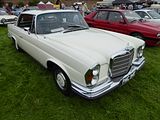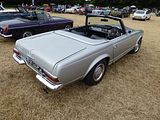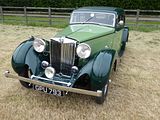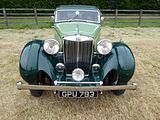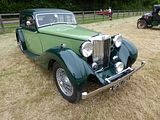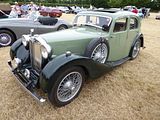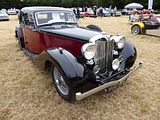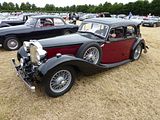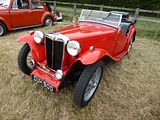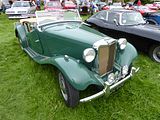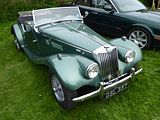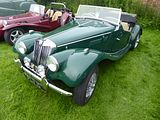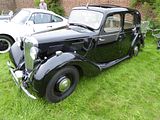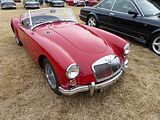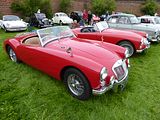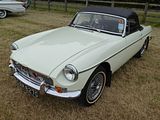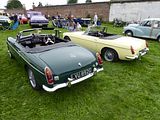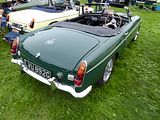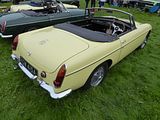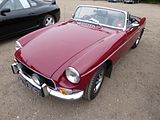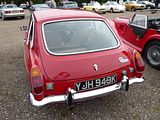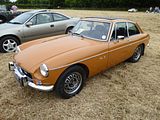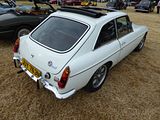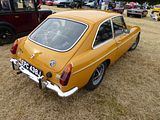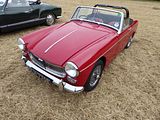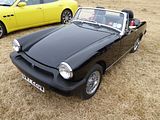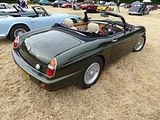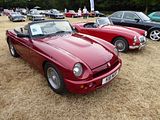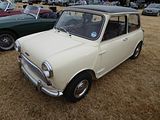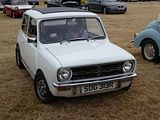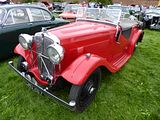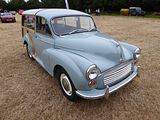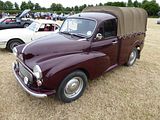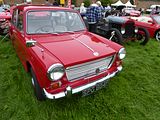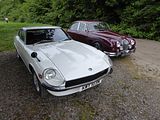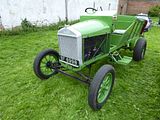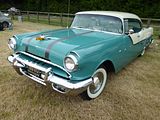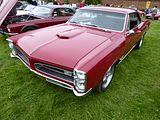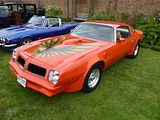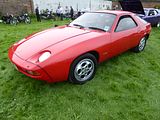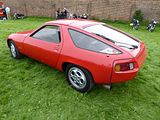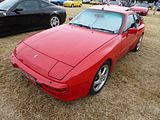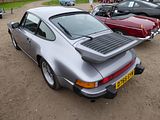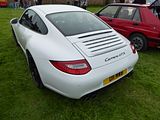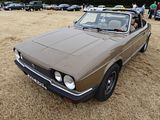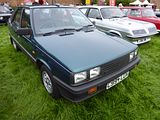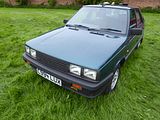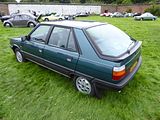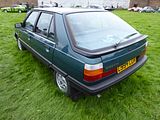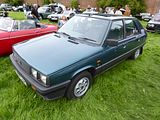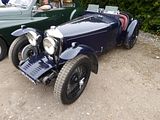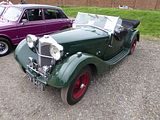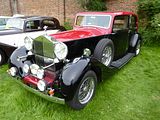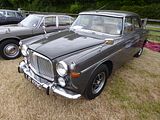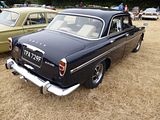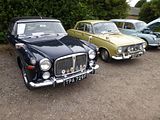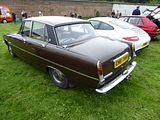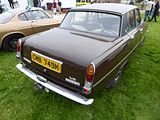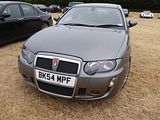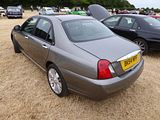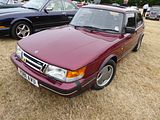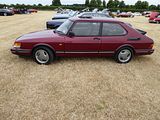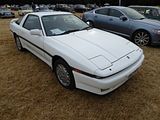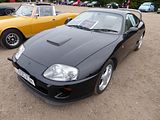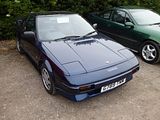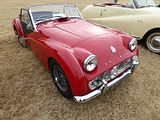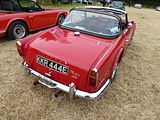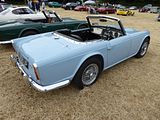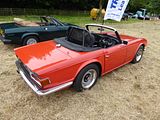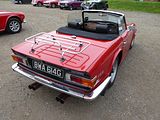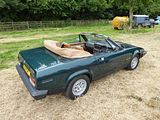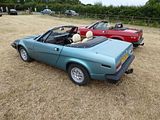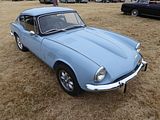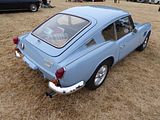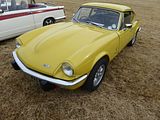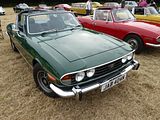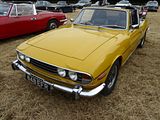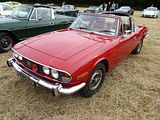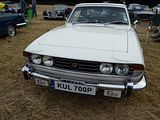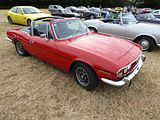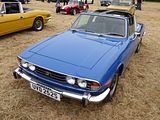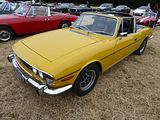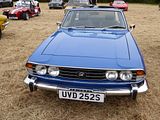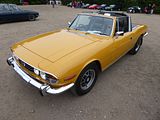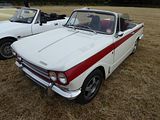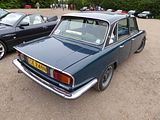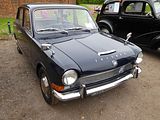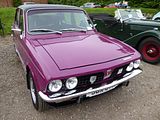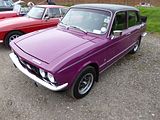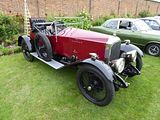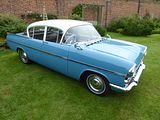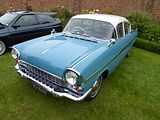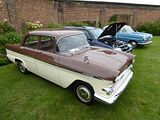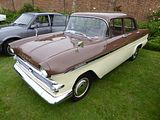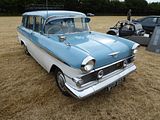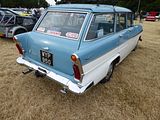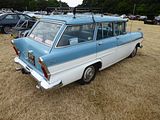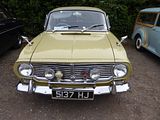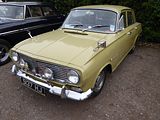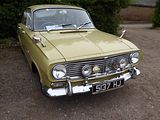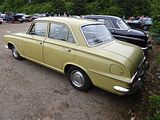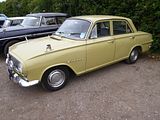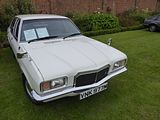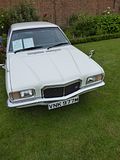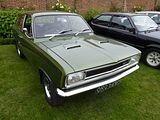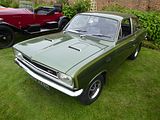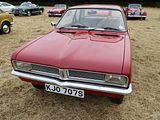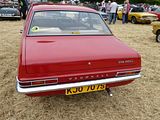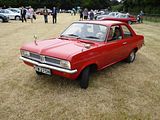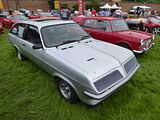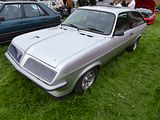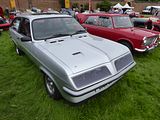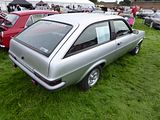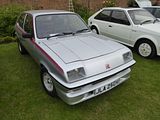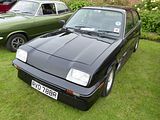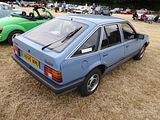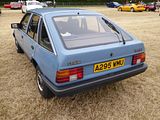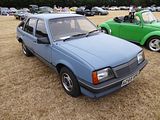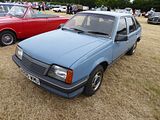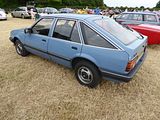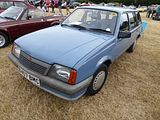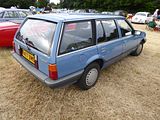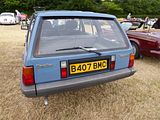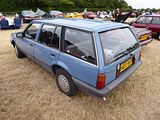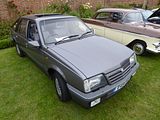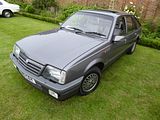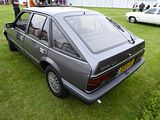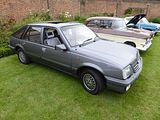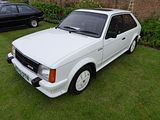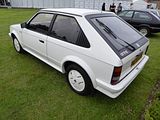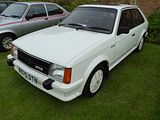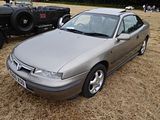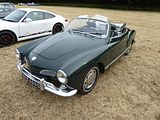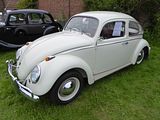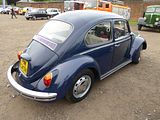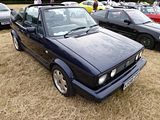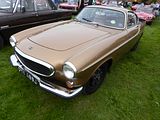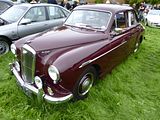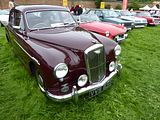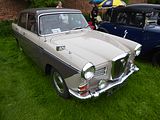I first went to the popular Classics in the Walled Garden event in 2012, having read glowing reports of its charm in Classic and Sports Car magazine, and I instantly saw the appeal. Taking advantage of the combination of summer weather and long evenings of daylight, this long running event is held at the Luton Hoo estate, a matter of minutes off junction 10 of the M1, and so accessible even to those who have started their day in London. The Walled Garden is a splendid setting, allowing for around 100 – 120 cars to park up on the grass, with ample space for the owners to set up an expansive evening picnic by their cars, which is precisely what many people do, but as with all good events, its popularity soon outgrew the space, with first an area immediately outside the Walls being brought into use and then a whole adjoining field. I understand that even with this extra capacity, places to attend and display your car get taken within a very short space of time after the “tickets” are released. Although there is ample space on site, some of which is used for those who, like me, just turn up to see everyone else’s cars, expanding it still further may change the atmosphere of what is still a very friendly and quite compact event. Officially, the event starts at 4pm, and people start to head off from around 7pm, with the last cars lingering until dusk, which in early July means around 9:30pm. I learned from the experience of attending back in 2012 and again from my second visit in 2014, that it pays to get there as early as possible. For 2016 I thought I was in with a good chance, as I managed to keep my diary decently empty for the late Wednesday afternoon, so even though I was starting out in central London, when my satellite navigation told me that I would be there at 5:15pm, it looked like I was going to get to see everything. Sadly, central London just clogged up around itself, and I got stuck moving a few hundred yards in more than an hour, with no way of escaping the traffic tangle. I actually got to the event at just before 7pm, hopeful that there would still be enough to see. Although a few cars had already left, there was still plenty, and so I had a less than relaxed hour, charging around the venue as fast as possible, trying to see as much as I could before the owners headed off. Here is what I saw:
ABARTH
Parked up towards the farthest part of the field was this splendid 1000TC.
ALFA ROMEO
Surprisingly, this seemed to be the only Alfa Romeo present. It is, of course, an S4, the final evolution of the long-running and popular 105 Series Spider which had first been seen in 1966 came in 1990. Mechanically, the biggest different was the use of Bosch Motronic electronic fuel injection with an electric fan. Externally, the Spider lost its front under-bumper spoiler and the rather ungainly rear boot spoiler of the S3, and picked up 164-style rear lights stretching across the width of the car as well as plastic bumpers the same colour as the car. This also marked the first generation of the car with automatic transmission, as well as on-board diagnostics capabilities. The car had remained in production largely thanks to continued demand in North America, though this market had to wait until 1991 for the changes to appear on their cars. European markets were offered a car with a 1600cc engine and carburettors as well as the 2 litre injected unit. Production finally ended in 1993, with an all new model, the 916 Series Spider appearing a year later. The S4 car was not officially sold in the UK, but plenty have found their way to our shores since then.
ALVIS
Looking very much at home in this quintessentially English setting was the oh-so-British Alvis. This is a TD21, which was conceived in 1956 and was quite a departure from the lovely, but rather “post-war” TC21. However, on its arrival in dealer’s showrooms, it quickly set about changing established views of the Alvis. Following the loss of coachbuilders Mulliner and Tickford (who were now tied to other companies), Alvis turned to the Swiss coachbuilder, Graber whose tradition of producing sleek, modern and very elegant saloons and dropheads proved a good fit in terms of the way Alvis saw their future. Graber first presented this new style to the Alvis board in late 1957 who were very impressed with the Swiss company’s flowing design and commissioned the body to be built on the new TD chassis. To ease logistical problems, Park Ward of London, built the Graber designed bodies in the UK. The Alvis Three Litre TD21 Series I was produced between the end of 1958 and April 1962, and was powered by the TC’s 2993 cc engine, uprated by 15bhp to 115 as a result of an improved cylinder head design and an increased compression ratio. A new four-speed gearbox from the Austin-Healey 100 was incorporated, while the suspension remained similar to the cars predecessor, independent at the front using coil springs and leaf springs at the rear, but the track was increased slightly and a front anti-roll bar added. From 1959 the all drum brake set up was changed to discs at the front retaining drums at the rear. In April 1962, the car was upgraded with four wheel Dunlop disc brakes in place of the disc/drum combination, aluminium doors, a five-speed ZF gearbox and pretty recessed spotlights either side of the grille, these improvements coming together to create the TD21 Series II. The car would be updated in 1963 to create the TE21, with its distinctive dual headlights proving a recognition point, and the later TF21, continuing in production until 1967 at which point Alvis ceased car manufacture
ASTON MARTIN
There were three examples of the DB6 here. the final model of the trio which started out with the DB4 of 1958. The DB6 was launched in 1965 as a replacement for the DB5 which had run since 1963. The wheelbase was now 4″ longer than before, resulting in an extensive restyle with a more raked windscreen, raised roofline and reshaped rear quarter windows. Opening front quarter lights made a reappearance, but the major change was at the rear where a Kamm tail with spoiler improved the aerodynamics, greatly enhancing stability at high speeds. “The tail lip halves the aerodynamic lift around maximum speed and brings in its train greater headroom and more luggage space”, declared Motor magazine, concluding that the DB6 was one of the finest sports cars it had tested. Famed employee, Tadek Marek, designed the six cylinder engine, which had been enlarged to 3,995cc for the preceding DB5 and remained unchanged. Power output on triple SU carburettors was 282bhp, rising to 325bhp in Vantage specification. Premiered at the 1965 London Motor Show, the DB6 Volante marked the first occasion the evocative ‘Volante’ name had been applied to a soft-top Aston Martin. After 37 Volante convertibles had been completed on the DB5 short wheelbase chassis, the model adopted the longer DB6 chassis in October 1966. A mere 140 DB6 based Volantes were manufactured, and of these only 29 were specified with the more powerful Vantage engine.
The next shape, penned by William Towns would live even longer in the Aston catalogue, from 1967 right through to 1990. Aston Martin’s customers had been clamouring for an eight-cylinder car for years, so Aston Martin designed a larger car. The engine was not ready, however, so in 1967 the company released the DBS with the straight-six Vantage engine from the DB6. Two years later, Tadek Marek’s V8 was ready, and Aston released the DBS V8. Though the body and name was shared with the six-cylinder DBS, the V8 sold for much more. The body was a modern reinterpretation of the traditional Aston Martin look, with a squared-off grille and four headlights (though some consider the styling derivative of the early Ford Mustang). Distinguishing features of the V8 model are the larger front air dam and lack of wire wheels, though some six-cylinder DBS cars also used the V8’s alloy wheels. The tail lights were taken from the Hillman Hunter. A road test report of the time noted that the car had gained 250 lb in weight with the fitting of the V8 in place of the previously used six-cylinder unit, despite the manufacturer’s assurance that the engine weighed only 30 lb more than the older straight-six. Other contributions to the weight gain included heavier ventilated brake discs, air conditioning, fatter tyres, a new and stronger ZF gearbox as well as some extra bodywork beneath the front bumper. Marek’s V8 engine displaced 5,340 cc and used Bosch fuel injection. Output was not officially released, but estimates centre around 315 hp. The DBS V8 could hit 60 mph in 5.9 seconds and had a top speed of nearly 160 mph. 402 DBS V8s were built. In April 1972, the DBS V8 became just the Aston Martin V8 as the six-cylinder DBS was dropped, leaving just this car and the six-cylinder Vantage in production. The V8 became known as the AM V8, a model retroactively referred to as the Series 2 V8 to separate it from later models. Visual differences included twin quartz headlights and a mesh grille, a front design which was to last until the end of production in 1989. AM V8 cars, produced from May 1972 through July 1973, used a similar engine to the DBS V8, albeit with Bosch fuel injection rather than the earlier carburettors. Just 288 Series 2 cars were built. Although David Brown had left the company, he had overseen development of this model. The first 34 cars still carried leftover “DBS V8” badging. The car switched back to Weber carburettors for the Series 3 in 1973, ostensibly to help the car pass new stricter emissions standards in California but most likely because Aston Martin was unable to make the Bosch fuel injection system work correctly. These cars are distinguished by a taller bonnet scoop to accommodate four twin-choke (two-barrel) Weber carbs. The car produced 310 hp and could reach 60 mph in 6.1 seconds with an automatic transmission or 5.7 with a manual. Performance suffered with emissions regulations, falling to 288 hp in 1976. The next year, a more powerful “Stage 1” engine with new camshafts and exhaust brought it up to 305 hp. Production of Series 3 cars lasted from 1973 through October 1978, but was halted for all of 1975. 967 examples were produced in this time. While earlier V8 cars have louvers cut into the little panel mounted beneath the rear windshield, the Series 3 and later cars instead have a small lip at the bottom of this panel, just ahead of the leading edge of the bootlid. The “Oscar India” specification was introduced in October 1978 at the Birmingham International Motor Show. Visually, the former scoop on the bonnet gave way to a closed “power bulge”, while a spoiler was integrated into the tail. Most Oscar India cars were equipped with a Chrysler “Torqueflite” three-speed automatic transmission, with wood trim fitted for the first time since the DB2/4 of the 1950s. Just 352 Oscar India models were built from 1978 through 1985. The power of the now de-smogged engines kept dropping on American market cars, down to a low of 245 hp in the early eighties. The convertible “Volante” was introduced in June 1978, but featured the Series 4 bonnet a few months before the coupé received the Oscar India update. The Volante Series 1 weighs 70 kg (155 lb) more than the coupé, due to the necessity of reinforcing the frame. By 1981, the success of the Volante meant that the coupé model was only built on individual demand. The fuel-injected Series 5 cars were introduced in January 1986 at the New York International Auto Show. The compact Weber/Marelli system no longer needed the space of the previous carburettors, so the bonnet bulge was virtually eliminated. 405 Series 5 cars were built before production ceased in 1989. The Volante Series 2 received the same changes; 216 were built.
AUDI
Nice to see a Quattro here. The idea for a high-performance four-wheel-drive car was proposed by Audi’s chassis engineer, Jörg Bensinger, in 1977, when he found that the Volkswagen Iltis could outperform any other vehicle in snow, no matter how powerful. Bensinger’s idea was to start developing an Audi 80 variant in co-operation with Walter Treser, Director of Pre-Development.. Following an unveiling on 1st March 1980, Audi released the original Quattro to European customers in late 1980, with the car featuring Audi’s quattro permanent four-wheel drive system (hence its name), and the first to mate four-wheel drive with a turbocharged engine. The original engine was the 2,144 cc in-line-5-cylinder 10 valve SOHC, with a turbocharger and intercooler. It produced 197 bhp propelling the Quattro from 0 to 100 km/h in 7.1 seconds, and reaching a top speed of over 220 km/h (137 mph). The engine was eventually modified to a 2,226 cc inline-5 10 valve, still producing 197 bhp, but with peak torque lower in the rev-range. In 1989, it was then changed to a 2,226 cc inline-5 20v DOHC setup producing 217 bhp, now with a top speed of 230 km/h (143 mph) Audi Quattros are referred to among owners and enthusiasts by their engine codes, to differentiate between the earlier and later versions: the earliest 2144 cc 10v being the “WR” engine, the 2226 cc 10v being the “MB” engine, and the later 20v being the “RR” engine. Hence, Quattro models may be referred to as either the WR Quattro, MB Quattro, and RR or “20v” Quattro, respectively. Quattro car production was 11,452 vehicles over the period 1980–1991,and through this 11 year production span, despite some touch-ups, there were no major changes in the visual design of the vehicle. For the 1983 model year, the dash was switched from an analogue instrument cluster, to a green digital LCD electronic instrument cluster. This was later changed in 1988 to an orange LCD electronic instrument cluster. The interior was redesigned in 1984, and featured a whole new dash layout, new steering wheel design, and new centre console design, the switches around the instrument panel were also redesigned at this time. In 1985 the dash changed slightly with harder foam and lost a diagonal stripe, the dash switches were varied slightly and the diff lock pull knob gave way to a two-position turning knob with volt and oil temp digital readouts. External styling received very little modification during its production run. Originally, the car had a flat fronted grille featuring four separate headlamp lenses, one for each of the low and high beam units. This was altered for the 1983 model year, and replaced with combined units featuring a single lens, but housing twin reflectors. This was changed again, for the 1985 model year, in what has become known as the ‘facelift model’ and included such alterations as a new sloping front grille, headlights, and trim and badging changes. Max speed was 124 mph. The RR 20v Quattro also featured a new three spoke steering wheel design, leather covering for door arm rests, gloveboxes, centre console and door pockets. There was also a full length leather-wrapped centre console running all the way to the rear seats. The 20v was also the first Ur-Q to have “quattro” script interior with partial leather seats. The floor on the drivers side had a bulge due to dual catalytic exhaust setup. The different models may be distinguished by the emblems on their boot lids: the WR had a vinyl ‘quattro’ decal or a brushed aluminium effect plastic emblem, the MB had chrome plated ‘audi’, ‘audi rings’ and ‘quattro’ emblems, whilst the RR had only chrome plated ‘audi rings’. The rear suspension was altered early on with geometry changes and removal of the rear anti-roll bar to reduce a tendency for lift-off oversteer. For the 1984 facelift, the wheel size went from 6×15-inch with 205/60-15 tyres to 8×15-inch wheels with 215/50-15 tyres. At the same time the suspension was lowered 20 mm with slightly stiffer springs for improved handling. For 1987, the Torsen centre differential was used for the first time, replacing the manual centre differential lock. The last original Audi Quattro was produced on 17 May 1991, more than two years after the first models of the new Audi Coupe range (based on the 1986 Audi 80) had been produced.
Second Audi here was an RS4 Avant of the B5 generation. This model dates from an era when Audi only produced one RS model at a time, meaning that the variant had quite a short production life. Introduced by Audi in late 1999, for main production and sale from 2000, this was effectively the successor to the Porsche / quattro GmbH joint venture-developed Audi RS2 Avant that was sold in the mid 1990s. Like its RS2 predecessor, it was available only as an Avant. Although related to the Audi B5 S4, many of the outer body panels were altered, with wider front and rear wheel arches, to allow for the wider axle track on the RS 4. With unique front and rear bumpers and side sills, and the rear spoiler from the S4 Avant, the aerodynamic modifications achieved a drag coefficient of Cd 0.34 and a very purposeful look, especially when finished in a sober colour such as the two examples seen here. It was the mechanical changes, though, which had the huge difference. The engine was developed from the 2.7 litre V6 ‘biturbo’ used in the B5 S4, and retained the same 2,671 cc capacity, but much was changed. Developed and manufactured in the UK by Cosworth Technology, it featured enlarged intake and smaller exhaust ports on the two Cosworth cast aluminium alloy cylinder heads, two parallel BorgWarner turbochargers, two larger side-mounted intercoolers, dished piston crowns, stronger connecting rods, larger intake ducting, enlarged exhaust system, and a re-calibrated engine management system. The modifications increased the engine’s output from 265 bhp to 375 bhp at 7,000 rpm, and with 325 lb/f·ft of torque. The engine was controlled by a Bosch Motronic ME 7.1 electronic engine control unit (ECU), using a Bosch ‘E-Gas’ electronic drive by wire throttle. The engine had multipoint sequential fuel injection, a MAF, six individual single-spark coils and NGK longlife spark plugs. The engine oil was cooled by a dual oil:water cooler and an oil:air cooler. There was a 6 speed manual transmission and Audi’s Torsen-based quattro system. Even with a kerb weight of 1,620 kilograms (3,571 lb), the RS 4’s powerful engine gave it the performance of a sports car. 100 km/h could be reached from rest in 4.9 seconds, 160 km/h in 11.3 seconds, and 200 km/h in 17.0 seconds. Top speed was electronically limited to 262 km/h(162.8 mph) Audi produced 6,030 units between 1999 and 2001.
AUSTIN
This pair of Austin Six models have been at the event every time I’ve been, always parked together, and always looking very imposing. Branded Six, as they had six cylinders, which must have been confusing when the car that was branded Seven was so named because of its HP rating, these cars were actually 16HP models. Known in full as the Austin Sixteen Light Six, the model was announced in October 1927, with first deliveries taking place in March 1928. To distinguish the car from the smaller engined models in the range a plated Austin Six script was fixed to the radiator grille. This was an upper- medium sized saloon sitting within Austin’s range above the Seven and Twelve models but still much smaller than the 3.6 Litre Twenty. The six-cylinder engine was new but had similarities to the engine fitted to the Twenty with its timing chain at the rear of the block. The design was up to date with the gearbox mounted in-unit with the engine and semi elliptic springs all round for the suspension. Triplex safety glass was fitted to all front screens from March 1929. A wide range of body types was available at first but was simplified over the years. The coupés went first in 1930 followed by the Weymann type fabric saloons in 1931. In August 1933 various improvements were announced for 1934 models. The gearbox gained synchromesh on 3rd and 4th gears and an alternative larger (2511 cc) 18 hp engine was made available at no extra charge. An early automatic gearbox was available between 1934 and 1936 but few sold. A longer 120 inch wheelbase chassis became an option. Further upgrades were made in 1935. The body range was simplified and now had only the 5 and 7 seat saloons. Externally the most obvious change was to the radiator surround which was painted body colour rather than chrome plated, and a small external boot was added to the rear which contained the spare wheel. Synchromesh was added to second gear. The larger engine was modified to have only four rather than eight main bearings. In 1937, the last year this car was made, the smaller engined Sixteen was dropped and pressed steel road wheels replaced the previously fitted wire wheels. Between 1935 and 1937 12,731 were produced. The two cars seen here show an example of the earlier and later styles, the later being a York.
Much smaller than the Six was the Seven, two examples of the Ruby version of which were also parked together, elsewhere on site, as well as an earlier Saloon model.
A real period piece was this A90 Atlantic. Launched initially as a four-seat convertible, making its début at the 1948 Earls Court Motor Show in London, with production models built between spring 1949 and late 1950, the range was later augmented when a two-door coupé, marketed as the A90 Atlantic Sports Saloon, followed a year later. It had been previewed at the 1949 Motor Show and was in production at Longbridge between 1950 and 1952. The Atlantic was one of the first post-war cars engineered from scratch by Austin, and was said to be styled from a thumbnail sketch by Leonard Lord, then Chairman of Austin, though in truth the styling was more likely the work of resident Italian Austin stylist Dick Burzi. The car was almost certainly influenced by a 1946 Pininfarina-bodied Alfa Romeo cabriolet, which just happened to end up at the Longbridge factory in mid-1947, a few months before the light blue 16 hp sports prototype made its first appearance in the experimental department and on nearby roads around the factory. A rare edition was a coachbuilt estate car, regularly seen in the 1950s used by a convent in Leith, Scotland. The car had a lifting rear door, and sported then unusual curved perspex roof panels. With the then Government edict of “Export or die” and steel allocated only to those who generated much needed dollar revenue, the Atlantic was designed specifically to appeal to North American tastes (certain aspects look like a 1949 Mercury and the bonnet brightwork looks similar to the Pontiac Chieftains of this era). The car featured up-to-the-minute detailing, with a wrap around windscreen, composed of a flat glass centre section with, tiny curved end panels. The front wings (fenders) sported twin ‘Flying A’ hood ornaments and swept down to a rounded tail, with spats enclosing the rear wheels. A centrally mounted third, main beam, headlight was built into the letter-box style air intake grille, and the then unheard of luxury of hydraulically powered windows and hood (convertible top), “flashing indicators” rather than trafficators, (for the United States market at least) and the option of EKCO or HMV Autocrat radios. The range-topping Austin was offered in a variety of “jewelescent” colours with names like ‘seafoam green’ and ‘desert gold’ but few of these brave new metallics were sold in the UK market. The convertible, a three window, drophead coupe had a simple fabric top, without rear quarter lights, which butted up to the rear of a rather thick windscreen header rail. The fixed head, five window, Sports Saloon, could be had with its roof painted or covered in fabric. This gave it the popular ‘drophead or cabriolet’ look; all the style with no leaks. Many photographs of this car are wrongly titled, due to observers confusing the fabric covered hardtop for a convertible. As its final party trick, the centre section of the three piece, wrap-around, rear window, could be lowered into the boot, for added ventilation by a remote winder above the front windscreen. Few people in the car’s native Britain would have ever seen anything like the futuristically-styled Atlantic before, and certainly not from a conservative mainstream manufacturer like Austin. The radical Atlantic suffered, however, from the dramatically new Jaguar XK120, also launched at the 1948 Motor Show. Out of a total production run of 7,981, 3,597 were exported, 350 of which were to the US. This low level of sales in the US was despite a huge focus by Austin, including a successful attempt at breaking 63 stock car records at the Indianapolis Motor Speedway in April 1949 by Alan Hess, Charles Goodacre and Dennis Buckley) and a US$1000 price reduction in 1949, the four-cylinder 2.7-litre couldn’t compare in power output to native V8 engines — although, for its time, performance was strong. A few were also used in civilian versions of the Austin Champ. The car did see more success in former British Colonies, Europe, Scandinavia and Australasia.
There was a nice progression of medium sized Austins which sold strongly to family buyers. Oldest of these was the A40 Somerset. A rival to the Morris Oxford and Hillman Minx in the early 1950s, it was launched in 1952, as a replacement for the A40 Devon and Dorset. Only made until 1954, it looked bigger than its predecessor, though that was largely an illusion of the new appearance which was somewhat “Transatlantic” in style with flowing lines, intended to increase the car’s appeal to export markets. The Somerset bore a close resemblance with the larger Austin A70 Hereford, and telling the two apart at glance is no easier than some of today’s cars where people think that the same styling went under the “reduce” or “enlarge” buttons! The Somerset shared a number of components with its earlier sibling which included a similar 1.2 litre straight-4 pushrod B series engine, but updated to produce 42 hp, compared to the Devon’s 40 hp, giving the car a top speed of 69 mph. Stopping it was done with hydraulic brakes. The Austin A40 Somerset’s reputation for being somewhat slow and lumbering to drive is not wholly deserved. The vehicle had to endure poor quality petrol supplies and in consequence had retarded ignition settings to tolerate the low octane rating of this poor fuel grade to avoid the ‘pinking’ condition that was well known in those times. In fact BMC later produced a kit to improve the performance and fuel consumption of these cars once premium fuel supplies resumed under the popular petrol brands. This kit comprised a replacement distributor and an optional head gasket for the cylinder head that was thinner and therefore raised the compression slightly from the standard 7.2:1. An Autocar magazine road test published 18 April 1952 achieved a maximum of 66 mph and a 0-60 mph acceleration of 36.6 seconds whereas the example registered new in February 1954 and given a Used Car Test published in the Autocar series dated 8 April 1960 returned a 0-60 mph time of just 27.9 seconds. The standing quarter mile was down from 24.4 secs to 23.2 secs a marked improvement on the former result taken in 1952 and directly comparable with the Mini 850 launched in 1959, that was considered to be fairly brisk then. There were two close fitting front seats which could be arranged as a bench seat, with space freed up by virtue of the four speed column mounted gear change. The Somerset was initially offered only as a 4-door saloon, with a 3-passenger 2-door convertible, of the same body shape, introduced in late 1952. The body for the convertible was made by Carbodies of Coventry and the model was marketed as the Austin A40 Somerset Coupé. The convertible differed from the saloon in having separate front seats that folded forward to give access to the rear. The Austin Motor Company in 1953 made a “special” version of around 500 Somerset saloons with a more powerful engine, different interior appointments and two-tone paintwork. The Austin Somerset Special had a top speed of 74 mph. Over 173,000 were sold before the Somerset was replaced by the A40 Cambridge in 1954. 7243 of them were convertibles.
In September 1954, Austin dusted off the Cambridge name that they had used on some of their Ten models in the late 1930s, and applied it to a new pairing of A40 and A50 models which replaced the Somerset. The A40 and A50 Cambridge models were entirely new, with modern unibody construction and new styling with integrated wings and a full width grille which was initially quite rounded, though a facelift in 1957, creating the first A55 changed that somewhat, before the more significant new look came in 1959 with the Farina styled cars. Initially the Austin Cambridge was only offered with a 4-passenger, 4-door saloon body, although a few pre-production 2-door models were also made. A van derivative introduced in November 1956 and a pick up that followed in May 1957 remained available until 1974. The A40 had a 1.2 litre straight-4 pushrod engine B-Series engine based on the one used in the previous Austin Somerset, although sharing no parts. A maximum power output of 42 bhp was claimed, transmitted to the wheels by means of a four-speed gear box controlled with a column-mounted lever. Only 30,666 A40 Cambridge models were produced, as it was the A50 version of the Cambridge, introduced at the same time, but with a new 1489 cc B-Series four-cylinder engine with single Zenith carburettor which was good for 50 hp which would prove far more popular . It sold better and remained in production through to 1957 with 114,867 A50s being produced The de luxe version had a heater, leather seat facings, carpets replacing the standard rubber matting, armrests on the doors, twin-tone horns, a passenger sun visor, and some extra chrome including overriders. Technical advances in the A50 Cambridge included an optional Borg-Warner overdrive unit for the top three (of four) gears. A semi-automatic transmission (branded “manumatic” and providing pedal-free clutch operation) was also offered, but it was unpopular with buyers. A number of modifications were introduced in October 1956 including smaller 13 in wheels and increased compression ratio (8.3:1). A de luxe version tested by The Motor magazine in 1955 had a top speed of 73.6 mph and could accelerate from 0–60 mph in 28.8 seconds. A fuel consumption of 28.0 mpg was recorded. The test car cost £720 including taxes. Austin updated the model in 1957 with new styling front and rear and a more powerful engine, creating the A55 Cambridge.
Follow on to the A55 Cambridge was another car called A55 Cambridge, but whereas the first had been unique to Austin in its design, the A55 Cambridge Series 2 was one of the range of cars produced by BMC which came to be known as the “Farina” saloons. The concept goes back to the the mid 1950s, by which time the BMC organisation was well established, and it dominated the UK market with a 39% share. Plans were made for a complete new range of cars that would encompass all the marques: Austin, Morris, MG, Riley and Wolseley. Italian stylist Pininfarina was commissioned to design them. The first model to appear was the A40, launched early in 1958. Whilst that car was only ever sold with Austin badges, the next of Pininfarina’s designs to appear would go on to be sold with each of the 5 marque’s badges attached. These upper-medium sized family cars were released over a period of months, starting in late 1958 with the Wolseley 15/60. This was followed by the A55 Cambridge Mark II, the Morris Oxford Series V, the MG Magnette Series III and the Riley 4/68. The same basic body style was applied to all, with just trim differences, and in the case of the MG and Riley, more powerful engines thanks to a twin carburettor set up under the bonnet, introducing the world to the concept of “badge engineering”. Whilst the styling was something of an amalgam of Italian glamour and a touch of Americana, with prominent tail fins, under the skin the cars were very conventional. Whilst some may have been disappointed that BMC had not been more adventurous, this was an era when home car maintenance was an established part of the suburban landscape, so simplicity was not completely unwelcome. The familiar 1.5-litre B-Series engine, four-speed manual and straightforward rear-wheel drive gave it solid appeal to many middle-class buyers, especially those horrified by the black magic of the newly launched front-drive Mini. All 5 cars were four-door saloons, with estate versions of the Austin and Morris being added to the range a few months later. A facelift was applied to them all in late 1961, when the tail fins were toned down and an enlarged 1622cc B Series engine found its way under the bonnet, with more power, new names came in for the Wolseley which became the 16/60 and the Austin which adopted the A60 Cambridge name. It was an A60 Cambridge which was represented here.
A rare sight these days, this was a nice example of the Maxi, seen in 1750 guise in the period colour of Harvest Gold. Developed in the mid 60s, the ADO15 was intended to plug the gap between the ADO17 Austin/Morris 1800 cars and the volume selling 1100/1300 cars, providing BL with a much needed competitor for the Mark 2 Cortina, which, along with the Escort had helped to grow Ford’s market share in the UK, mostly at BL’s expense. Long in gestation, as was not uncommon at the time, the new car eventually made its debut as the Maxi on 1st May 1969. Promoted as the “5 of everything” car, it had 5 doors, 5 gears (both unusual in the market in those days) as well as 5 seats. It also featured a brand new engine, the 1500cc E Series, which was not really up to the task and it was saddled with what by common consent was one of the most recalcitrant gearchanges ever inflicted on a production car, with a lever operated by rods which had to be carefully lined up to persuade the next gear to engage. That aside, the car had huge potential and a vast amount of space in a footprint that measures less than 14 feet in length. A revised version was launched in the autumn of 1970, with a cable operated gearchange and the option of a more powerful and torquey 1750cc engine. Sadly, apart from adding the twin carburettor HLS version to the range in 1972, that was about all that BL did to the design in the next 10 years. Talk about starving a model of its full potential. The last few cars were branded Series 2 and had new bumpers and interior trim, but that was about it. The format was right, as evidenced by the fact that all major manufacturers moved to something similar in the 1970s, but the execution lacked the final polish and sales were limited in the UK and negligible anywhere else. What a wasted opportunity!
Final Austin here was an Allegro Estate. What can be said about the Allegro that has not already been aired? Codenamed ADO67, the car was launched on 15th May 1973, as a replacement for the ADO16 range, which had for many years been Britain’s best seller. A BL management who managed to combine arrogance with naivete and a certain lack of vision confidently asserted that the Allegro would continue in this position at the top of the sales charts. It did not. Build quality of the early cars was random, and frequently plain unacceptable, and despite being bigger than the car that it replaced, there was no more space in it. But the Series 2 models, which arrived in the Autumn of 1975 fixed that offering up to 6″ more legroom, and with better quality trim, and a conventional round steering wheel rather than the unusual Quartic one of the launch cars, the reality is that the Allegro was rather better than its reputation then (and now) would suggest. For sure, it was somewhat outclassed by the VW Golf, but that was considerably more costly model for model, but there were several aspects where it could match or beat an Escort or a Viva. The E series engined 1500 and 1750 cars, with standard 5 speed gearboxes were never as popular as imagined, the market not really being ready for the idea of a large engined small car, but anyone who did buy a 1750SS or the later HL had a very brisk car indeed on their hands. By the late 70s, with a whole slew of much newer models on offer from every single competitor, the car, although better built and with a nicer interior finish, was simply too old fashioned for most people. It is testament to marketing and the skills of the dealers that the car continued to sell into the Eighties in the volumes that it did. Although most were relieved that the car was replaced by the much more competitive Maestro, and everyone assumed that the car would fade – probably quickly given the build quality – into obscurity, but a group of enthusiasts founded an Owners Club long before there was one for most marques, and they figured out how to keep the remaining cars on the road. Estate models like this one are rare.
BEDFORD
This OLB Lorry dates from 1952. One of the “O” Series Bedfords, that shared its distinctive front end with the well known OB Bus that first appeared in 1939, and produced in small numbers before the War intervened and then again unchanged post War until 1951, the O Series trucks were one of three series of that the Luton manufacturer introduced to meet the haulage needs of its customers. Each was a 2-axle vehicles with a separate bonnet, and they were called “K”, “M” and “O”. The K Series had a carrying capacity of 1.5-2.0 tons, and had a a standard wheelbase of 3050mm, while the “M” Series could carry 2 – 3 tons and were offered with two wheelbases of 3050 mm and 3630., and the largest, the “‘O” could haul 3 – 5 tons and came in 13 different designs, also with two wheelbase lengths. They all used the same 6-cylinder engine which generated a heady 72 hp, coupled to a 4-speed transmission, and had leaf-spring suspension and hydraulic brakes. Models with a carrying capacity of 3 tons used a vacuum brake booster. The vehicles were adapted for military use during the War and then production resumed after the cessation of hostilities, with the “O” Series now offered in OLA and OLB versions, differing in haulage capacity. The design was finally retired in 1953.
BENTLEY
Oldest Bentley here was a splendid 4.5 litre supercharged model, surely the “supercar” of its day.
More familiar were a couple of Bentleys from what we should now think of as the renaissance period, when sales started to outnumber those of the Rolls Royce by some margin. More common of the two was the Mulsanne, the Bentley version of the Silver Spirit. Taking its name from Bentley’s motorsport history, which included five victories at the 24 Hours of Le Mans between 1924 and 1930 — the ‘Mulsanne Straight’ being the stretch of the Le Mans racecourse where cars reach their highest speeds – the car was launched in October 1980, sharing the traditional 6750 cc Rolls-Royce V8 with aluminium alloy cylinder heads with the Silver Spirit. Things got more interesting at the Geneva Motor Show in 1982 when Bentley announced the Mulsanne Turbo, which had a 50% increase in power thanks to the Garrett AiResearch turbocharger. There was the usual highly polished walnut veneered fascia, blemish-free leather and carpets and headlining of pure wool for the interior. 498 short wheelbase and 18 long wheelbase Mulsanne Turbos were built in the following three years. The Mulsanne Turbo was replaced by the Turbo R, which used a fuel injected version of the same engine. A British racing green Turbo has been used in the two James Bond stories Nobody Lives Forever and Role of Honour by John Gardner. The Mulsanne needed a refresh by 1987, so the company spiced it up with the introduction of the Mulsanne S. Although this model lacked its turbocharger, many of its other details were similar to the Turbo R, including that car’s alloy wheels and interior, and the suspension was firmed up for a more sporting ride. The rectangular headlamps from the 1980s gave way to quad round units for 1989, and the model lasted until 1992. It is a Mulsanne S that was seen here.
The success of the Mulsanne Turbo and Turbo R brought new life to Bentley, changing the position of the preceding 15 years where sales of the marque’s badge-engineered Rolls Royce cars had been only a very small percentage of the company’s sales. The obvious next step would be further to enhance the distinctive sporting nature of the Bentley brand and move away from a Bentley that was merely a re-badged Rolls Royce. Bentley appointed stylists John Heffernan and Ken Greenley to come up with ideas for a new, distinctive, Bentley coupé. The fibreglass mock up was displayed at the 1984 Geneva Motor Show in Rolls-Royce’s “Project 90″ concept of a future Bentley coupé. The concept was met with an enthusiastic reception, but the Project 90 design was largely shelved as the company began to work towards a replacement for the Rolls-Royce Corniche. During this process, Graham Hull, chief stylist in house at Rolls Royce, suggested the designs before the board for the Corniche, would suit a Bentley coupé better. From this point it was decided the Corniche could continue as it was, and efforts would once again be channelled into a new Bentley coupé. In 1986 Graham Hull produced a design rendering of a new Bentley coupé which became the Continental R. Based on the Rolls Royce SZ platform (which was an evolution of the SY platform), an aerodynamically shaped coupé body had been styled. John Heffernan and Ken Greenley were officially retained to complete the design of the Continental R. They had run the Automotive Design School at the Royal College of Art and headed up their own consultancy, International Automotive Design, based in Worthing, Southern England. Greenley and Heffernan liaised constantly throughout the styling process with Graham Hull. The interior was entirely the work of Graham Hull and the small in house styling team at Rolls Royce. The shape of the car was very different from the somewhat slab sided four door SZ Rolls-Royce and Bentley vehicles of the time and offered a much improved 0.37 coefficient of drag. The Continental R also featured roof-cut door frames, a necessity to allow easier access into the car which had a lower roof line than its 4-door contemporaries. A subtle spoiler effect was also a feature of the rear. The finished car is widely acknowledged as a very cleverly styled vehicle, disguising its huge dimensions (The Continental R is around 4” longer than a 2013 long wheelbase Mercedes S Class) and a very well proportioned, extremely attractive, car. The “Continental” designation recalls the Bentley Continental of the post-war period. The “R” was meant to recall the R Type Bentleys from the 1950s as well as the Turbo R of the 1980s and 90’s where the “R” refers to “roadholding”. 1504 Continental R and 350 Continental T models were made before production finally ceased in 2003. The revival of the Bentley marque following the introduction of the Bentley Mulsanne Turbo, and then the Continental R, is widely acknowledged to have saved Rolls Royce Motor cars and formed the groundwork which led to the buyout and parting of the Rolls Royce and Bentley brands in 1998. Bentley was once again capable of standing alone as a marque in its own right.
CATERHAM
The Caterham story is one of continual development, a four decade process of honing Colin Chapman’s original design, which is now 60 years old. Since 1973, when Graham Nearn’s Caterham cars took over the rights and manufacture of the fly-weight sportscars, it’s grown more power, better engines, more sophistication in both suspension and powertrains, as well – in some cases – as more space inside and certainly more creature comforts, all while preserving the original character. Caterham completed 42 of the heavier and not that well thought of Series 4 cars before deciding to concentrate on the classic Series 3 design, with a simple space frame chassis clothed in aluminium and glassfibre. At the time of the S3, the power unit was from Ford, with the Crossflow unit developing 84 bhp in GT form with a twin choke carburettor, though twin Webers were never far away. Sevens had started out with Ford side valve power, before the 948cc BMC A Series unit found its way into the car, followed by Ford’s new 1340cc and 1498cc engines, before the head redesign put the intake and the exhaust on opposite sides. When Ford discontinued the Kent engine in 1976, it caused something of a difficulty for Caterham, as this also meant the end of the Twin Cam and the BDR engines, of which Caterham had bought 500 in preceding years, and whilst the final pushrod engines came from South Africa, eventually the supply ran out and a new supplier was needed. At first the firm turned to Vauxhall’s 2 litre unit for the higher powered cars but when the found out that Rover were developing a new and sophisticated twin cam engine, which turned out to be the K Series unit, a deal was struck and the first K Series engined Caterhams appeared in 1991, once the multi-point injection version was available (the single point would have required a bonnet bulge which Caterham did not want). To get round the relative lack of torque, Caterham developed their own close ratio 6 speed gearbox which was lighter than the Ford unit they had been using, and which could cope with larger capacity and more powerful K Series units as Rover made them available. Caterham continued to develop the car throughout the 190s, starting to make their own steering racks among other changes. By the time the K Series and the 240 bhp Vauxhall engines in the HPC car came along, the interior had become plusher with a long cockpit option and a wider variant, the SV. There were now proper bucket seats instead of those with a plywood backrest and in 1996 the handbrake moved from under the dash to the transmission tunnel. This required extra tubing in the chassis, which made it 80% stiffer. The front suspension had gained a proper top wishbone and separate anti-roll bar, but the biggest change came with the adoption of de Dion rear suspension. The move was occasioned by a need to keep the rear wheels linked and parallel to each other, yet still as simple as possible, though the engineers harboured a desire for a fully independent rear end, which finally came about with the CSR version in 2004. This change improved the ride massively on bumpy roads and makes the car feel more planted. The collapse of Rover in 2005 meant the end for the K Series, so there was a switch back to Ford power, using the Sigma engine, which happily fits under the bonnet – something that few modern engines do as they are now often simply too tall. Adding more power is a law of diminishing returns with a Caterham, thanks to the aerodynamics, though there are now an array of different power outputs offered, but the most recent change was a new entry level model, which uses a 660cc Suzuki turbo triple, with a live axle and a similar power to weight ratio to the classic single carb Ford powered models of 30 years ago. However, these days you can get carpets, leather seats and full weather gear if you upgrade to an S pack. Caterham plan to continue to develop the car for as long as they can. To date they have built around 16,000 examples, and it is said that were you to gather 100 models together, you would not find two the same, even though, colour apart, many cars looks very similar at a quick glance.
CHEVROLET
65 Impala SS 2 door coupe
CITROEN
There were three 2CVs here. all of them the popular Charleston version which was initially introduced as a limited edition model, but which proved so popular that it became a permanent fixture of the range for several years. Both the available colour schemes were represented here.
CROSSLEY
Not a marque that is familiar to many people these days, this 1931 Crossley Golden is one of three known survivors of the specific model, Costing £575, the Crossley Golden was introduced in 1931 and the Super Six in 1929 as a replacement for the 20.9 and continued until 1935. The main changes, introduced with the Golden, were a revised chassis (similar to the Silver) improved brakes and a central gear change. The radiator shell was updated and wire wheels replaced the artillery type used on the earlier cars. Changes were made during production and the Autocar magazine noted that for 1933 the Golden would have “a slight variation in the contour of the saloon roof designed to smarten the appearance while the body height to the ground has been reduced two inches”. The Super Six “has been improved by the use of discs for the wheels and the addition of bumpers fore and aft. A folding centre armrest has been introduced for the rear seat.” At the 1930 London Motor Show a prototype six wheeled limousine was shown. This used a 3440 cc version of the engine (the bore was enlarged to 78mm) with transmission and chassis based on the military/commercial vehicles. In 1929 a six wheel open car had been produced with bodywork by Barker as a special order for King George V who at the time was still recovering from illness but wished to resume shooting expeditions but this new vehicle was considerably more luxurious. It is not known if more than the prototype was made but production must have been intended as a brochure was produced. It is estimated that only 100 were made.
DAIMLER
Launched late in 1962, the Daimler V8 Saloon was essentially a rebadged Jaguar Mark 2 fitted with Daimler’s 2.5-litre 142 bhp V8 engine and drive-train, a Daimler fluted grille and rear number plate surround, distinctive wheel trims, badges, and interior details including a split-bench front seat from the Jaguar Mark 1 and a black enamel steering wheel. Special interior and exterior colours were specified. Most cars were fitted with power-assisted steering but it was optional. Automatic transmission was standard; manual, with or without overdrive, became an option in 1967. The 2.5 V8 was the first Jaguar designed car to have the Daimler badge. A casual observer, though not its driver, might mistake it for a Jaguar Mark 2. The Daimler’s stance on the road was noticeably different from a Mark 2. In April 1964 the Borg-Warner Type 35 automatic transmission was replaced by a D1/D2 type, also by Borg-Warner. A manual transmission, with or without an overdrive unit usable with the top gear, became available on British 2.5 V8 saloon in February 1967 and on export versions the following month. Cars optioned with the overdrive had the original 4.55:1 final drive ratio. In October 1967, there was a minor face-lift and re-labelling of the car to V8-250. It differed only in relatively small details: “slimline” bumpers and over-riders (shared with the Jaguar 240/340 relabelled at the same time), negative-earth electrical system, an alternator instead of a dynamo and twin air cleaners, one for each carburettor. Other new features included padding over the instrument panel, padded door cappings and ventilated leather upholstery, reclinable split-bench front seats and a heated rear window. Power steering and overdrive were optional extras. Jaguar replaced its range of saloons—the 240, the 340, the 420, and the 420G—with the XJ6 at the end of 1968. The company launched the XJ6-based Daimler Sovereign the following year to replace the Daimler saloons—the 240-based V8-250 and the 420-based Sovereign. Henceforth all new Daimlers would be re-badged Jaguars with no engineering links to the pre-1960 Daimlers.
This is one of those rebadged Jaguars, a Sovereign 4.2 Series 1. Only the fluted radiator grille and trim over the rear number plate as well as the badging tel you that it is a Daimler and a Jaguar. In all other respects, the cars were identical.
FERRARI
There’s always a strong presence here from some of the local members of the Ferrari Owners Club. I assume that they all arrive in convoy, as the cars are always parked together in a neat line, and this year was no exception, with several models here from the last 35 years. Oldest of them was a 308GTS.
Stung by the criticism of the 348, Ferrari undertook a comprehensive revision, creating the F355 model which they launched in May 1994. An evolution of the Ferrari 348, just about everything was changed, and improved. Design emphasis for the F355 was placed on significantly improved performance, but driveability across a wider range of speeds and in different environments such as low-speed city traffic was also addressed, as the Honda NS-X had proved that you could make a supercar that could be lived with every day. Apart from the displacement increase from 3.4 to 3.5 litres, the major difference between the V8 engine in the 348 and F355 was the introduction of a 5-valve cylinder head. This new head design allowed for better intake permeability and resulted in an engine that was considerably more powerful, producing 375 hp. The longitudinal 90° V8 engine was bored 2mm over the 348’s engine, resulting in the small increase in displacement. The F355 had a Motronic system controlling the electronic fuel injection and ignition systems, with a single spark plug per cylinder, resulting in an unusual 5 valves per cylinder configuration. This was reflected in the name, which did not follow the formula from the previous decades of engine capacity in litres followed by number of cylinders such as the 246 = 2.4 litres and 6 cylinders and the 308 of 3.0 litres and 8 cylinders. For the F355, Ferrari used engine capacity followed by the number of valves per cylinder (355 = 3.5 litres engine capacity and 5 valves per cylinder) to bring the performance advances introduced by a 5 valve per cylinder configuration into the forefront. 5. The frame was a steel monocoque with tubular steel rear sub-frame with front and rear suspensions using independent, unequal-length wishbones, coil springs over gas-filled telescopic shock absorbers with electronic control servos and anti-roll bars. The car allows selection between two damper settings, “Comfort” and “Sport”. Ferrari fitted all road-going F355 models with Pirelli tires, size 225/40ZR 18 in front and 265/40 ZR 18 in the rear. Although the F355 was equipped with power-assisted steering (intended to improve low-speed driveability relative to the outgoing 348), this could optionally be replaced with a manual steering rack setup by special order. Aerodynamic designs for the car included over 1,300 hours of wind tunnel analysis. The car incorporates a Nolder profile on the upper portion of the tail, and a fairing on the underbody that generates downforce when the car is at speed. These changes not only made the car faster but also much better to drive,m restoring Ferrari to the top of the tree among its rivals. At launch, two models were available: the coupe Berlinetta and the targa topped GTS, which was identical to the Berlinetta apart from the fact that the removable “targa-style” hard top roof could be stored behind the seats. The F355 would prove to be last in the series of mid-engined Ferraris with the Flying Buttress rear window, a lineage going back to the 1965 Dino 206 GT, unveiled at the Paris Auto Show. The Spider (convertible) version came later in the year. In 1997 the Formula One style paddle gear shift electrohydraulic manual transmission was introduced with the Ferrari 355 F1 adding £6,000 to the dealer asking price. This system promised faster gearchanges and allowed the driver to keep both hands on the steering wheel, It proved to be very popular and was the beginning of the end for the manual-transmission Ferrari. Ferrari produced 4,871 road-going Berlinetta models, of which 3,829 were 6-speed and 1,042 were F1 transmissions. The Spider proved to be the second-most popular F355 model, with a total production of 3,717 units, of which 2,664 were produced with the 6-speed transmission and another 1,053 produced with the F1 transmission. A total of 2,577 GTS models were produced, with 2,048 delivered with the 6-speed transmission and another 529 with the F1 transmission. This was the last GTS targa style model produced by Ferrari. This made a total production run of 11,273 units making the F355 the most-produced Ferrari at the time, though this sales record would be surpassed by the next generation 360 and later, the F430.
It was with the 360 Modena that sales of Ferrari models really took off, with unprecedented volumes of the car being sold. The 360 Modena was launched in 1999, named after the town of Modena, the birthplace of Enzo Ferrari. A major innovation in this all new model came from Ferrari’s partnership with Alcoa which resulted in an entirely new all-aluminium space-frame chassis that was 40% stiffer than the F355 which had utilised steel. The design was 28% lighter despite a 10% increase in overall dimensions. Along with a lightweight frame the new Pininfarina body styling deviated from traditions of the previous decade’s sharp angles and flip-up headlights. The new V8 engine, common to all versions, was of 3.6 litre capacity with a flat plane crankshaft, titanium connecting rods and generates 400 bhp Despite what looks like on paper modest gains in reality the power to weight ratio was significantly improved on over the F355, this was due to the combination of both a lighter car and more power. The 0 to 100 km/h acceleration performance improved from 4.6 to 4.3 seconds. The first model to be rolled out was the 360 Modena, available as a manual, or an F1 electrohydraulic manual. Next up was an open car. The 360 was designed with a Spider variant in mind; since removing the roof of a coupe reduces the torsional rigidity, the 360 was built for strength in other areas. Ferrari designers strengthened the sills, stiffened the front of the floorpan and redesigned the windscreen frame. The rear bulkhead had to be stiffened to cut out engine noise from the cabin. The convertible’s necessary dynamic rigidity is provided by additional side reinforcements and a cross brace in front of the engine. Passenger safety is ensured by a strengthened windscreen frame and roll bars. The 360 Spider displays a curvilinear waistline. The fairings imply the start of a roof, and stable roll bars are embedded in these elevations. Due to use of light aluminium construction throughout, the Spider weighs in only 60 kg heavier than the coupé. As with the Modena version, its 3.6 litre V8 with 400 bhp is on display under a glass cover. The engine — confined in space by the convertible’s top’s storage area — acquires additional air supply through especially large side grills. The intake manifolds were moved toward the center of the engine between the air supply conduits in the Spider engine compartment, as opposed to lying apart as with the Modena. In terms of performance, the 0-60 mph time was slightly slower at 4.4 seconds due to the slight weight increase, and the top speed was reduced from 189 to 180 mph. Despite the car’s mid-mounted V8 engine, the electrically operated top is able to stow into the compartment when not in use. The convertible top was available in black, blue, grey and beige. The transformation from a closed top to an open-air convertible is a two-stage folding-action that has been dubbed “a stunning 20 second mechanical symphony”. The interior of the Spider is identical to that of the coupé. Both body styles were here.
An all new design, the 458 Italia was first officially unveiled at the 2009 Frankfurt Motor Show. Once more, Ferrari advised that the model incorporated technologies developed from the company’s experience in Formula 1. The body computer system was developed by Magneti Marelli Automotive Lighting. The 458 came with a 4,499 cc V8 engine of the “Ferrari/Maserati” F136 engine family, producing 570 PS ( 562 hp) at 9,000 rpm and 540 N·m (398 lb/ft) at 6,000 rpm with 80% torque available at 3,250 rpm. The engine featured direct fuel injection, a first for Ferrari mid-engine setups in its road cars. The only transmission available was a dual-clutch 7-speed Getrag gearbox, in a different state of tune shared with the Mercedes-Benz SLS AMG. There was no traditional manual option, making this the fourth road-car after the Enzo, Challenge Stradale and 430 Scuderia not to be offered with Ferrari’s classic gated manual. The car’s suspension featured double wishbones at the front and a multi-link setup at the rear, coupled with E-Diff and F1-Trac traction control systems, designed to improve the car’s cornering and longitudinal acceleration by 32% when compared with its predecessors.The brakes included a prefill function whereby the pistons in the calipers move the pads into contact with the discs on lift off to minimise delay in the brakes being applied. This combined with the ABS and standard Carbon Ceramic brakes caused a reduction in stopping distance from 100–0 km/h to 32.5 metres. Ferrari’s official 0–100 km/h (62 mph) acceleration time was quoted as 2.9–3.0 seconds with a top speed of 340 km/h (210 mph). In keeping with Ferrari tradition the body was designed by Pininfarina under the leadership of Donato Coco, the Ferrari design director. The interior design of Ferrari 458 Italia was designed by Bertrand Rapatel, a French automobile designer. The car’s exterior styling and features were designed for aerodynamic efficiency, producing a downforce of 140 kg (309 lb) at 200 km/h. In particular, the front grille features deformable winglets that lower at high speeds, in order to offer reduced drag. The car’s interior was designed using input from former Ferrari Formula 1 driver Michael Schumacher; in a layout common to racing cars, the new steering wheel incorporates many controls normally located on the dashboard or on stalks, such as turning signals or high beams. At launch the car was widely praised as being pretty much near perfect in every regard. It did lack a fresh air version, though, but that was addressed with the launch of the 458 Spider at the 2011 Frankfurt Motor Show. This convertible variant of the 458 Italia featured an aluminium retractable hardtop which, according to Ferrari, weighs 25 kilograms (55 lb) less than a soft roof such as the one found on the Ferrari F430 Spider, and can be opened in 14 seconds The engine cover was redesigned to accommodate the retractable roof system. It had the same 0–100 km/h time as the hard-top but a lower top speed of 199 mph. It quickly became the better seller of the two versions.
Final Ferrari here was an FF, the grand tourer that Ferrari launched as a very different sort of 4 seater to replace the 612 Scaglietti.
FIAT
Just as there was only one Alfa Romeo here. so there seemed only to be one Fiat as well, an example of the mid-engined X1/9. This model followed a 1969 show concept car called the Autobianchi Runabout, with styling by Bertone under chief designer Marcello Gandini. The Runabout was powered by the same engine as the Autobianchi A112. Designed around the all-new 128 SOHC engine and with the gearbox (transmission) from the front wheel drive Fiat 128, the X1/9 relocated the transverse drive train and suspension assembly from the front of the 128 to the rear of the passenger cabin, directly in front of the rear axle, giving a mid-engined layout. The layout also located the fuel tank and spare wheel side by side ahead of the engine, directly behind the seats — optimising the proportion of the car’s weight falling within its wheelbase for more effective handling and also enabling cargo areas front and rear. Unlike Fiat’s marketing nomenclature at the time which used a numerical system (e.g., 127, 128, 124, 131) denoting relative position in the model range, the X1/9 retained its prototype code as its marketing name. Fiat’s prototype coding used X0 for engines, X1 for passenger vehicles and X2 for commercial vehicles. The X1/9 was thus the ninth passenger car developed using the nomenclature. The prototype car featured a distinctive wedge shape and took many styling cues from contemporary power-boat design. Though the more extreme features of the Runabout such as the C pillar mounted headlights and the small wind-deflector windscreen were lost for the production car, many aesthetic features of the Autobianchi Runabout are readily identifiable on the X1/9. The long flat bonnet with central indentation, the large front overhang, the wedge shape with prominent C pillar roll-over hoop and the car-length indented plimsoll-line all made the successful transition to the X1/9, giving it a highly distinctive appearance. Once developed for production, the two-seater featured sharp-edged styling with a wedge shape, pop-up headlights and a removable hard top roof panel (targa top). The removable hardtop stores in the front luggage compartment, below the front hood, only slightly reducing the space available for cargo. An aftermarket company offered a top made of lightweight clear-smoked polycarbonate. The car was developed for release for European sales in 1972 to replace the 850 spider by Bertone. It was not intended as a replacement for the 124 Sport spider and production of the 124 spider and X1/9 continued in parallel for much of the X1/9’s life. The car’s monocoque body was produced at the Bertone factory in Torino and then transported to the Fiat’s Lingotto factory for final assembly. In 1982, shortly after the introduction of the 1500 model, complete production was assumed by Bertone with models subsequently badged as the “Bertone” X1/9. Bertone models featured revised footwells redesigned to enhance legroom and sitting comfort for persons taller than the original design’s target. The first models featured a 75 bhp 1290 cc single overhead cam engine with an aluminium head. In 1978 the more powerful 85bhp 1500cc unit found its way into the engine bay which necessitated a raised engine cover to provide the clearance. Larger bumpers were fitted at this time. Fiat made few other changes for many years, as if they lost interest in the car. The last production models were named the Gran Finale and sold over the 1989/1990 period. They were a dealer modification of the special edition (commonly abbreviated to SE) of 1988/1989, with the addition of a rear spoiler and “gran finale” badges.
FORD
Although Ford of Britain had started to produce their own models before the outbreak of WW2, the resulting products still had something of an American appearance to them, so many on seeing this V8 Pilot could be forgiven for thinking that it hails from the other side of the Atlantic. It does not, it was solely a British effort. Known as the Model E71A, the Pilot was an upper-medium sized car that was built by Ford in the UK from August 1947 to 1951, at which point it was effectively replaced with the launch of Ford UK’s Zephyr Six and Consul models, though V8 Pilots were still offered for sale, being gradually withdrawn during that year. During the period of manufacture 22,155 cars were produced. The majority of Pilots were four door saloons, with a small number of Estate cars and Pickups, these last for export only.
One of those early British designed Fords was the Model Y, sometimes referred to as the Eight. It was powered by a 933 cc, 8 hp Ford sidevalve engine, and was available in two and four-door versions. The suspension was by the traditional Ford transverse leaf springs front and rear and the engine drove the rear wheels through a three-speed gearbox which, right from the start, featured synchromesh between the top two ratios. The maximum speed was just under 60 mph and fuel consumption was 32 mpg. Even by the standards of the time, the car, like its major competitor the Austin 7, was found noteworthy for its almost unbelievable lack of brakes. In June 1935 a reduced specification two-door model was the only closed-body car ever to sell in Britain for just £100, a price it held until July 1937.
Ford replaced the first car with the 7Y in 1938, which following a minor facelift became the Anglia. Production resumed after the war, along with a four door version, the Prefect. When these models were replaced by a much more modern design in 1953, the design lived on in the E103 Popular. It was powered by a Ford Sidevalve 1172 cc, 30 bhp four-cylinder engine, and was very basic. It had a single vacuum-powered wiper, no heater, vinyl trim, and very little chrome; even the bumpers were painted, and the bakelite dash of the Anglia was replaced by a flat steel panel. The Popular 103E differed visually from the Anglia E494E in having smaller headlights and a lack of trim on the side of the bonnet. Early 103Es had the three spoke banjo type Anglia/Prefect steering wheel as stocks of these were used up, but most have a two spoke wheel similar to the 100E wheel but in brown. Early Populars also had the single centrally mounted tail/stop-lamp of the Anglia, but this changed to a two tail/stop lamp set up with the lamps mounted on the mudguards and a separate number plate lamp. This car proved successful because, while on paper it was a sensible alternative to a clean, late-model used car, in practice there were no clean late-model used cars available in postwar Britain owing to the six-year halt in production caused by the Second World War. This problem was compounded by stringent export quotas that made obtaining a new car in the late 1940s and into the early 1950s difficult, and covenants forbidding new-car buyers from selling for up to three years after delivery. Unless the purchaser could pay the extra £100 or so for an Anglia 100E, Austin A30 or Morris Minor, the choice was the Popular or a pre-war car. 155,340 Populars were produced.
Ford had a habit of keeping a model in production alongside its replacement, so when the 105E Anglia was launched in the autumn of 1959, once again the previous bodyshape stayed in the range, in 4 door guise as the 107E Prefect and in stripped out bottom of the range entry level new car motoring, the 100E Popular, as seen here. In 1960, the manufacturer’s recommended retail price of £494 was equivalent to 26 weeks’ worth of the average UK wage. The £100 charged in 1935 for the Model Y and the £1,299 charged for the Ford Escort Popular in 1975 both also amounted to 26 weeks’ worth of average wage for the years in question. In the 1950s, however, the country had been undergoing a period of above average austerity: in 1953 the car’s £390 sticker price represented 40 weeks’ worth of the average UK wage. The Popular 100E was powered by a strengthened 1172 cc sidevalve engine producing 36 bhp which gave it a top speed of 69.9 mph, acceleration from 0–50 mph in 19.6 seconds and a fuel consumption of 33.2 mpg. The brakes were now hydraulic with 8 in drums all round. The new Popular offered 1,000 mile service intervals, like its predecessor, but it only had 13 grease points as against its predecessor’s 23, and 28 for the pre-war cars. The basic model stripped out many fittings from the Anglia but there was a large list of extras available and also a De Luxe version which supplied many as standard. 126,115 Popular 100Es were built. In later years, these cars became popular as hot rods since the late 1950s when people started drag racing them due to their lightweight construction. This practice started in the United States but became the definitive British hot rod, which it still is today.
Something of a rarity even when new was this Corsair Crayford Convertible. Ford launched the Corsair in 1963. It was partly styled by Charles Thompson who had transferred to the Ford styling dept directly from Detroit where he had worked on the cigar shaped Ford Thunderbird. Crayford where quick off the mark to cut the roof off and produce, what many people considered, the best looking Crayford of all. Its front and side profile where undeniably scaled down T-bird. The first cars were of course in line 1500cc GT models, with a very American interior that incorporated a strip speedometer. At the 1966 Motor Show Ford introduced the V4 engine with a “I have a “V” in my bonnet” campaign. The Crayford Corsair in standard form was a fully open, 5 seater convertible, but like the Cortina Mk.2 it was also available as a 2 + 2 Cabriolet. The Cabriolet had a smaller hood that incorporated an inner lining, the hood and frame sank deeper into the rear deck around a smaller back seat, leaving a rear seat suitable only for two children. The rear parcel shelf was metalled over, making the cabriolet a totally different model from the convertible. All Cabriolets were built under licence in Cologne by Karl Deutsch, Crayford’s German partners, they where very expensive and only around 19 are believed to have been produced. The 5 seater convertible was more popular and Crayford sold over 100 examples making it the companies best seller so far. When launched, the conversion cost £325 adding nearly half the cost again to a Corsair saloon at £750. This made the new Crayford over £1000, equal to a serious sports car or Fords Mk.3 Zodiac. But as a five seater open GT it had very little competition, only the Triumph Herald/Vitesse or rare Hillman Superminx drophead came close. Today 75 of the 100 made are on the Crayford Club register, many in good condition, reflecting the car’s higher status in the Ford chain, above the Cortina, which only has a 25% survival rate as a Crayford. The Crayford Corsair had middle class status, Doctors and bank managers where regular first owners.
Also a rare sighting now, though it was very popular (no pun intended!) was the Mark 1 Escort Estate, a big selling more practical version of the car which replaced the Anglia and which quickly became part of the British motoring scene following its launch in January 1968. Estate models came a few months later. They tended to have a harder life than the saloons, but as they all rotted in the same place (top of the front suspension struts), most met their end a very long time ago.
A more recent Escort, but still over 30 years old, was this facelifted example of the XR3i Cabrio, Ford’s first factory-produced open topped car for a very long time.
2016 marks the 40th anniversary of the Fiesta. Britain’s best seller for many years now, several million have been on our roads, but the early ones are largely all but gone. There was one here. Originally developed under the project name “Bobcat” (not to be confused with the subsequent rebadged Mercury variant of the Ford Pinto) and approved for development by Henry Ford II in September 1972, just after the launch of two comparable cars – the Fiat 127 and Renault 5, the Fiesta was an all new car in the supermini segment, and was at the time the smallest car ever made by Ford. Development targets indicated a production cost US$100 less than the current Escort. The car was to have a wheelbase longer than that of the Fiat 127, but with overall length shorter than that of Ford’s Escort. The final proposal was developed by Tom Tjaarda at Ghia. The project was approved for production in late 1973, with Ford’s engineering centres in Cologne and Dunton (Essex) collaborating. Ford estimated that 500,000 Fiestas a year would be produced, and built an all-new factory near Valencia, Spain; a trans-axle factory near Bordeaux, France; factory extensions for the assembly plants in Dagenham, UK. Final assembly also took place in Valencia. The name Fiesta belonged to General Motors, used as a trim level on Oldsmobile estate models, when the car was designed but it was freely given for Ford to use on their new B-class car. After years of speculation by the motoring press about Ford’s new car, it was subject to a succession of carefully crafted press leaks from the end of 1975. A Fiesta was on display at the Le Mans 24 Hour Race in June 1976, and the car went on sale in France and Germany in September 1976; to the frustration of UK dealerships, right hand drive versions only began to appear in January 1977. Its initial competitors in Europe, apart from the Fiat 127 and Renault 5, included the Volkswagen Polo and Vauxhall Chevette. Chrysler UK were also about to launch the Sunbeam by this stage, and British Leyland was working on a new supermini which was eventually launched as the Austin Metro in 1980. The Fiesta was initially available in Europe with the Valencia 957 cc with high compression and low compression options, and 1,117 cc engines in Base, Popular, L, GL (1978 onward), Ghia and S trim, as well as a van. A sporting derivative, the 1.3 Supersport was offered for the 1980 model year, using the 1.3 litre Kent Crossflow engine, effectively to test the market for the similar XR2 introduced a year later, which featured a 1.6 litre version of the same engine. Black plastic trim was added to the exterior and interior. The small square headlights were replaced with larger circular ones, with the front indicators being moved into the bumper to accommodate the change. With a quoted performance of 0–60 mph in 9.3 seconds and 105 mph top speed, the XR2 hot hatch became a cult car beloved of boy racers throughout the 1980s. Minor revisions appeared across the range in late 1981, with larger bumpers to meet crash worthiness regulations and other small improvements in a bid to maintain showroom appeal ahead of the forthcoming second generation. Rust claimed almost all the original Fiestas, so they are a rare sight today.
There were two US Fords here, as well. Very different cars as they comprised an early Model T and a 1969 Mustang Notchback Coupe.
GUY
This 1949 Guy Wolf has a body by coachbuilders Barnard. For many years the vehicle had a long active life in Llandudno, operating tours around the Marine Drive, Great Orme and surrounding countryside. It is believed that this vehicle was loaned to Colwyn Bay Council in 1969. It was eventually sold into private hands as recently as 1975, staying in Llandudno for several more years before moving south to the English Midlands. For the last 12 years the bus has been owned by David Castleman, who presents it in the livery of Thompson Tours of Stoke-on-Trent.
HALDANE
At first glance this looks like an Austin Healey 100, and indeed had the owner had not been standing by his car when I walked up to, that is probably how I would have described it, the Q registration plate not withstanding. But it is not an Austin Healey and it is not over 60 years old at all. It was made by a company called Haldane Developments Ltd, founded by John Haldane on 15 September 1988 in Glasgow in Scotland. Haldane started with the production of automobiles and kits. The first model was the HD 100. This was a replica of the Austin-Healey 100. It had a self-developed chassis a chassis and a fibreglass body. The four-cylinder engine came from the Vauxhall Chevette . From 1993, a revised chassis was produced which would accommodate Ford engines out. Between 1987 and 1994 about 100 examples were made. In 1991, the HD300 was added the HD 300 to the range. This was based on the later Austin-Healey 3000. By 2008, 36 of these had been produced. Like many such ventures, Haldane struggled financially and the company was liquidated in 1994. Pilgrim Cars, well known for their own kit cars took over and created the Haldane Motor company, now based in Hefield in Sussex. A small number of cars were produced during tis time before the venture was ended in 2008. The owner told me that he knows of 20 or so Haldane cars at present, so I wonder what happened to the other 116?
ISO
There are a number of Iso owners who attend events in this part of the country, and the observant among you may spot a Lele coupe in the background of one of the other pictures in his report. The only car that I photographed close up is this stunning 1967 Grifo which has belonged to Andrew Yaras for 25 years. It is thought to be the only right hand drive car built with a sun roof. I’ve seen it a number of times, including when it won the “Best Classic Car in Show” accolade at Wilton House in June 2015.
JAGUAR
There were a couple of examples of the Mark V Saloon here. The origin of the Mark V name is somewhat mysterious as there had been no Mk I to IV Jaguars and the MK IV designation was only given to its predecessor after the launch of the Mk V. It was perhaps a nod to Bentley who built 11 advanced Mark V saloons in 1939, resuming with the Mark VI in 1946-52 and who then dropped the “Mark” naming thereafter, while Jaguars continued with the Mark VII to X. The Mark V was launched at the 1948 London Motor Show at the same time as the XK120, with which it shared a stand. However, the Mark V vastly outsold the XK120 by roughly 5,000 cars per year as compared to 2,000 per year for the XK120. While the XK120 had a new overhead-camshaft XK engine, the Mark V retained the 1936 driveline including the “Jaguar” overhead-valve pushrod straight-6, 2½ litre and 3½ litre units for which the company was renamed after the war. No 1½ litre version was offered. Claimed power output in this application was 104 bhp for the 2664 cc Mark V and 126 bhp for its more popular 3486 cc sibling. The chassis was new with independent front suspension by double wishbones and torsion bar, an arrangement that would be used by Jaguar for many future vehicles. It also had hydraulic brakes, which Jaguar had been slow to adopt compared to other manufacturers, and an all pressed steel body. The styling of the car followed prewar SS-Jaguar lines with upright chrome grille and the leaping Jaguar radiator cap mascot became available as an option. There is a distinct hint of the recently modernised Bentley look in the style of the front grille. The wheels were 16-inch steel-disc type, significantly smaller than the 18-inch ones on the MK IV. From the side, a distinctive styling touch was a “tuck in” curve at the base of the rear window following the curved profile of the side glass. Rear-wheel spats (fender skirts) were standard. Production ran through to 1951, and although the majority of Mark Vs were Saloon models, around 1000 Drophead Coupés were made as well, and these are now highly sought after.
Jaguar stunned the world with the XK120 that was the star of the Earls Court Motor Show in 1948. Production in post-war Britain took a while to get underway, but the car generated lots of welcome revenue from export sales. It was replaced by the XK140 which incorporated a number of useful changes and upgrades over the earlier car which included more interior space, improved brakes, rack and pinion steering, increased suspension travel, and telescopic shock absorbers instead of the older lever arm design. The XK140 was introduced in late 1954 and sold as a 1955 model. Exterior changes that distinguished it from the XK120 included more substantial front and rear bumpers with overriders, and flashing turn signals (operated by a switch on the dash) above the front bumper. The grille remained the same size but became a one-piece cast unit with fewer, and broader, vertical bar, making it easy to tell an XK140 apart from an XK120. The Jaguar badge was incorporated into the grille surround. A chrome trim strip ran along the centre of the bonnet and boot lid. An emblem on the boot lid contained the words “Winner Le Mans 1951–3”. The interior was made more comfortable for taller drivers by moving the engine, firewall and dash forward to give 3 inches more legroom. Two 6-volt batteries, one in each front wing were fitted to the Fixed Head Coupe, but Drop Heads and the Open Two Seater had a single 12-volt battery. This was installed in the front wing on the passenger side. The XK140 was powered by the Jaguar XK engine with the Special Equipment modifications from the XK120, which raised the specified power by 10 bhp to 190 bhp gross at 5500 rpm, as standard. The C-Type cylinder head, carried over from the XK120 catalogue, and producing 210 bhp at 5750 rpm, was optional equipment. When fitted with the C-type head, 2-inch sand-cast H8 carburettors, heavier torsion bars and twin exhaust pipes, the car was designated XK140 SE in the UK and XK140 MC in North America. In 1956 the XK140 became the first Jaguar sports car to be offered with automatic transmission. As with the XK120, wire wheels and dual exhausts were options, and most XK140s imported into the United States had wire wheels. Cars with the standard disc wheels had spats over the rear wheel opening. When leaving the factory it originally fitted either 6.00 × 16 inch crossply tyres or you could specify 185VR16 Pirelli Cinturato CA67 as a radial option on either 16 × 5K½ solid wheels or 16 × 5K (special equipment) wire wheels. The Roadster (designated OTS – Open Two Seater – in America) had a light canvas top that folded out of sight behind the seats. The interior was trimmed in leather and leatherette, including the dash. Like the XK120 Roadster, the XK140 version had removable canvas and plastic side curtains on light alloy barchetta-type doors, and a tonneau cover. The door tops and scuttle panel were cut back by two inches compared to the XK120, to allow a more modern positioning of the steering wheel. The angle of the front face of the doors (A-Post) was changed from 45 degrees to 90 degrees, to make access easier. The Drophead Coupé (DHC) had a bulkier lined canvas top that lowered onto the body behind the seats, a fixed windscreen integral with the body (the Roadster’s screen was removable), wind-up side windows, and a small rear seat. It also had a walnut-veneered dashboard and door cappings. The Fixed Head Coupé (FHC) shared the DHC’s interior trim and rear seat. The prototype Fixed Head Coupe retained the XK120 Fixed Head roof-profile, with the front wings and doors the same as the Drophead. In production, the roof was lengthened with the screen being placed further forward, shorter front wings, and longer doors. This resulted in more interior space, and more legroom. The XK140 was replaced by the XK150 in March 1957.
Replacement for the XK models, which had reached the XK150 from 1957, came in 1961 with the E Type, and it stunned the world at its premier at the 1961 Geneva Show. Considered by many to be Sir William Lyons’ greatest achievement, not only did the car have stop-you-in-your-tracks gorgeous styling, but it had explosive performance (even if the 150 mph that was achieved in The Autocar’s Road Test is now known to have been with a little “help”), but it was the price that amazed people more than anything else. Whilst out of reach for most people, who could barely afford any new car, it was massively cheaper than contemporary Aston Martins and Ferraris, its market rivals. It was not perfect, though, and over the coming years, Jaguar made constant improvements. A 2+2 model joined the initial range of Roadster and Coupe, and more powerful and larger engines came when the 3.8 litre was enlarged to 4.2 litres, before more significant styling changes came with the 1967 Series 2 and the 1971 Series 3, where new front end treatments and lights were a consequence of legislative demands of the E Type’s most important market, America. There were several examples here, with Coupe versions of the Series 1.5 and Series 2 was well as the later Series 3 Roadster all present.
One of the most loved Jaguars of all time, both when it was new, and still now, is the Mark 2 saloon. Many will tell you that it is not the 3 Series BMW that “invented” the “compact sports saloon” car class, but this model, which dates back to 1959. A thorough revision of the small Jaguar saloon that had joined the range in 1955, the Mark 2 was notable in that it was the first car to use the Arabic numeral in its name, as opposed to the Roman numerals of the larger Jaguar models. At launch, the earlier model which had hitherto been known by its engine size was christened the Mark 1. Although clearly based on that car, the updated car looked significantly different, with an increase of 18% in cabin glass area greatly improving visibility. The car was re-engineered above the waistline. Slender front pillars allowed a wider windscreen and the rear window almost wrapped around to the enlarged side windows now with the familiar Jaguar D-shape above the back door and fully chromed frames for all the side windows. The radiator grille was amended and larger side, tail and fog lamps repositioned. Inside a new heating system was fitted and ducted to the rear compartment (although still notoriously ineffective). There was an improved instrument layout that became standard for all Jaguar cars until the XJ Series II of 1973. As well as the familiar 2.4 and 3.4 litre engines, what made this car particularly special was that it was also offered with the potent 220 bhp 3.8 litre unit that was fitted to the XK150 and which would later see service in the E Type. This gave the car a 0 – 60 time of around 8.5 seconds and a top speed of 125 mph. No wonder that the Mark 2 became popular as a get-away car for the criminal fraternity, and to keep up with and catch them, many police forces bought the car as well. With revised suspension and standard four wheel disc brakes, the car was effective on the track, taking plenty of class wins when new, and it is still popular in historic racing circles today. The quickest and most successful private entries came from John Coombs, a man with significant race experience who operated a large Jaguar dealership in Guildford. Coombs would undertake modifications to meet the demands of his customers, so not all the cars that he worked on are the same. Jaguar replaced the Mark 2 with simplified and slightly more cheaply finished 240 and 340 models, as an interim measure until an all-new model was ready to take over from them. The 3.8 litre disappeared from the range at this time, but in the 7 years it had been in production, it had been the best seller of the range, with around 30,000 cars produced, as compared to 28,666 of the 3.4 litre and 25,741 of the 2.4 litre model. Seen here were a number of examples of the 3.4 and 3.8 model.
There was also a couple of examples of the S Type here. Having made 2 significant new car launches in 1961 at the top of the range, with the gargantuan Mark X and the E Type, for their next new model, Jaguar turned their attention lower down, believing that the Mark 2, based on design which had first launched in 1955 would need updating to keep it competitive. Sir William Lyons believed that the car would need to adopt some of the innovations that had been seen on the Mark X and the E Type, such as Jaguar’s new independent rear suspension and the triple SU carburettor version of the 3.8-litre XK engine Accordingly work started on a call which was codenamed “Utah Mk III”, (the Mark 2 having been “Utah Mk II”) and which made its public debut as the S Type. Both time and budget were limited, so rather than being an all new car, the S Type was a major redevelopment of the Mark 2. It used a mid-scale version of the Mark X independent rear suspension to replace the Mark 2’s live rear axle and featured revised styling, with the changes more obvious at the back with a longer tail giving more boot space. rear bodywork, with only minor changes to the front and a slightly flattened roofline, which is one reason why a lot of people have trouble distinguishing the car from its smaller brother. A more luxurious interior was fitted, with greater use of burr walnut and leather than was to be found in the Mark 2 The S Type was available with either 3.4 or 3.8-litre XK engines but only in twin carburettor form because the triple carburettor setup would not fit into what was essentially still the Mark 2 engine bay. By the time of the S Type’s release in 1963, the Mark 2 was still selling strongly, despite its age, whereas the Mark X was selling less well than had been hoped, especially in its intended market of the USA, so Sir William decided to retain all three models in the Jaguar range concurrently. Sales of the S Type were relatively modest throughout its 6 year production life, with 9928 of the 3.4 litre and 15.065 of the 3.8 litre cars made.
The Jaguar XJ6, launched in the autumn of 1968, was intended to replace all four of the saloon car ranges that Jaguar had been offering. Available initially with a choice of 2.8 and 4.2 litre XK engines, these cars wowed the press and the public just as much as many of their predecessors had done, both for their excellence and the fact that they were priced well below their competitors. It was not long before there was a long waiting list. As if this was not enough, the new V12 engine which had first been seen in the Series 3 Jaguar E Type was slotted under the bonnet of the cars in Spring 1972, creating one of the fastest and most refined saloons available in the world. At the time, the fact that it would only average around 11 mpg was not an issue, but within 18 months, and the onset of the Yom Kippur war and the resultant fuel crisis of late 1973, suddenly these cars – desirable as they were – became rather harder to sell. A Series 2 model was launched in the autumn of 1973, with new front end styling and bumper height set to meet the requirements of the critical US market. A very elegant Coupe model was added to the range, though it took until 1975 before these cars entered production, and they were only made for 2 years, and fewer than 10,000 were made. A third update came in March 1979, with a raised rear roofline intended to give more headroom to those who sat in the back, and fresh detailing of the lights and large impact-absorbing bumpers. In this form, the car was produced until late 1986 when the much delayed XJ40 took over. There was a Series 1 4.2 model here.
Successor to the E Type was the XJ-S, launched in September 1975, and to a not universally approving public. This was a very different sort of sporting Jaguar, more boulevard cruiser than sports car, even though the car had plenty of appeal with its smooth V12 engine which gave it genuine 150 mph performance. Press reports were favourable, but a thirsty V12 and a car with inconsistent build quality and styling that not everyone warmed to meant that sales were slow, and they got slower as the decade passed, leading questions to be asked as to whether the car should continue. As well as sorting the saloon models, Jaguar’s Chairman, John Egan, put in place a program to improve the XJ-S as well, which also benefitted from the HE engine in early 1981. A Cabrio model and the option of the new 3.6 litre 6 cylinder engine from 1984 widened the sales appeal, and the volumes of cars being bought started to go up. A fully open Convertible, launched in 1988 was the model many had been waiting for, and by this time, although the design was over 10 years old, it was now brimming with appeal to many. 1991 saw an extensive facelift which changed the styling details as well as incorporating the latest mechanical changes from the Jaguar parts bin, making the XJS (the hyphen had been dropped from the name in 1990) a truly desirable car. Seen here were was one of the pre-facelift convertibles.
This looks like an XJR-9, but it is road registered, and a bit of Google-ing elicits that it started out life in 1975 as a Coupe. I would guess that means probably an early Jaguar XJ or possibly an XJ-S. Certainly it has been created to evoke the racing XJR-9 which was driven to Victory at Le Mans by Jan Lammers, Johnny Dumfries and Andy Wallace in 1988.
JBA
Although it was clear that these cars were based on the Mark 3 Ford Capri, the particular conversion was not familiar to me, and was not something I recall ever having seen before. A little research has filled in some of the gaps. It was made by JBA Motors, a company based in Norwich, which was originally named JBA Engineering. The name came from the first letter of the surnames of the three partners who founded the firm, Kenneth Glyn Jones, John Barlow and David George Ashley, all of whom had been engineers at British Leyland. John Barlow later left the company, but it was run by Ken Jones and Dave Ashley until 2004. The first car was the JBA Falcon Roadster that went into production in 1982, a pastiche of a 1930s British sports car like an MG or a Riley, which evolved in 985 when the range was expanded with the JBA Falcon Plus Two. In 1988 the Falcon Roadster was replaced by the Falcon Sports. In 1990 the Falcon range was expanded with the Falcon Tourer that replaced the Falcon 2+2. In 1991 the JBA Falcon Sports SR, the first JBA car to use Ford Sierra as donor, was introduced. In 1994 the Falcon Tourer was replaced with Falcon TSR using Sierra parts. The other design that the company produced was this one, the Javelin which was launched in 1985, as an attempt to create a more up to date looking car. Essentially it was a restyled and much sleeker, targa top Capri retaining all the Capri’s drivetrain, running gear, doors and interior. It had a steel ladder frame chassis with floors, bulkhead and inner wings all in steel. An open four seater, it had roof panels that were removable at the front and a foldable hood at the rear. In 1985, the kit cost £2,290. The Javelin disappeared again in 1989. JBA soldiered on, run by Ken Jones and Dave Ashley and based in Standish, Greater Manchester. Tim Banwell bought the factory on August 1, 2004. In 2006 he announced that the company was for sale. In 2007 JBA Engineering went into administration.
JENSEN
An enduring classic that has far more appeal now than when it was new (not an uncommon story) is the Jensen Interceptor, launched as a replacement for the rather gawky looking CV8 of the early 1960s. After a false start when a car with the same name was shown in 1965, which received a massive “thumbs down”, Jensen went to Italy to find a new stylist for another attempt. They ended up with Carozzeria Touring, who produced a stunning looking grand tourer which, although sharing some styling cues with other models that they had designed, had a style all of its own, and they then approached another, Vignale, to build the bodies before they would be shipped back to West Bromwich for final assembly. As with the CV8, motive power came from a large Chrysler V8 engine, which gave the car effortless performance, and a somewhat prodigious thirst. The original specification included electric windows, reclining front seats, a wood rimmed steering wheel, radio with twin speakers, reversing lights and an electric clock. Power steering was included as standard from September 1968. The Mark II was announced in October 1969, with slightly revised styling around the headlamps, front grille and bumper and revised rear lights. The interior was substantially revised in order to meet US regulations, and air conditioning was an option. The Mark III, introduced in 1971, revised the front grille, headlamp finishers and bumper treatment again. It had GKN alloy wheels and air conditioning as standard, and revised seats. It was divided into G-, H-, and J-series depending on the production year. The 6.3 litre engine was superseded by the 7.2 litre in 1971. A Convertible version was premiered in 1974,. but just 267 were built, and then in 1975 a Coupe model was shown, effectively a fixed roof version of the Convertible, just 60 of which were made as by this time, the company had fallen on hard times due to the then world-wide recession, and massive and costly reliability problems with its Jensen-Healey sports car. It was placed into receivership and the receivers allowed production to be wrapped up using the available cache of parts. Production of the Interceptor ended in 1976. Enthusiasm for the car remained, though, so in the late 1980s, a group of investors stepped in and re-launched production of the Interceptor, as the Series 4, back as a low-volume hand built and bespoke affair, marketed in a similar way to Bristol, with a price (£70,000 and more) to match. Though the body remained essentially the same as the last of the main production run of series 3; the engine was a much smaller Chrysler supplied 5.9 litre unit which used more modern controls to reduce emissions comparatively and still produce about 230 hp. In addition, the interior was slightly re-designed with the addition of modern “sports” front seats as opposed to the armchair style of the earlier models, as well as a revised dashboard and electronics. The then owner sold up in 1990 to an engineering company believed to be in a stronger position to manufacture the car which lasted until 1993 with approximately 36 cars built, and while work commenced on development of a Series 5 Interceptor, once again receivers were called in and the company was liquidated. Even that was not quite the end of the story, as the Jensen specialist based at Cropredy Bridge has made a business out of rebuilding original Interceptors using modern components, with a General Motors supplied 6.2 litre LS3 engine and transmission from a Chevrolet Corvette. In May 2010, Jensen International Automotive was set up, with the financial backing and know-how of Carphone Warehouse founder and chairman Charles Dunstone who joined its board of directors. A small number of Jensen Interceptor Ss, which had started production under a previous company, are being completed by Jensen International Automotive (JIA), in parallel with JIA’s own production of the new Jensen Interceptor R; deliveries of the latter started at the beginning of 2011.
LAGONDA
This 3.2 litre Tourer dates from 1932.
LANCIA
Although their sales only amounted to a small fraction of the total number of first generation Delta cars produced, it is the Integrale models which are best known these days, and the ones you most often see. It may be over 20 years since the last one was produced, but everyone, even youngsters, knows what they are, and just about everyone lusts after them, declaring them as a clear candidate for their Dream Garage. I know that I would certainly have one in mine! Seen here were a number of examples, with Mike Butcher’s lovely car that I had first seen at the January photo shoot joined by some red models. The Integrale evolved over several years, starting off as the HF Turbo 4WD that was launched in April 1986, to homologate a new rally car for Lancia who needed something to fill the void left by the cancellation of Group B from the end of 1986. The Delta HF 4X4 had a four-wheel drive system with an in-built torque-splitting action. Three differentials were used. Drive to the front wheels was linked through a free-floating differential; drive to the rear wheels was transmitted via a 56/44 front/rear torque-splitting Ferguson viscous-coupling-controlled epicyclic central differential. At the rear wheels wa a Torsen (torque sensing) rear differential. It divided the torque between the wheels according to the available grip, with a maximum lockup of 70%. The basic suspension layout of the Delta 4WD remained the same as in the rest of the two-wheel drive Delta range: MacPherson strut–type independent suspension with dual-rate dampers and helicoidal springs, with the struts and springs set slightly off-centre. The suspension mounting provided more isolation by incorporating flexible rubber links. Progressive rebound bumpers were adopted, while the damper rates, front and rear toe-in and the relative angle between springs and dampers were all altered. The steering was power-assisted rack and pinion. The car looked little different from the front wheel drive models. In September 1987, Lancia showed a more sophisticated version of the car, the Lancia Delta HF Integrale 8V. This version incorporated some of the features of the Delta HF 4WD into a road car. The engine was an 8-valve 2 litre fuel injected 4-cylinder, with balancing shafts. The HF version featured new valves, valve seats and water pump, larger water and oil radiators, more powerful cooling fan and bigger air cleaner. A larger capacity Garrett T3 turbocharger with improved air flow and bigger inter-cooler, revised settings for the electronic injection/ignition control unit and a knock sensor, boosting power output to 185 bhp at 5300 rpm and maximum torque of 224 lb/ft at 3500 rpm. The HF Integrale had permanent 4-wheel drive, a front transversely mounted engine and five-speed gearbox. An epicyclic centre differential normally split the torque 56 per cent to the front axle, 44 per cent to the rear. A Ferguson viscous coupling balanced the torque split between front and rear axles depending on road conditions and tyre grip. The Torsen rear differential further divided the torque delivered to each rear wheel according to grip available. A shorter final drive ratio (3.111 instead of 2.944 on the HF 4WD) matched the larger 6.5×15 wheels to give 24 mph/1000 rpm in fifth gear. Braking and suspension were uprated to 284 mm ventilated front discs, a larger brake master cylinder and servo, as well as revised front springs, dampers, and front struts. Next update was to change the engine from 8 valves to 16. The 16v Integrale was introduced at the 1989 Geneva Motorshow, and made a winning debut on the 1989 San Remo Rally. It featured a raised centre of the bonnet to accommodate the new 16 valve engine, as well as wider wheels and tyres and new identity badges front and rear. The torque split was changed to 47% front and 53% rear. The turbocharged 2-litre Lancia 16v engine now produced 200 bhp at 5500 rpm, for a maximum speed of 137 mph and 0–100 km/h in 5.5 seconds. Changes included larger injectors, a more responsive Garrett T3 turbocharger, a more efficient intercooler, and the ability to run on unleaded fuel without modification. The first Evoluzione cars were built at the end of 1991 and through 1992. These were to be the final homologation cars for the Lancia Rally Team; the Catalytic Evoluzione II was never rallied by the factory. The Evoluzione I had a wider track front and rear than earlier Deltas. The bodyside arches were extended and became more rounded. The wings were now made in a single pressing. The front strut top mounts were also raised, which necessitated a front strut brace. The new Integrale retained the four wheel drive layout. The engine was modified to produce 210 bhp at 5750 rpm. External changes included: new grilles in the front bumper to improve the air intake for engine compartment cooling; a redesigned bonnet with new lateral air slats to further assist underbonnet ventilation; an adjustable roof spoiler above the tailgate; new five-bolt wheels with the same design of the rally cars; and a new single exhaust pipe. Interior trim was now grey Alcantara on the Recaro seats, as fitted to the earlier 16V cars; leather and air conditioning were offered as options, as well as a leather-covered Momo steering wheel. Presented in June 1993, the second Evolution version of the Delta HF Integrale featured an updated version of the 2-litre 16-valve turbo engine to produce more power, as well as a three-way catalyst and Lambda probe. A Marelli integrated engine control system with an 8 MHz clock frequency which incorporates: timed sequential multipoint injection; self-adapting injection times; automatic idling control; engine protection strategies depending on the temperature of intaken air; Mapped ignition with two double outlet coils; Three-way catalyst and pre-catalyst with lambda probe (oxygen sensor) on the turbine outlet link; anti-evaporation system with air line for canister flushing optimised for the turbo engine; new Garrett turbocharger: water-cooled with boost-drive management i.e. boost controlled by feedback from the central control unit on the basis of revs/throttle angle; Knock control by engine block sensor and new signal handling software for spark park advance, fuel quantity injected, and turbocharging. The engine now developed 215 PS as against 210 PS on the earlier uncatalysed version and marginally more torque. The 1993 Integrale received a cosmetic and functional facelift that included. new 16″ light alloy rims with 205/45 ZR 16 tyres; body colour roof moulding to underline the connection between the roof and the Solar control windows; aluminium fuel cap and air-intake grilles on the front mudguards; red-painted cylinder head; new leather-covered three-spoke MOMO steering wheel; standard Recaro seats upholstered in beige Alcantara with diagonal stitching. In its latter years the Delta HF gave birth to a number of limited and numbered editions, differing mainly in colour, trim and equipment; some were put on general sale, while others were reserved to specific markets, clubs or selected customers.
This is not a genuine Stratos, as it has right hand drive, so it must be one of a number of different recreations that have been made ever since the world’s first purpose designed rally car was unveiled in the early 70s. Still nice, though.
LAND ROVER
Luton is home to the London Land-Rover Experience, which displayed several vehicles from the Dunsfold Collection. Oldest vehicle on show was this 1948 Series I 80″ Land-Rover, built in the October, just four months after production began. It was pulled from a shed on Dartmoor in 1988 having been standing since the death of its owner in 1962. It had covered only 32,000 miles when rescued and needed no welding for the refurbishment, which retained the original chassis, engine, gearbox and body panels. It has served as the tow-lane vehicle at Goodwood Revival for many years.
Joining it were examples of the Series 2 and Series 3 Land-Rover.
Alongside was a famous 1970 Range Rover “Velar”, YVB 166H. The Velar cars are the pre-production models, several of which survive, and which when offered for sale are now fetching staggering amounts of money – around £60 – 80,000 is the going rate. This one took part in a new offroad motorsport event in 1971 and helped to establish the model’s reputation. Roger Crathorne, who was a young engineer on the team, took part with Vern Evans and they won outright. In 1972, it was bought by Crathorne who ran it as his daily driver until 1979 and, several owners later, the dilapidated Velar was saved by Dave Mitchell, who was persuaded to part with it by the Dunsfold Collection.
Representing the modern era was a Discovery 4 which currently serves at the Land Rover Experience.
LOTUS
Oldest Lotus here was a splendid example of the Type 14 Elite, the first enclosed Lotus, intended for use as a road car as well as for competition purposes. An ultra-light two-seater coupé, the Elite made its debut at the 1957 London Motor Car Show, Earls Court, as chassis #1008 , following a year in development, aided by “carefully selected racing customers”, before going on sale. The Elite’s most distinctive feature was its highly innovative fibreglass monocoque construction, in which a stressed-skin GRP unibody replaced the previously separate chassis and body components. Unlike the contemporary Chevrolet Corvette, which used fibreglass for only exterior bodywork, the Elite also used this glass-reinforced plastic material for the entire load-bearing structure of the car, though the front of the monocoque incorporated a steel subframe supporting the engine and front suspension, and there was a hoop at the windscreen for mounting door hinges and jacking the car up. The first 250 body units were made by Maximar Mouldings at Pulborough, Sussex. The body construction caused numerous early problems, until manufacture was handed over to Bristol Aeroplane Company. The resultant body was both lighter, stiffer, and provided better driver protection in the event of a crash. Sadly, the full understanding of the engineering qualities of fibreglass reinforced plastic was still several years off and the suspension attachment points were regularly observed to pull out of the fibreglass structure. The weight savings allowed the Elite to achieve sports car performance from a 75 hp 1216 cc Coventry Climax FWE all-aluminium straight-4 engine with fuel consumption at 35mpg. All production Lotus Elites were powered by the FWE engine. (Popular mythology says that cars left the factory with a variety of engines, but this is incorrect.) The FWE engine, derived from a water pump engine usually found bolted to a fire truck, was used by Lucas Electric for electrical component life testing in the presence of intense vibration. The car had independent suspension all round with transverse wishbones at the front and Chapman struts at the rear. The rear struts were so long, that they poked up in the back and the tops could be seen through the rear window. The Series 2 cars, with Bristol-built bodies, had triangulated trailing radius arms for improved toe-in control. Girling disc brakes, usually without servo assistance, of 9.5 in diameter were used, inboard at the rear. When leaving the factory the Elite originally fitted Pirelli Cinturato 155HR15 tyres. Advanced aerodynamics also made a contribution, giving the car a very low drag coefficient of 0.29 – quite low even for modern cars. This accomplishment is all the more remarkable considering the engineers did not enjoy the benefits of computer-aided design or wind tunnel testing. The original Elite drawings were by Peter Kirwan-Taylor. Frank Costin (brother of Mike, one of the co-founders of Cosworth), at that time Chief Aerodynamic Engineer for the de Havilland Aircraft Company, contributed to the final design. The SE was introduced in 1960 as a higher performance variant, featuring twin SU carburettors and fabricated exhaust manifold resulting in 85 bhp, ZF gearboxes in place of the standard “cheap and nasty” MG ones, Lucas PL700 headlamps, and a silver coloured roof. The Super 95 spec, with more power, from a higher-tuned engine with raised compression and a fiercer camshaft with 5 bearings. A very few Super 100 and Super 105 cars were made with Weber carburettors, for racing use. Among its few faults was a resonant vibration at 4000 rpm (where few drivers remained, on either street or track) and poor quality control, handicapped by overly low price (thus losing money on every car produced) and, “perhaps the greatest mistake of all”, offering it as a kit, exactly the opposite of the ideal for a quality manufacturer. Many drivetrain parts were highly stressed and required regreasing at frequent intervals. When production ended in 1963, 1030 had been built, although there are sources claiming that 1,047 were produced.
A decade later, Lotus produced the Europa, seen here in Special guise. The concept originated during 1963 with drawings by Ron Hickman, director of Lotus Engineering (Designer of the original Lotus Elan, as well as inventor of the Black and Decker Workmate), for a bid on the Ford GT40 project. That contract went to Lola Cars as Colin Chapman wanted to call the car a Lotus and Henry Ford II insisted it would be called Ford. Chapman chose to use Hickman’s aerodynamic design which had a drag coefficient of Cd 0.29 for the basis for the Europa production model. The car was originally intended to succeed the Lotus 7. Volkswagen owned the rights to the Europa name in Germany so cars for sale in Germany were badged Europe rather than Europa. The original Europa used Lotus founder Colin Chapman’s minimalist steel backbone chassis that was first used in the Lotus Elan, while also relying on its fibreglass moulded body for structural strength. The four-wheel independent suspension was typical of Chapman’s thinking. The rear suspension was a modified Chapman strut, as used for Chapman’s earlier Formula racing car designs. Owing to the rubber suspension bushes used to isolate engine vibration from the car body, the true Chapman strut’s use of the drive shaft as the lower locating link could not be followed whilst still giving the precise track and handling desired. The forward radius arms were increased in size and rigidity, to act as a semi-wishbone. A careful compromise between engine mounting bush isolation and handling was required, culminating eventually in a sandwich bush that was flexible against shear but stiff in compression and tension. The car’s handling prompted automotive writers to describe the Europa as the nearest thing to a Formula car for the road. Aside from the doors, bonnet, and boot, the body was moulded as a single unit of fibreglass. The first cars has Renault 1470cc engines, and suffered from a number of quality issues as well as limited visibility. An S2, released in 1968 brought improvements to the build quality, but Lotus knew that the Renault engine was not powerful enough for what they thought the car could achieve on track and on the road, so the Europa underwent another update in 1971 when the Type 74 Europa Twin Cam was made available to the public, with a 105 bhp 1557cc Lotus-Ford Twin Cam engine and a re-designed bodyshell to improve rearward visibility. Initially with the same gearbox as the earlier cars, once the supply had been exhausted in 1972 a new stronger Renault four-speed gearbox was introduced. Mike Kimberley, who rose to become chief executive of Group Lotus, then a new engineer at Lotus, was appointed Chief Engineer of the Europa TC project. 1,580 cars were shipped as Europa “Twin Cam” before Lotus switched to a 126 bhp “Big Valve” version of the engine. The big valve “Europa Special” version was aspirated by Dell’Orto carburettors version of the same engine; in addition it also offered a new Renault five-speed (Type 365) gearbox option. It weighed 740 kg (1631 lb), Motor magazine famously tested a UK Special to a top speed of 123 mph, did 0–60 mph in 6.6 seconds, and ran the 1/4 mile in 14.9 sec. This at a time when all road tests were carried out with both a driver and passenger, with only the driver on board the 0–60 mph time would have been well under 6 seconds, a phenomenal performance for the period. Introduced in September 1972 the first 100 big valve cars were badged and painted to honour the just won Team Lotus’s 1972 F1 World Championship title with John Player Special as sponsors, all with five-speed gearbox, these were all black with gold pin stripe matching the livery of the GP cars – plus a numbered JPS dash board badge, becoming the first ever John Player Special commemorative motor vehicles. The “Special” name and colour scheme was planned to be dropped after the first 200 cars, reverting to the Twin Cam name, but such was the reaction to the new car that the name and pin stripe scheme remained until the end of Europa Production although colours other than black were made available. In the end only the numbered plaque distinguishing the first 100 JPS cars from other black Europa Specials. According to Lotus sources, no Special left the factory with “numbered JPS badges” or “JPS stickers” – these were added by the American importer & weren’t official done by Lotus. There were no “badged” cars sold in the UK, Australia, etc, just in the USA. In total 4710 Type 74s were produced of which 3130 were “Specials”.
In the autumn of 1987, twelve years after showing us the Giugiaro-styled Esprit, a new version was unveiled, incorporating rounder styling cues given by designer Peter Stevens (who later designed the McLaren F1). A new Lotus patented process was introduced to create the new body, called the VARI (Vacuum Assisted Resin Injection) process, which offered more advantages than the previous hand laid process. Kevlar reinforcement was added to the roof and sides for roll-over protection, resulting in an increase of the Esprit’s torsional rigidity by 22 percent. Giugiaro is said to have liked the restyling, claiming it was perhaps too close to his original design. The Stevens styled cars retained the mechanical components of the previous High Compression Esprit and Turbo Esprit, but introduced a stronger Renault transaxle, which necessitated a move to outboard rear brakes. However, the MY 1988 North American Esprit Turbo kept its Citroën SM type transaxle and the Bosch K-Jetronic fuel injection system used in the previous model year. The car’s Type 910 engine retained 215 bhp and 220 lb·ft, but decreased its zero to sixty from 5.6 seconds to a varied time between 5.4 – 5.1 seconds and a top speed of over 150 mph. The exterior style changes were accompanied by a redesign of the interior, allowing a little more space for the occupants. The Stevens styled Esprit is often known by its project code of X180. In 1989, the Esprit was again improved with the GM multi-port, electronic fuel injection system and the addition of a water to air intercooler, which Lotus has named the Chargecooler, producing the SE (Special Equipment). This inline-four engine was known as the Type 910S. Horsepower was pushed up to 264 with 280 available on overboost and zero to sixty miles per hour times reduced to 4.7 seconds with a top speed of over 160 mph. Several modifications were made to the body kit as well, like side skirts which are parallel to the body, five air ducts in the front air dam, wing mirrors from the Citroën CX and the addition of a rear wing. Along with the SE, Lotus produced the little seen Esprit S, a midrange turbocharged car offering fewer appointments and 228 hp, as well as the standard turbo still offering 215 hp . The N/A and lower-powered turbo were cancelled after 1990, and the S in 1991. Another unusual variant was a two-litre “tax special” developed for the Italian market, fitted with an intercooled and turbocharged version of a new 1,994 cc version of the venerable 900-series four-cylinder engine. Equipped with SE trim, this appeared in December 1991 and produced 243 PS at 6,250 rpm. Beginning in the autumn of 1996, this engine became available in other markets as well. The Esprit was a popular and successful addition to the American IMSA Bridgestone Supercar Championship and as a result Lotus produced the SE-based X180R, with horsepower bumped to 300 and with racing appointments. The Sport 300 was a derivative of the X180R sold in Europe, which included many modifications. These are known as the fastest of the four-cylinder Esprits and among the most desirable. In 1993, another exterior and interior revamp of the car resulted in the S4 which was the first model to include power steering. The exterior redesign was done by Julian Thompson, which included a smaller rear spoiler placed halfway up the rear decklid. Other major changes were to the front and rear bumpers, side skirts and valence panels. New five spoke alloy wheels were also included in the redesign. The S4 retained the same horsepower as the SE at 264 hp.The S4 was succeeded in 1994 by the S4s (S4 sport), which upped power to 300 bhp and 290 lb·ft of torque, improving all-around performance while retaining the comfort of the previous version. Top speed was increased to 168 mph, skidpad increased to 0.91g, an increased slalom of 61.7 mph and a 0-60 mph time of 4.6 seconds. Although the engine kept its 2.2-litre capacity, many modifications were added to improve engine performance. Some of the changes were enlarged inlet ports, cylinder head modifications, a re-calibrated ECM and a revised turbocharger. The most visible external styling changes was the addition of a larger rear wing taken from the Sport 300. In 1996 the Esprit V8 used Lotus’ self-developed all-aluminium, twin-turbocharged (Garrett T25/60 turbos) 90-degree V-8, Code-named Type 918, in front of the same Renault transmission as before with no Chargecooler. Derek Bell developed an uprated gearbox that overcame a lot of the gearbox problems with a much thicker single piece input shaft. The Type 918 engine was detuned from a potential 500 bhp to 350 bhp to prevent gearbox damage due to the fragility of the Renault UN-1 transmission. In period tests, zero to sixty miles per hour came in at 4.4 seconds and top speeds of over 175 mph were achieved. Produced alongside V8 models was the GT3, a turbocharged four-cylinder car with the type 920 2.0 litre chargecooled and turbocharged engine which had been used only in Italian market cars previously. In 1998 the V8 range was split into SE and GT specifications, both cars with a much changed interior configuration, both offering similar performance with the SE being the more luxurious of the two. The ultimate incarnation of the Esprit came in 1999 with the Sport 350. Only 50 were made, each offering 350 horsepower (per the name) and various engine, chassis and braking improvements, like the addition of AP Racing brakes, stiffer springs and a revised ECU. Several visual changes were made as well, including the addition of a large carbon fibre rear wing on aluminium uprights in place of the standard fibreglass rear wing. By this time the Esprit could reach 60 mph in 4.3 seconds as well as reaching 0-100 mph in less than 10 seconds, and weighed 1,300 kg (2,866 lb) as a result of many modifications. Thereafter, Lotus made little development aside from minor cosmetic changes including a switch to four round tail lights for the 2002 model year. Esprit production ceased in February 2004 after a 28 year production run. A total of 10,675 Esprits were produced. Seen here were one of the early facelifted cars and one of the last ones.
There has only ever been one front wheel drive model with Lotus badges on it, the “M100” Elan sports car. Like many specialist produced cars of the era, there was a long wait for this car form when news first broke that it was under development to the actual release of cars people could buy. The M100 Elan story goes back to 1986 and the purchase of Lotus by General Motors which provided the financial backing to develop a new, small, affordable car in the same spirit as the original Elan, the last of which had been built in December 1972. A development prototype, the M90 (later renamed the X100) had been built a few years earlier, using a fibreglass body designed by Oliver Winterbottom and a Toyota-supplied 1.6-litre engine and transmission. Lotus was hoping to sell the car through Toyota dealerships worldwide, badged as a Lotus Toyota, but the project never came to fruition and the prototype was shelved, although Lotus’s collaboration with Toyota had some influence on the design of the Toyota MR2. The idea of a small roadster powered by an outsourced engine remained, however, and in late 1986 Peter Stevens’s design for the Type M100 was approved and work began by Lotus engineers to turn the clay styling buck into a car that could be built. This process was completed in just under three years, a remarkably short time from design to production car. The M100 Elan was conceived as a mass-market car and in particular one that would appeal to US buyers. Consequently, Lotus put an enormous effort (for such a small firm) into testing the car; over a two-year period 19 crash cars and 42 development vehicles were built, logging nearly a million test miles in locations from Arizona to the Arctic. The Elan was driven at racing speeds for 24 hours around the track at Snetterton. Finally each new car was test-driven for around 30 miles at Lotus’s Hethel factory to check for any manufacturing defects before being shipped to dealers. The choice of front-wheel drive is unusual for a sports car, but according to Lotus sales literature, “for a given vehicle weight, power and tyre size, a front wheel drive car was always faster over a given section of road. There were definite advantages in traction and controllability, and drawbacks such as torque steer, bump steer and steering kickback were not insurmountable.” This was the only front-wheel-drive vehicle made by Lotus. Every model made since the M100 Elan, such as the Lotus Elise, has been rear-wheel drive. The M100 Elan’s cornering performance was undeniable (on release the Elan was described by Autocar magazine as “the quickest point to point car available”). Press reaction was not uniformly positive, as some reviewers found the handling too secure and predictable compared to a rear-wheel-drive car. However, the Elan’s rigid chassis minimised roll through the corners and has led to its description as ‘the finest front wheel drive [car] bar none’. Unlike the naturally aspirated version, the turbocharged SE received power steering as standard, as well as tyres with a higher ZR speed rating. The M100 Elan used a 1,588 cc double overhead camshaft (DOHC) 16-valve engine, sourced from the Isuzu Gemini and extensively modified by Lotus (a third generation of this engine was later used in the Isuzu Impulse), which produced 162 hp. 0–60 acceleration time was measured by Autocar and Motor magazine at 6.5 seconds, and a top speed of 137 mph was recorded. Significant differences in the Isuzu-Lotus engine from the original include a new exhaust system, re-routed intake plumbing for better thermodynamic efficiency, improved engine suspension, and major modifications to the engine control unit to improve torque and boost response. Almost all models featured an IHI turbocharger. Two variants were available at launch, the 130 bhp Elan 1.6 (retailing at £17,850) and the 162 bhp Turbo SE (£19,850). Initial sales were disappointing, perhaps because its launch coincided with a major economic recession in the UK and USA, and perhaps also because it coincided with the cheaper Mazda MX-5 which was arguably similar in concept, though the MX-5 was quite intentionally nostalgic and old fashioned (apeing the original Elan), while the M100 was deliberately futuristic, modern and forward looking. The Elan was regarded as a good product in a bad market, but was also very expensive to make (the cost to design and produce the dashboard alone was more than the total cost of the Excel production line), and sales figures were too low to recoup its huge development costs. Altogether 3,855 Elans were built between November 1989 and July 1992, including 129 normally aspirated (non-turbo) cars. 559 of them were sold in the US, featuring a ‘stage 2 body’ which had a different rear boot spoiler arrangement together with a lengthened nose to accommodate a USA-compliant crash structure and airbag, and 16-inch wheels (optional in most markets, standard in the U.S.) instead of 15-inch as on the UK model. A limited edition of 800 Series 2 (S2) M100 Elans was released during the Romano Artioli era (produced June 1994–September 1995) when it was discovered that enough surplus engines were available to make this possible. According to Autocar magazine, the S2 addressed some of the concerns over handling, but power was reduced to 155 bhp and the 0–60 acceleration time increased to 7.5 seconds, due to the legislative requirement to fit a catalytic converter in all markets. The S2s have very similar performance to the USA vehicles, having an identical engine management system calibration and a slightly lower overall vehicle weight.
MASERATI
Sole Maserati here was the very vivid yellow coloured Quattroporte V. Around 25,000 of these cars were made between 2004 and 2012, making it the second best selling Maserati of all time, beaten only by the cheaper BiTurbo of the 1980s. The Tipo M139 was unveiled to the world at the Frankfurt Motor Show on 9 September 2003, with production starting in 2004. Exterior and interior design was done by Pininfarina, and the result was widely acclaimed to be one of the best looking saloons not just of its time, but ever, an opinion many would not disagree with even now. Built on an entirely new platform, it was 50 cm (19.7 in) longer than its predecessor and sat on a 40 cm (15.7 in) longer wheelbase. The same architecture would later underpin the GranTurismo and GranCabrio coupés and convertibles. Initially it was powered by an evolution of the naturally aspirated dry sump 4.2-litre V8 engine, mounted on the Maserati Coupé, with an improved output of 400 PS . Due to its greater weight compared to the Coupé and Spyder, the 0-100 km/h time for the Quattroporte was 5.2 seconds and the top speed 171 mph (275 km/h). Initially offered in only one configuration, equipped with the DuoSelect transmission, the gearbox was the weak point of the car, receiving most of the criticism from the press reviews. Maserati increased the range at the 2005 Frankfurt Motor Show, with the launch of the Executive GT and Sport GT trim levels. The Executive GT came equipped with a wood-rimmed steering wheel, an alcantara suede interior roof lining, ventilated, adaptive, massaging rear seats, rear air conditioning controls, veneered retractable rear tables, and curtain shades on the rear windows. The exterior was distinguished by 19 inch eight-spoke ball-polished wheels and chrome mesh front and side grilles. The Quattroporte Sport GT variant offered several performance upgrades: faster shifting transmission and firmer Skyhook suspensions thanks to new software calibrations, seven-spoke 20 inch wheels with low-profile tyres, cross-drilled brake rotors and braided brake lines. Model-specific exterior trim included dark mesh front and side grilles and red accents to the Trident badges, as on vintage racing Maseratis. Inside there were aluminium pedals, a sport steering wheel and carbon fibre in place of the standard wood inserts. A new automatic transmission was presented at the 2007 Detroit Motor Show, marketed as the Maserati Quattroporte Automatica. As all three trim levels were offered in both DuoSelect and Automatica versions, the lineup grew to six models. The Quattroporte Sport GT S was introduced at the 2007 Frankfurt Motor Show. Taking further the Sport GT’s focus on handling, this version employed Bilstein single-rate dampers in place of the Skyhook adaptive system. Other changes from the Sport GT comprised a lowered ride height and 10 mm wider 295/30 rear tyres, front Brembo iron/aluminium dual-cast brake rotors and red-painted six piston callipers. The cabin was upholstered in mixed alcantara and leather, with carbon fibre accents; outside the door handles were painted in body colour, while the exterior trim, the 20 inch wheels and the exhaust pipes were finished in a “dark chrome” shade. After images of a facelifted Quattroporte appeared on the Internet in January 2008; the car made its official début at the 2008 Geneva Motor Show. Overseen by Pininfarina, the facelift brought redesigned bumpers, side sills and side mirrors, a convex front grille with vertical bars instead of horizontal, new headlights and tail lights with directional bi-xenon main beams and LED turn signals. Inside there was a new navigation and entertainment system. All Quattroporte models now used the ZF automatic transmission, the DuoSelect being discontinued. The 4.2-litre Quattroporte now came equipped with single-rate damping comfort-tuned suspension and 18 inch wheels. Debuting alongside it was the Quattroporte S, powered by a wet-sump 4.7-litre V8, the same engine of the Maserati GranTurismo S, with a maximum power of 430 PS (424 hp) and maximum torque of 490 N·m (361 lb·ft). In conjunction with the engine, the braking system was upgraded to cross-drilled discs on both axles and dual-cast 360 mm rotors with six piston callipers at the front. Skyhook active damping suspension and 19 inch V-spoke wheels were standard. Trim differences from the 4.2-litre cars were limited to a chrome instead of titanium-coloured front grille. The Quattroporte Sport GT S was premièred at the North American International Auto Show in January 2009. Its 4.7-litre V8 produced 440 PS (434 hp), ten more than the Quattroporte S, thanks to revised intake and to a sport exhaust system with electronically actuated bypass valves. Other mechanical changes were to the suspensions, where as on the first Sport GT S single-rate dampers took place of the Skyhook system, ride height was further lowered and stiffer springs were adopted. The exterior was distinguished by a specific front grille with convex vertical bars, black headlight bezels, red accents to the Trident badges, the absence of chrome window trim, body colour door handles and black double oval exhaust pipes instead of the four round ones found on other Quattroporte models. Inside veneers were replaced by “Titan Tex” composite material and the cabin was upholstered in mixed Alcantara and leather. This means that there are quite a number of different versions among the 25,256 units produced, with the early DuoSelect cars being the most numerous.
MERCEDES-BENZ
This W112 280SE 3.5 Coupe is the closed version of the more commonly seen Convertible. A late model car from the end of the production run, it featured the new 3,5 litre V8 engine which would be seen under the bonnet of the W116 S Class that would be launched later in 1972, the years that this elegant car was registered. It was joined by an earlier W111 250SE Coupe.
Needing no introduction is the “Pagoda” W113 Mercedes, a supremely desirable car whose value has shot up to stratospheric levels in recent years, and looking at it, it is not hard to see why. Combing the great looks from Paul Bracq’s styling, with impeccable engineering and build quality, this is just the car for cruising along the French Riviera, in style. This was a 250SL, the short-lived version that was produced in 1967 for less than a year before Mercedes installed the more modern 2.8 litre engine under the bonnet.
MG
Although pre-war MG is best known for its sports cars, the Abingdon marque did head up market in the late 1930s, producing a range of cars which were aimed at competing with the emerging Jaguar saloons, and there were examples of each of the three series that resulted, an SA, the smaller VA and the later WA. All three were splendid. The two tone green 1938 MG SA Saloon. brought along by David Gregory, was a car I had seen at this event before. This time I got the chance to talk to him briefly just before he departed. As well as this car he has a now restored 1951 Riley RMA, and he bought the MG as he realised that restoration of the Riley was going to take a long time, so the MG was something of an “interim” car. It had been restored by a previous owner after it had spent 20 years – painted custard yellow – on top of the RTS Motors building in Bristol. The SA Saloon was launched as the 2 litre, and only later became known as the SA. The car had been originally planned as an advanced performance saloon to rival the likes of SS Cars (later to be known as Jaguar) and even Bentley with all independent suspension and was given the factory code of EX150 and designated the S-type. A prototype was made but with the amalgamation of MG with Morris Motors in 1935, development stopped. The Cowley drawing office picked up the project again but a much more conservative car appeared with conventional live rear and beam front axles. The SA used a tuned version of the six cylinder 2062cc Morris QPHG engine which it shared with the Wolseley Super Six but enlarged to 2288cc. The capacity was increased again to 2322cc in 1937 bringing it into line with the Wolseley 18. This was a tall engine and to allow the bonnet line to be as low as possible the twin SU carburettors had their dashpots mounted horizontally. Drive was to the live rear axle via a four speed manual gearbox with synchromesh on the top two ratios (on all but a few early models). Wire wheels were fitted and the drum brakes were hydraulically operated using a Lockheed system. A built in Jackall jacking system was fitted to the chassis. The saloon body, the only option available at the time of the car’s launch, was made in-house by Morris and was a spacious four door with traditional MG grille flanked by two large chrome plated headlights. The spare wheel was carried on the boot lid. Inside there were individual seats in front and a bench seat at the rear, all with leather covering. Much use was made of walnut for the dashboard and other trim items. A Philco radio was offered as an optional extra for 18 Guineas (£18.90). From April 1936 a Tickford drophead coupé by Salmons joined the range priced at £398, the saloon was £375, and in July coachbuilders Charlesworth offered a four door tourer at £375. The tourer originally had straight topped doors but these were replaced with front ones with cutaway tops from 1938 and at the same time the spare wheel moved to the front wing. Of the 2739 cars made, 350 were exported with Germany proving the best market. Quite a few have survived, though many are in need of restoration, and that is a costly business, as this was a complex car, and values of the car do not (yet) make this financially justifiable, which is a pity, as this is a supremely elegant car. It is also fast – almost too fast, David told me, as the suspension tends to have a mind of its own, so he uses it more as a grand tourer.
The MG VA, or MG 1½-litre as it was originally marketed, was produced between February 1937 and September 1939 and was the smallest of the three sports saloons MG produced in the late 1930s. The car used a tuned version of the push-rod, overhead valve four-cylinder Morris TPBG type engine that was also fitted to the Wolseley 12/48 and Morris Twelve series III. The MG version had twin SU carburettors and developed 54 bhp at 4500 rpm. Drive was to the live rear axle via a four-speed manual gearbox with synchromesh on the top three ratios, though on some early cars it was only on the top two speeds. Nineteen-inch wire wheels were fitted, and the 10-inch (250 mm) drum brakes were hydraulically operated using a Lockheed system. In-built hydraulic jacks were standard. Suspension was by half-elliptic springs all round with a live rear axle and beam front axle. Luvax shock absorbers were fitted, the rear ones adjustable from the dashboard. The four-door saloon body was made in-house by Morris and had the traditional MG grille flanked by two large chromium-plated headlights. Unlike the SA the front doors did not have separate quarter light windows. The spare wheel was carried on the left front wing, with a second spare on the other side as an option. Inside there were individual seats in front and a bench seat at the rear, all with leather covering. A fitted radio was an option. A special version of the car was made for police use and had a 1707 cc engine and calibrated speedometer. The factory could also supply the car as a Tickford drophead coupé or as a 2-door open four-seater tourer. The saloon was priced at around £325, the four-seater tourer £280 and the Tickford coupé £351 all prices depending on exact specification. 564 tourers and 591 coupés were made. A very few chassis, probably only two, went to external coachbuilders. Production stopped with the outbreak of World War II in 1939.
At the 1938 London Motor show, alongside an SA there was a new 2.6-litre car, the WA, an example of which was also to be seen here. At the time it was the largest and heaviest car the company had built. Although similar to the SA the car had a wider track at the rear allowing a larger body to be fitted. The car used a tuned version of the six-cylinder Morris QPHG engine enlarged to 2561 cc. The compression ratio was increased to 7.25 to 1 and a new balanced crankshaft was fitted. Drive was to the live rear axle via a four-speed manual gearbox with synchromesh on the top three ratios and a divided propshaft. Wire wheels were fitted and the 14 inch drum brakes were hydraulically operated using a Lockheed system. The saloon body was made in-house by Morris and was a spacious four-door with traditional MG grille flanked by two large chrome plated headlights. It can be distinguished from the outwardly similar SA by the front bumper which has a dip in the centre and the spare wheel was carried on the front wing as opposed to the boot lid. Inside there were individual seats in front and a bench seat with folding centre arm rest at the rear, all with leather covering and a return was made to the traditional octagonal framed instruments. The factory could also supply the car from their catalogue as a Tickford drophead coupé built by Salmons and Son, as seen here, or a four-door tourer by Charlesworth and some chassis went to other coachbuilders including Kellner of Paris and Reinbolt of Switzerland. The saloon was priced at GBP442, the four-seat tourer £450 and the Tickford coupé £468. Production stopped with the outbreak of World War II in 1939 and the car was not re-introduced in 1945.
Oldest of the MG sports car was this 1934 PA. Replacing the J Type Midget, this 2-door sports car used an updated version of the overhead camshaft, crossflow engine that was also used in the 1928 Morris Minor and Wolseley 10 as well as the J-type Midget of 1932 to 1934. It drove the rear wheels through a four-speed non-synchromesh gearbox. The chassis was a strengthened and slightly longer version of that used in the J-type with suspension by half-elliptic springs all round with rigid front and rear axles. Steering was initially by a Marles Weller and later a Bishop Cam system. The two-seat car had a wheelbase of 87″ and a track of 42″. Most cars were open two seaters, but streamlined Airline coupé bodies were also made. The P-type was also available as a four-seater, a car that suffered from a lack of power and poor rear ground clearance. Whereas J, K and L-type MGs differentiated between versions with the use of numbers, with 1 indicating a four-seater (the J1) and 2 a two-seater (the J2), this was not the case with the P-type (or its six-cylinder sister, the N-type Magnette), and there is no clue to the type in the name. The first version, the PA used an 847 cc engine similar to the one on the J-Type, but now with a 3-bearing crankshaft, larger camshaft and twin SU carburettors. It produced 36 bhp at 5,500 rpm. In 1935, a PA open two-seater cost £222. Around 2,000 PAs were made. In late 1936 the PA was replaced by the PB, which had a larger 939cc 43bhp engine and which is distinguished by a grille of vertical slats as opposed to the honeycomb pattern of the PA. 526 examples of the PB were made.
MG replaced the P Series with the visually similar T Series cars. TA and TB models were produced before the war and the updated TC model came out in 1945. That car proved particularly popular with Americans who took the majority of production. It was replaced in 1950 by the TD, which combined the TC’s drivetrain, a modified hypoid-geared rear axle, the MG Y-type chassis, a familiar T-type style body and independent suspension using coil springs from the MG Y-type saloon. A 1950 road-test report described as “most striking” the resulting “transformation … in the comfort of riding”. Also lifted from the company’s successful 1¼-litre YA saloon for the TD was the (still highly geared) rack and pinion steering. In addition the TD featured smaller 15-inch disc type road wheels, a left-hand drive option and standard equipment bumpers and over-riders. The car was also 5 inches wider with a track of 50 inches. For the driver the “all-weather protection” was good by the standards of the time. For night driving, instrument illumination was “effective but not dazzling, by a pale green lighting effect”. There was still no fuel gauge, but the 12 gallon tank capacity gave a range between refuelling stops of about 300 miles and a green light on the facia flashed a “warning” when the fuel level was down to about 2½ gallons. In 1950 the TD MkII Competition Model was introduced, produced alongside the standard car, with a more highly tuned engine using an 8.1:1 compression ratio giving 57 bhp at 5,500 rpm. The higher compression ratio engine was offered with export markets in mind, and would not have been suitable for the UK, where thanks to the continued operation of wartime fuel restrictions, buyers were still limited to 72 octane “Pool petrol”. The TD MkII also featured twin fuel pumps, additional Andrex dampers, and a higher ratio rear-axle. Nearly 30,000 TDs had been produced, including about 1700 Mk II models, when the series ended in 1953 with all but 1656 exported, 23,488 of them to the US alone.
Final version of the popular T Series sports car was the TF, launched on the 15 October 1953. Although it looked quite a bit different, this was really just a facelifted TD, fitted with the TD Mark II engine, headlights faired into the wings, a sloping radiator grille concealing a separate radiator, and a new pressurised cooling system along with a simulated external radiator cap. This XPAG engine’s compression ratio had been increased to 8.1:1 and extra-large valves with stronger valve springs and larger carburettors increased output to 57.5 bhp at 5,500 rpm. In mid-1954 the engine capacity was increased by 17 per cent to 1466 cc and designated XPEG. The bore was increased to 72 mm and compression raised to 8.3:1 giving 63 bhp t 5,000 rpm and a 17 per cent increase in torque. The car was now designated TF1500, and externally distinguished by a cream background enamel nameplate on both sides of the bonnet, placed just to the rear of the forward bonnet-release buttons. Production ended at chassis number TF10100 on 4 April 1955 after 9,602 TFs had been manufactured, including two prototypes and 3,400 TF1500s. The TF was superceded by the MGA. A number of replica models have been built in more recent years, with the Naylor of the mid 1980s being perhaps the best known.
I am not sure today’s 1 or 3 Series driver would be that enamoured of the prospect of one of these YB Saloons as his or her daily driver, but the reality is that this was a sports saloon of its era which would have appealed to the same sort of buyer who wanted something that was a cut above a regular Morris, Ford or Hillman. The Y Series was conceived before the war. when MG had sought to supplement its popular range of ‘Midget’ sports cars with three saloons of various sizes and engine capacities. These were the “S”, “V” and “W” models, seen above and introduced in the mid 1930s. But these were large and costly machines with the SA and WA aimed at the Jaguar Saloons of the era and even the VA having an engine of 1,548 cc, so the next development was to produce another saloon, of smaller engine capacity than the “VA”. To keep costs down, the Cowley design office turned to Morris’s Ten-Four Series M saloon, which was introduced during 1938, and the smaller Eight Series E which was launched at the Earls Court Motor show the same year for componentry. The prototype “Y” Type was constructed in 1939 with an intended launch at the Earls Court Motor show, the following year. However, as a result of the hostilities the public had to wait a further eight years before production commenced. All prototypes originating from the MG Factory at Abingdon were allocated numbers prefixed by the letters EX; this practice continued until the mid-fifties. Although the prototype of the MG “Y” Type was primarily a Morris concept from Cowley, much of the ‘fleshing out’ was completed at Abingdon. As a result it was allocated the prototype number EX.166. When the car was launched, the MG Sales Literature stated “A brilliant new Member of the famous MG breed. This new One and a Quarter Litre car perpetuates the outstanding characteristics of its successful predecessors – virile acceleration, remarkable ‘road manner,’ instant response to controls, and superb braking. A ‘lively’ car, the new One and a Quarter Litre provides higher standards of performance.” The UK price of the car was £525.0.0 ex works plus purchase tax of £146.11.8d. Gerald Palmer was responsible for body styling and, in essence he took a Morris Eight Series E four-door bodyshell in pressed steel, added a swept tail and rear wings, and also a front-end MG identity in the shape of their well-known upright grille. The MG 1 1/4 Litre Saloon would retain the traditional feature of separately mounted headlights at a time when Morris was integrating headlamps into the front wing and it was also to have a separate chassis under this pressed-steel bodywork, even though the trend in the industry was towards ‘unitary construction’. The car featured an independent front suspension layout designed by Gerald Palmer and Jack Daniels (an MG draughtsman). Independent front suspension was very much the latest technology at the time and the “Y” Type became the first Nuffield product and one of the first British production cars with this feature. The separate chassis facilitated the ‘Jackall System’, which consisted of four hydraulically activated rams that were bolted to the chassis, two at the front and two at the rear. The jacks were connected to a Jackall Pump on the bulkhead that enabled the front, the back, or the entire car to be raised to facilitate a wheel change. The power unit was a single carburettor version of the 1,250 cc engine used in the latest MG-TB. This engine, the XPAG, went on to power both the MG-TC and MG-TD series. The MG Y Type saloon developed 46 bhp at 4,800 rpm, with 58.5 lb ft of torque at 2,400 rpm, the YT Tourer (with the higher lift camshaft and twin carburettors) develop 54 bhp. With the exception of only the Rover Ten, which managed 2 additional bhp, the “Y” Type had more power than other British saloons of similar size. Indeed at the time many manufacturers were still producing side valve engines. The MG “Y” Type had an extremely high standard of interior furnishing and finish, in accordance with the best British traditions. The facing surfaces of all seats were leather, as were the door pockets. The rear of the front seats were made from Rexine, a form of leathercloth, which matched the leather fronts, as were the door panels themselves. A roller blind was fitted to the rear window as an anti-glare mechanism (not a privacy screen as many think). Considerable use of wood was made in the internal trim of the “Y” Type. Door windows, front and rear screens were framed in burr walnut, the instrument panel set in bookmatched veneer offsetting the passenger side glove box. The speedometer, clock, and three-gauge cluster of oil pressure, fuel and ammeter, were set behind octagonal chrome frames, a subtle iteration of the MG badge theme later replicated in the MG TF. An open topped YT Tourer was produced but fewer than 1000 of these were made. Production of the Y Type ended in 1953, when the car was replaced by the ZA Magnette. Just 8336 were made over its 6 year life.
The MGA replaced the long running T Series sports cars and presented a complete styling break from MG’s earlier sports cars. Announced on 26 September 1955, the car was officially launched at the Frankfurt Motor Show. A total of 101,081 units were sold through the end of production in July 1962, the vast majority of the 58.750 cars made were exported. Only 5869 cars were sold on the home market, the lowest percentage of any British car. It was replaced by the MGB. The MGA design dates back to 1951, when MG designer Syd Enever created a streamlined body for George Philips’ TD Le Mans car. The problem with this car was the high seating position of the driver because of the limitations of using the TD chassis. A new chassis was designed with the side members further apart and the floor attached to the bottom rather than the top of the frame sections. A prototype was built and shown to the BMC chairman Leonard Lord. He turned down the idea of producing the new car as he had just signed a deal with Donald Healey to produce Austin-Healey cars two weeks before. Falling sales of the traditional MG models caused a change of heart, and the car, initially to be called the UA-series, was brought back. As it was so different from the older MG models it was called the MGA, the “first of a new line” to quote the contemporary advertising. There was also a new engine available, therefore the car did not have the originally intended XPAG unit but was fitted with the BMC corporate B-Series type allowing a lower bonnet line. The MGA convertible had no exterior door handles, however the coupe did. It was a body-on-frame design and used the straight-4 1489cc “B series” engine from the MG Magnette saloon driving the rear wheels through a 4-speed gearbox. Suspension was independent with coil springs and wishbones at the front and a rigid axle with semi-elliptic springs at the rear. Steering was by rack and pinion. The car was available with either wire-spoked or steel-disc road wheels. The 1489 cc engine fitted with twin H4 type SU Carburettors produced 68 hp at first, but was soon uprated to 72 hp. Lockheed hydraulic drum brakes were used on all wheels. A high-performance Twin-Cam model was added for 1958. It used a high-compression (9.9:1 later 8.3:1) DOHC aluminium cylinder head version of the B-Series engine producing 108 hp. Due to detonation problems, a 100 bhp low-compression version was introduced later. Four-wheel disc brakes by Dunlop were fitted, along with Dunlop peg drive knock-off steel wheels similar to wheels used on racing Jaguars, unique to the Twin-Cam and “DeLuxe” MGA 1600 and 1600 MkII roadsters. These wheels and chassis upgrades were used on a small number of the “DeLuxe” models built after Twin-Cam production came to a halt. Aside from the wheels, the only outside identifier was a “Twin-Cam” logo near the vent aside the bonnet. A careful look at the rear wheel vents would also reveal another feature unique to Twin-Cam and DeLuxe: those 4 wheel Dunlop disc brakes . The temperamental engine was notorious for warranty problems during the course of production, and sales dropped quickly. The engine suffered from detonation and burnt oil. Most of the problems with the Twin-Cam engine were rectified with the low-compression version, but by then the damage had been done. Many restored Twin-Cams are running more reliably today than they ever did during production. The Twin-Cam was dropped in 1960 after 2,111 had been produced. Production ended in April 1960, but had slowed to a trickle long before. In May 1959 the standard cars also received an updated engine, now at 1588 cc producing 79.5 bhp . At the front disc brakes were fitted, but drums remained in the rear. Externally the car was very similar to the 1500 with differences including: amber or white (depending on market) front turn indicators shared with white parking lamps, separate stop/tail and turn lamps in the rear, and 1600 badging on the boot and the cowl. 31,501 of these were produced in less than three years. A number of 1600 De Luxe versions were produced with leftover special wheels and four-wheel disc brakes of the departed Twin-Cam, or using complete modified Twincam chassis left redundant by the discontinuance of that model. Seventy roadsters and 12 coupés were built. The engine size was increased again to 1622 cc by increasing the bore from 75.4 mm to 76.2 mm for the 1961 Mark II MGA. The cylinder head was also revised with larger valves and re-engineered combustion chambers. Horsepower increased to 90 bhp. It also had a higher ratio 4:1 rear axle, which made for more relaxed high-speed driving. An inset grille and Morris Mini tail lamps appearing horizontally below the deck lid were the most obvious visual changes. 8,198 Mark II roadsters and 521 coupés were built. As with the 1600 De Luxe, there were also some Mark II De Luxe versions; 290 roadsters and 23 coupés were produced.
As one of Britain’s most popular classic cars, it was no surprise to find several examples of the MGB here, with cars from throughout the model’s long life, both in Roadster and MGB GT guise, as well as one of the short-lived V8 engined cars. Launched in October 1962, this car was produced for the next 18 years and it went on to become Britain’s best selling sports car. When first announced, the MGB was an innovative, modern design, with a monocoque structure instead of the traditional body-on-frame construction used on both the MGA and MG T-types and the MGB’s rival, the Triumph TR series, though components such as the brakes and suspension were developments of the earlier 1955 MGA and the B-Series engine had its origins back in 1947. The lightweight design reduced manufacturing costs while adding to overall vehicle strength, and with a 95hp 3-bearing 1798cc engine under the bonnet, performance was quite respectable with a 0–60 mph time of just over 11 seconds. The car was rather more civilised than its predecessor, with wind-up windows now fitted as standard, and a comfortable driver’s compartment offered plenty of legroom. The roadster was the first of the MGB range to be produced. The body was a pure two-seater but a small rear seat was a rare option at one point. By making better use of space the MGB was able to offer more passenger and luggage accommodation than the earlier MGA while being 3 inches shorter overall. The suspension was also softer, giving a smoother ride, and the larger engine gave a slightly higher top speed. The four-speed gearbox was an uprated version of the one used in the MGA with an optional (electrically activated) overdrive transmission. A five-bearing engine was introduced in 1964 and a number of other modifications crept into the specification. In late 1967, sufficient changes were introduced for the factory to define a Mark II model. Alterations included synchromesh on all 4 gears with revised ratios, an optional Borg-Warner automatic gearbox, a new rear axle, and an alternator in place of the dynamo with a change to a negative earth system. To accommodate the new gearboxes there were significant changes to the sheet metal in the floorpan, and a new flat-topped transmission tunnel. US market cars got a new safety padded dashboard, but the steel item continued for the rest of the world. Rostyle wheels were introduced to replace the previous pressed steel versions in 1969 and reclining seats were standardised. 1970 also saw a new front grille, recessed, in black aluminium. The more traditional-looking polished grille returned in 1973 with a black “honeycomb” insert. Further changes in 1972 were to the interior with a new fascia. To meet impact regulations, in late 1974, the chrome bumpers were replaced with new, steel-reinforced black rubber bumpers, the one at the front incorporating the grille area as well, giving a major restyling to the B’s nose, and a matching rear bumper completed the change. New US headlight height regulations also meant that the headlamps were now too low. Rather than redesign the front of the car, British Leyland raised the car’s suspension by 1-inch. This, in combination with the new, far heavier bumpers resulted in significantly poorer handling. For the 1975 model year only, the front anti-roll bar was deleted as a cost-saving measure (though still available as an option). The damage done by the British Leyland response to US legislation was partially alleviated by revisions to the suspension geometry in 1977, when a rear anti-roll bar was made standard equipment on all models. US emissions regulations also reduced horsepower. In March 1979 British Leyland started the production of black painted limited edition MGB roadsters for the US market, meant for a total of 500 examples. Due to a high demand of the limited edition model, production ended with 6682 examples. The United Kingdom received bronze painted roadsters and a silver GT model limited editions. The production run of homemarket limited edition MGBs was split between 421 roadsters and 579 GTs. Meanwhile, the fixed-roof MGB GT had been introduced in October 1965, and production continued until 1980, although export to the US ceased in 1974. The MGB GT sported a ground-breaking greenhouse designed by Pininfarina and launched the sporty “hatchback” style. By combining the sloping rear window with the rear deck lid, the B GT offered the utility of a station wagon while retaining the style and shape of a coupe. This new configuration was a 2+2 design with a right-angled rear bench seat and far more luggage space than in the roadster. Relatively few components differed, although the MGB GT did receive different suspension springs and anti-roll bars and a different windscreen which was more easily and inexpensively serviceable. Although acceleration of the GT was slightly slower than that of the roadster, owing to its increased weight, top speed improved by 5 mph to 105 mph because of better aerodynamics. 523,826 examples of the MGB of all model types were built, and although many of these were initially sold new in North America, a lot have been repatriated here. There were several Roadsters and MGB GT models here.
Sitting alongside the MGB in the MG range was the smaller Midget, and there were a couple of these cars here, a Series 3 model and one of the last of the line finished symbollically in black. The 1961 Midget resurrected the name that was used by MG for their smallest car, the M Type, in the late 20s, was the Midget announced in 1961, and was essentially a slightly more expensive badge-engineered version of the MkII Austin-Healey Sprite. The original ‘Frogeye’ Sprite had been introduced specifically to fill the gap in the market left by the end of production of the MG T-type Midget as its replacement, the MGA had been a significantly larger and more expensive car with greater performance. Many existing MG enthusiast and buyers turned to the Sprite to provide a modern low-cost sports car and so a badge-engineered MG version reusing the Midget name made sense. The new Midget differed from the Sprite only in its grille design, badging, colour options and having both leather seats and more external chrome trim as standard to justify its higher purchase price. Mechanically the car was identical to its Austin-Healey counterpart, retaining the rear suspension using quarter-elliptic leaf springs and trailing arms from the ‘Frogeye’. The engine was initially a 948 cc A-Series with twin SU carburettors producing 46 hp at 5500 rpm and 53 lb/ft at 3000 rpm. Brakes were 7″ drums all round. A hard top, heater, radio and luggage rack were available as factory-fitted extras. In October 1962 the engine was increased to 1098 cc, raising the output to 56 hp at 5500 rpm and 62 lb/ft at 3250 rpm, and disc brakes replaced the drums at the front. Wire spoked wheels became available. The doors had no external handles or locks and the windows were sliding Perspex side-screens. A heater was still an optional extra. The car sold well, with 16,080 of the small-engined version and 9601 of the 1098 being made before the arrival in 1964 of the Mark II. Externally the main changes were to the doors, which gained wind-up windows, swivelling quarter lights, external handles and separate locks. The windscreen also gained a slight curvature and was retained in a more substantial frame. The hood, though modified, continued to have a removable frame that had to be erected before the cover was put on. The rear springs were replaced by more conventional semi-elliptic types which gave a better ride. The engine block was strengthened and larger main bearings were fitted, increasing the power to 59 hp at 5750 rpm and torque to 65 lbf·ft at 3500 rpm. A total of 26,601 were made. 1967 saw the arrival of the Mark III. The engine now grew to 1275 cc using the development seen on the Mini-Cooper ‘S’. Enthusiasts were disappointed that this was a detuned version of the 76-bhp Cooper ‘S’ engine, giving only 65 hp at 6000 rpm and 72 lbf·ft at 3000 rpm. A reduced compression ratio of 8.8:1 was used instead of the 9.75:1 employed on the Cooper S engine. The Midget used the 12G940 cylinder head casting that was common to other BMC 1300 cars, whereas the Cooper ‘S’ had a special head with not only larger inlet, but also larger exhaust valves; however, these exhaust valves caused many ‘S’ heads to fail through cracking between the valve seats. The detuned engine was used for reasons of model range placement – with the Cooper ‘S’ spec engine, the Midget would have been faster than the more expensive MGB. The hydraulic system gained a separate master cylinder for the clutch. The hood was now permanently attached to the car, with an improved mechanism making it much easier to use. Minor facelift changes were made to the body trim in late 1969 with the sills painted black, a revised recessed black grille, and squared off taillights as on the MGB. The 13″ “Rostyle” wheels were standardised, but wire-spoked ones remained an option. The square-shaped rear wheel arches became rounded in January 1972 and later that year a Triumph steering rack was fitted, giving a gearing that was somewhat lower than earlier Midgets. A second exhaust silencer was also added in 1972. Alternators were fitted instead of dynamos from 1973 onwards. Many consider the round-arch Midgets with chrome bumpers produced for model years 1972 and 1974 to be the most desirable. These round-arch cars started leaving the Abingdon factory in late 1971. Between 1966 and the 1969 face lift, 22,415 were made, and a further 77,831 up to 1974.
In advance of the all-new MX5 rival that was still some way off production, MG decided to re-enter the open topped sports car market in 1992 when they launched the MGR V8, which combined new body panels with the standard MGB body shell to create an updated MGB model. The suspension was only slightly updated, sharing the leaf spring rear of the MGB. The boot lid and doors were shared with the original car, as were the rear drum brakes. The engine was the 3.9-litre version of the aluminium Rover V8, similar to the one previously used in the MGB GT V8. A limited-slip differential was also fitted. The interior featured veneered burr elm woodwork and Connolly Leather. The engine produced 190 bhp at 4,750 rpm, achieving 0–60 mph in 5.9 seconds, which was fast but largely due to the rear drum brakes and rear leaf springs, the RV8 was not popular with road testers at the time. A large proportion of the limited production went to Japan – 1579 of the 2000 produced. Only 330 RV8s were sold initially in the UK, but several hundred (possibly as many as 700) of these cars were re-imported back to the UK and also Australia between 2000–2010 with a peak number of 485 registered at the DVLA in the UK.
MINI
Two classic Mini models were here. of which the older would be seen as the more desirable by most people, as it was a Cooper S dating from 1966.
There was also a 1275GT. Often incorrectly described as the “Mini Clubman 1275 GT”, the official name was always just the “Mini 1275 GT”, and it was a separate, distinct model from the Clubman although it shared the same frontal treatment as the Mini Clubman, and was launched at the same time. It had the 1275cc A Series unit and a 4 speed gearbox, as well as larger wheels. It was deleted in the autumn of 1980. Although moderately popular when new, it is now seen as something of a poor substitute for the Cooper models, and the survival rate is pretty low, so you don’t see them that often.
MORRIS
I’ve seen this Morris Six Cunard Special at various events in the last, but this time have done the research to find out more about it. Although there are times when people will date these cars to 1936, the reality is that a few were produced in 1934 and the rest in 1935. People sometimes assume that “Cunard” is a model designation for the four-seater tourer on the Morris 10/6 Special chassis, but that it is not quite true. There were at least two types of four-seater tourer bodies fitted to the 10/6 chassis, one by Morris Motors themselves, and a second by Cunard Motor and Carriage Co. Ltd. who had been purchased by the Morris distributors, Stewart and Ardern, in 1931. Cunard will be remembered for supplying the majority of the bodies fitted to Napier cars when owned by that company during the early twenties, but their products were fitted to the Morris Minor, Eight, Ten, and Oxford Twenty chassis in the thirties. The Cunard bodies had front wings sweeping into running boards, and the valance under the door is not louvred. Differences from the standard Morris bodied cars also exist in the windscreen, bonnet, dash, interior trim, and the mounting of the spare wheel—however, both bodies are of aluminium with steel wings. Further identification is that Stewart and Ardern supplied the Cunards with MU registrations. The Morris-bodied cars are fairly common in that well over a dozen are known to the Morris Register, including one in Holland and another in Germany. Only two Cunard bodied cars are known to have survived, this one, CMU 267 which was rebuilt some time ago and AMU 963. This latter, registered in February, 1935, carried the information “Car No. 6” pencilled in the reverse of the interior panelling, and CMU 267 which has “29” stencilled in similar places was registered in August 1935. If these were the body numbers the sales of this model must have been very few, as Morris ceased production of the 10/6 and 10/6 Special by May 1935. The word “Special” refers to the engine which has a high-lift camshaft and twin carburettors—to give a 20% power increase over the standard engine.
No surprise to see the evergreen Morris Minor here as this is a very popular classic. The Minor was conceived in 1941. Although the Nuffield Organization was heavily involved in war work and there was a governmental ban on civilian car production, Morris Motors’ vice chairman, Miles Thomas, wanted to prepare the ground for new products to be launched as soon as the war was over. Vic Oak, the company’s chief engineer, had already brought to Thomas’ attention a promising junior engineer, Alec Issigonis, who had been employed at Morris since 1935 and specialised in suspension design but he had frequently impressed Oak with his advanced ideas about car design in general. Issigonis had come to Oak’s particular attention with his work on the new Morris Ten, which was in development during 1936/7. This was the first Morris to use unitary construction and was conceived with independent front suspension. Issigonis designed a coil-sprung wishbone system which was later dropped on cost grounds. Although the design would later be used on the MG Y-type and many other post-war MGs the Morris Ten entered production with a front beam axle. Despite his brief being to focus on the Ten’s suspension Issigonis had also drawn up a rack and pinion steering system for the car. Like his suspension design this was not adopted but would resurface in the post-war years on the MG Y-type, but these ideas proved that he was the perfect candidate to lead the design work on a new advanced small car. With virtually all resources required for the war effort, Thomas nonetheless approved the development of a new small family car that would replace the Morris Eight. Although Oak (and Morris’ technical director, Sidney Smith) were in overall charge of the project it was Issigonis who was ultimately responsible for the design, working with only two other draughtsmen. Thomas named the project ‘Mosquito’ and ensured that it remained as secret as possible, both from the Ministry of Supply and from company founder William Morris (now Lord Nuffield), who was still chairman of Morris Motors and, it was widely expected, would not look favourably on Issigonis’ radical ideas. Issigonis’ overall concept was to produce a practical, economical and affordable car for the general public that would equal, if not surpass, the convenience and design quality of a more expensive car. In later years he summed up his approach to the Minor; that he wanted to design an economy car that “the average man would take pleasure in owning, rather than feeling of it as something he’d been sentenced to” and “people who drive small cars are the same size as those who drive large cars and they should not be expected to put up with claustrophobic interiors.” Issigonis wanted the car to be as spacious as possible for its size and comfortable to drive for inexperienced motorists. Just as he would with the Mini ten years later, he designed the Mosquito with excellent roadholding and accurate, quick steering not with any pretence of making a sports car, but to make it safe and easy to drive by all. As work proceeded, there were plenty of battle to overcome, to get Issigonis’ ideas approved, and not all of them were. The production car, called the Minor was launched at the British Motor Show at Earls Court in London on October 27, 1948. At the same show Morris also launched the new Morris Oxford and Morris Six models, plus Wolseley variants of both cars, which were scaled-up versions of the new Minor, incorporating all the same features and designed with Issigonis’ input under Vic Oak’s supervision. Thus Issigonis’ ideas and design principles underpinned the complete post-war Morris and Wolseley car ranges. The original Minor MM series was produced from 1948 until 1953. It included a pair of four-seat saloons, two-door and (from 1950) a four-door, and a convertible four-seat Tourer. The front torsion bar suspension was shared with the larger Morris Oxford MO, as was the almost-unibody construction. Although the Minor was originally designed to accept a flat-4 engine, late in the development stage it was replaced by a 918 cc side-valve inline-four engine, little changed from that fitted in the 1935 Morris 8, and producing 27.5 hp and 39 lbf·ft of torque. This little engine pushed the Minor to just 64 mph but delivered 40 mpg. Brakes were four-wheel drums. Early cars had a painted section in the centre of the bumpers to cover the widening of the production car from the prototypes. This widening of 4 inches is also visible in the creases in the bonnet. Exports to the United States began in 1949 with the headlamps removed from within the grille surround to be mounted higher on the wings to meet local safety requirements. In 1950 a four-door version was released, initially available only for export, and featuring from the start the headlamps faired into the wings rather than set lower down on either side of the grille. The raised headlight position became standard on all Minors in time for 1951. From the start, the Minor had semaphore-type turn indicators, and subsequent Minor versions persisted with these until 1961 An Autocar magazine road test in 1950 reported that these were “not of the usual self-cancelling type, but incorporate[d] a time-basis return mechanism in a switch below the facia, in front of the driver”. It was all too easy for a passenger hurriedly emerging from the front passenger seat to collide with and snap off a tardy indicator “flipper” that was still sticking out of the B-pillar, having not yet been safely returned by the time-basis return mechanism to its folded position. Another innovation towards the end of 1950 was a water pump (replacing a gravity dependent system), which permitted the manufacturer to offer an interior heater “as optional equipment”. When production of the first series ended, just over a quarter of a million had been sold, 30 per cent of them the convertible Tourer model. In 1952, the Minor line was updated with an Austin-designed 803 cc overhead valve A-series engine, replacing the original side-valve unit. The engine had been designed for the Minor’s main competition, the Austin A30, but became available as Austin and Morris were merged into the British Motor Corporation. The new engine felt stronger, though all measurements were smaller than the old. The 52 second drive to 60 mph was still calm, with 63 mph as the top speed. Fuel consumption also rose to 36 mpg. An estate version was introduced in 1952, known as the Traveller (a Morris naming tradition for estates, also seen on the Mini). The Traveller featured an external structural ash (wood) frame for the rear bodywork, with two side-hinged rear doors. The frame was varnished rather than painted and a highly visible feature of the body style. Commercial models, marketed as the Morris Quarter Ton Van and Pick-up were added in May 1953. Rear bodies of the van versions were all steel. The 4-seat convertible and saloon variants continued as well. The car was again updated in 1956 when the engine was increased in capacity to 948 cc. The two-piece split windscreen was replaced with a curved one-piece one and the rear window was enlarged. In 1961 the semaphore-style trafficators were replaced by the flashing direction indicators, these were US-style red at the rear (using the same bulb filament as the brake lamp) and white at the front (using a second brighter filament in the parking lamp bulb) which was legal in the UK and many export markets at the time (such as New Zealand). An upmarket car based on the Minor floorpan using the larger BMC B-Series engine was sold as the Riley One-Point-Five/Wolseley 1500 beginning in 1957: versions of this Wolseley/Riley variant were also produced by BMC Australia as the Morris Major and the Austin Lancer. In December 1960 the Morris Minor became the first British car to sell more than 1,000,000 units. To commemorate the achievement, a limited edition of 350 two-door Minor saloons (one for each UK Morris dealership) was produced with distinctive lilac paintwork and a white interior. Also the badge name on the side of the bonnet was modified to read “Minor 1,000,000” instead of the standard “Minor 1000”. The millionth Minor was donated to the National Union of Journalists, who planned to use it as a prize in a competition in aid of the union’s Widow and Orphan Fund. The company, at the same time, presented a celebratory Minor to London’s Great Ormond Street Hospital for Sick Children, but this car was constructed of cake.The final major upgrades to the Minor were made in 1962. Although the name Minor 1000 was retained, the changes were sufficient for the new model to be given its own ADO development number. A larger version of the existing A-Series engine had been developed in conjunction with cylinder head specialist Harry Weslake for the then new ADO16 Austin/Morris 1100 range. This new engine used a taller block than did the 948 cc unit, with increased bore and stroke bringing total capacity up to 1,098 cc. Although fuel consumption suffered moderately at 38 mpg, the Minor’s top speed increased to 77 mph with noticeable improvements in low-end torque, giving an altogether more responsive drive. Other changes included a modified dashboard layout with toggle switches, textured steel instrument binnacle, and larger convex glove box covers. A different heater completed the interior upgrade, whilst the larger combined front side/indicator light units, common to many BMC vehicles of the time, were fitted to the front wings. These now included a separate bulb and amber lens for indicators while larger tail lamp units also included amber rear flashers. During the life of the Minor 1000 model, production declined. The last Convertible/Tourer was manufactured on 18 August 1969, and the saloon models were discontinued the following year. Production of the more practical Traveller and commercial versions ceased in 1972, although examples of all models were still theoretically available from dealers with a surplus of unsold cars for a short time afterwards. 1,619,857 Minors of all variants were ultimately sold.
In 1953, 5 years after presenting the classic Morris Minor saloon, Morris added commercial versions to the range with closed van and open “pick-up” versions, which then stayed on offer right until the end of Minor production. They were designed for commercial use with small businesses, although many were also used by larger corporations. Van versions were popular with the General Post Office, the early versions of these (to around 1956) having rubber front wings to cope with the sometimes unforgiving busy situations in which they were expected to work. Both the van and the pickup differed from the monocoque construction of the Saloon and Traveller variants by having a separate chassis. They also differed in details such as telescopic rear dampers, stiffer rear leaf springs and lower-ratio differentials to cope with heavier loads. The commercials versions were initially marketed as the Morris Quarter Ton Van and Pick-up with a Series III designation applied from 1956. The names Morris 6cwt Van and Pickup was used following the introduction of the 1098cc engine in 1962 and 8cwt versions were added in 1968. With Austin and Morris both part of BMC, the Minor-based Morris commercials were also marketed as the Austin 6cwt and Austin 8cwt. The model seen here was painted in the same red as the GPO livery that was once a common sight on our roads.
First of the ADO16 cars, the second of Issigonis’ trio of front wheel drive designs, to appear was the Morris 1100, which was unveiled in August 1962. A four door saloon, with styling that had been influenced by Pininfarina, this car applied the same principles as had been seen in the Mini of three years earlier, but in a larger package, creating plenty of space for 4 or even 5 adults and with more luggage room. Power came from a 1098cc version of the proven A Series engine, which gave it a lively (for the time!) performance and the combination of a long wheelbase and innovative hydrolastic suspension gave it a particularly comfortable ride. A sporting MG model, with twin carburettors was added to the range before the year was out. In 1963 an Austin model appeared, identical to the Morris in all but grille and tail end treatment, and then Wolseley, Riley and even Vanden Plas models were added to the range in 1965 and 1966, as well as Countryman and Traveller estate versions of the Austin and Morris. The range was Britain’s best selling car in the late 1960s and early 1970s. Seen here is a Mark 1 car.
NISSAN/DATSUN
This is a 260Z, the second version of the car which started out as the Nissan Fairlady back in 1969, and which was rechristened as the Datsun 240Z for export sales. Not that many were sold in the UK, or indeed Europe, but this car proved phenomenally popular in the US, and was really the beginning of the end for the British sports cars which American buyers had been buying in large quantities throughout the 1960s. In its first guise as the Datsun 240Z, and the later 260Z and 280Z this was the first generation of Z GT two-seat coupe and was produced by Nissan from 1969 to 1978. It was designed by a team led by Yoshihiko Matsuo, the head of Nissan’s Sports Car Styling Studio. With strong performance from the 2.4 litre engine, and excellent ride and handling from the four-wheel independent suspension, the car was good to drive, In the United States, Datsun priced the 240Z within $200 of the MGB-GT, and dealers soon had long waiting lists for the “Z”. Its modern design, relatively low price, and growing dealer network compared to other imported sports cars of the time (Jaguar, BMW, Porsche, etc.), made it a major success for the Nissan Motor Corporation, which at the time sold cars in North America under the name Datsun. As a “halo” car, the 240Z broadened the image of Japanese car-makers beyond their econobox success. The car was updated to the 260Z in 1975, when a larger 2.6 litre engine was used.
OLDSMOBILE
This Oldsmobile 88 dates from 1960. This was the volume selling car in Oldsmobile’s line-up and used a name which had first been seen in 1949 and would continue to be used until 1999. All Oldsmobiles were completely restyled for 1959 with a longer, lower and wider body on the basic GM B-body, which for the first time was used on all of General Motors’ standard-sized cars from the lowest-priced Chevrolet to the most-expensive Cadillac. The 88 shared its appearance with the top-model Oldsmobile 98. Styling highlights for the new models, promoted as the “Linear Look,” included six-window styling on four-door pillared sedans, glassy semi-fastback rooflines on Holiday coupes and flat-blade rooflines with thin windscreen and C-pillars on Holiday sedans which created a “fishbowl”-like effect. Two-door hardtops were called the “Scenicoupe,” while the 4-door hardtops were called “Sport Sedan.” While many 1959 model cars featured bigger and sharper fins, Olds featured more subdued “oval” fins and far less chrome than the ’58 model for a much cleaner look. Wheelbases on 88 models increased by one inch to 123 inches. A larger 394 cubic-inch Rocket V8 with four-barrel carburation and rated at 315 hp was standard equipment on the Super 88. The lower-priced Dynamic 88 series was powered by 371 cubic-inch Rocket V8 carried over from 1957–58 rated at 265 hp with two-barrel carburation, or optional four-barrel version rated at 300 hp. A major facelift with new grille and taillights and revised rear design highlighted the 1960 Oldsmobiles. The larger 315 hp 394 cubic-inch Rocket V8 continued as standard power for Super 88 models. Dynamic 88s continued with the 371 cubic-inch Rocket V8 that was detuned to 240 hp thanks to a lower compression ratio that permitted the use of lower-priced regular gasoline. Other changes included a revised instrument panel and a slimmer transmission tunnel for improved interior space.
PATTISON
Not a marque that will be very familiar to many people, I recognised this only because I saw the vehicle at this event last year, and did my research afterward to find out what I could. Which turned out to be not much. Pattison made estate and utility type vehicles, usually based on Ford or Austin chassis in the inter-war period. Some had their rear wheels replaced with rollers and were used for golf course maintenance duties. This one just looks like it was designed to carry plenty of people or luggage.
PONTIAC
This is a 1955 Star Chief, the top of the Pontiac range in the 1950s. You don’t see these cars very often here, compared to the equivalent Chevrolet models, with which this car shared much. Pontiac introduced the Star Chief in 1954, but this was short lived before an all new model appeared for 1955, as seen here. The new car also had a new engine, with the straight-eight being superceded by a new V-8 power. Typical for the 1955 Pontiacs is the design with two wide “Silver Streaks” running the length of the bonnet. Also for 1955, a Star Chief Safari two door hardtop wagon, which was similar to Chevrolet’s Bel Air Nomad, was introduced. This variant lasted through 1957; after that the Safari name was used for all of the division’s standard four door wagons. The Safari was introduced on January 31, 1955, over three months behind the rest of the 1955s. The Safari was not quite part of the Star Chief line, as it sat on the shorter 122 in wheelbase. It was officially part of the “27 series”, whereas the longer Star Chief received the “28 series” designation. In January 1957, some time after the rest of the new models, the four-door “Custom Safari Transcontinental” was introduced. For 1956 the design was lightly revised, with heavier looking bumpers and a vertical slash on the front door above the swage line. In 1957, the high performance Star Chief Custom Bonneville was introduced as part of its divisional head’s push to raise the marque out of the doldrums. The silver streaks running down the bonnet were dropped for the new “Star Flight” design. All gauges were placed in an oval on the dash and the side trim had a missile-shaped spear behind the front door.
This rather splendid 1966 GTO belongs to Paul Mander, a former drag racer. The story goes that after he had finished racing, he decided to buy the first American car that he had ever had a ride in back in 1977. Like many others, the GTO that he sought, he calls the “Goat”, and it was shipped from a dealer in Flint, Michigan, down to a friend’s house in Florida. Whilst the car he had bought was a beauty on the outside, it turned out to be something of a clunker mechanically, so he set about purchasing everything that he needed to make it drive nicely – steering, suspension, brakes, rear axle, transmission. It now sports a high-performance engine, so, unlike when new, it and stops and goes around corners. Very nice!
Final Pontiac here was a 1978 Firebird Trans Am. The first significant change to the styling of the second generation Firebird came for 1974 when a slant nose with mandatory 5 mph impact absorbing bumpers was adopted. These added significant weight to the car, blunting its performance, but this was happening to everything on the market at the time. Detailed changes followed again in 1975 and 1976 and then in 1977, a distinctive, slant-nose facelift occurred, with the Firebird now using four square headlamps, while the Camaro continued to retain the two round headlights that had been shared by both Second Generation designs. Pontiac offered the Trans Am 6.6 litre 400 (RPO W72) rated at 200 hp), as opposed to the regular 6.6 litre 400 (RPO L78) rated at 180 hp. The Trans am 6.6 equipped engines had chrome valve covers, while the base 400 engines had painted valve covers. In addition, California and high-altitude cars received the Olds 403 engine, which offered a slightly higher compression ratio and a more usable torque band than the Pontiac engines of 1977. The 1977 Trans-Am Special Edition became famous after being featured in Smokey and the Bandit. Changes for 1978 were slight, with a switch from a honeycomb to a crosshatch pattern grille being the most obvious from the outside. Beginning in 1978, the Pontiac group introduced a new special edition vehicle. The Firebird Formula LT Sport Edition which featured a revised 10% raised compression Chevy 305 V8 powertrain producing 155 hp (same as 1977 Chevy Monza Mirage) combined with a floor centre console 4 speed Manual T-10 BW Transmission coupled to a limited-slip differential final drive. The Limited Touring package (LT) also included a cabin roof, door, fender and hood graphics scheme, the Trans-Am sports handling package with HD gas shocks, Modular Alloy Wheels and the SE Trans-Am rear deck Spoiler with “Formula” word graphic detail. The engineers also revised the compression ratio in the 400ci through the installation of different cylinder heads with smaller combustion chambers This increased power by 10% for a total of 220 during the 1978–79 model years. The 400/403 options remained available until 1979, when the 400 CID engines were only available in the 4-speed transmission Trans Ams and Formulas (the engines had actually been stockpiled from 1978, when PMD had cut production of the engine).
PORSCHE
First of a series of Porsche models was this early 928, the first V8 engined Porsche and originally conceived to replace the 911, though as we all know, that did not happen, with the two complementing each other in the range during the 18 year life of the 928. By the late 1960s, Porsche had changed significantly as a company, and executives including owner Ferdinand Porsche were toying with the idea of adding a luxury touring car to the line-up. Managing Director Ernst Fuhrmann was also pressuring Ferdinand to approve development of the new model in light of concerns that the current flagship model at the time, the 911, was quickly reaching the limits of its potential. Slumping sales of the 911 seemed to confirm that the model was approaching the end of its economic life cycle. Fuhrmann envisioned the new range-topping model as being the best possible combination of a sports coupe and a luxury sedan, something well equipped and comfortable enough to be easily driven over long distances that also had the power, poise and handling prowess necessary to be driven like a sports car. This set it apart from the 911, which was intended to be an out-and-out sports car. Ordered by Ferdinand Porsche to come up with a production-feasible concept for his new model, Fuhrmann initiated a design study in 1971, eventually taking from the process the final specification for the 928. Several drivetrain layouts were considered during early development, including rear and mid-engined designs, but most were dismissed because of technical and/or legislative difficulties. Having the engine, transmission, catalytic converter(s) and exhaust all cramped into a small rear engine bay made emission and noise control more difficult, something Porsche was already facing problems with on the 911 and wanted to avoid. After deciding that the mid-engine layout didn’t allow enough room in the passenger compartment, a front engine/rear wheel drive layout was chosen. Porsche also may have feared that the U.S. government would soon ban the sale of rear-engined cars in response to the consumer concern over safety problems with the rear-engined Chevrolet Corvair. Porsche engineers wanted a large-displacement engine to power the 928, and prototype units were built with a 5-litre V8 producing close to 300 hp. Ferdinand Piëch wanted this car to use a 4.6-litre V10 based upon Audi’s five-cylinder engine. Several members of the Porsche board objected, chiefly because they wished for Porsche AG to maintain some separation from Volkswagen. The first two running prototypes of Porsche’s M28 V8 used one four-barrel carburettor, but this was just for initial testing. The cars were sold with the planned Bosch K-Jetronic fuel injection system. When increasing concern within the company over the pricing and availability of fuel during the oil crisis of the 1970s became an issue of contention, smaller engines were considered in the interest of fuel economy. A push began for the development of a 3.3 litre 180 hp powerplant they had drawn up designs for, but company engineers balked at this suggestion. Both sides finally settled on a 4.5 litre SOHC per bank 16-valve V8 producing 240 PS which they considered to have an acceptable compromise of performance and fuel economy. The finished car debuted at the 1977 Geneva Motor Show before going on sale later that year. Although it won early acclaim for its comfort and power, sales were slow. Base prices were much higher than that of the 911 model and the 928’s front-engined, water-cooled design put off many Porsche purists, not least because the design marked a major change in direction for Porsche started with the introduction of the Porsche 924 in 1976 which purists found hard to accept. Porsche utilised a transaxle in the 928 to help achieve 50/50 front/rear weight distribution, aiding the car’s balance. Although it weighed more than the difficult-to-handle 911, its more neutral weight balance and higher power output gave it similar performance on the track. The 928 was regarded as the more relaxing car to drive at the time. It came with either a five-speed dog leg manual transmission, or a Mercedes-Benz-derived automatic transmission, originally with three speeds, with four-speed from 1983 in North America and 1984 in other markets. More than 80% had the automatic transmission. Exact percentage of manual gearbox cars for entire production run is not known but it is believed to be between 15 and 20%. The body, styled by Wolfgang Möbius under guidance of Anatole Lapine, was mainly galvanised steel, but the doors, front fenders, and hood were aluminium in order to make the car more lightweight. It had a substantial luggage area accessed via a large hatchback. The new polyurethane elastic bumpers were integrated into the nose and tail and covered in body-coloured plastic; an unusual feature for the time that aided the car visually and reduced its drag. Porsche opted not to offer a convertible variant but several aftermarket modifiers offered convertible conversions, most notably Carelli, based in Orange County, CA. The Carelli conversions were sold as complete cars, with the conversion doubling the price of the car. A reported 12 units were made. The 928 qualified as a 2+2, having two small seats in the rear. Both rear seats could be folded down to enlarge the luggage area, and both the front and rear seats had sun visors for occupants. The rear seats are small (due to the prominent transmission hump) and have very little leg room; they are only suitable for adults on very short trips or children. The 928 was also the first vehicle in which the instrument cluster moved along with the adjustable steering wheel in order to maintain maximum instrument visibility. The 928 included several other innovations such as the “Weissach Axle”, a simple rear-wheel steering system that provides passive rear-wheel steering to increase stability while braking during a turn, and an unsleeved, silicon alloy engine block made of aluminium, which reduced weight and provided a highly durable cylinder bore. Porsche’s design and development efforts paid off during the 1978 European Car of the Year, where the 928 won ahead of the BMW 7 Series, and the Ford Granada. The 928 is the only sports car ever to have won this competition, which is regarded as proof of how advanced the 928 was, compared to its contemporaries. Porsche introduced a refreshed 928 S into the European market in 1980 model year. Externally, the S wore new front and rear spoilers and sported wider wheels and tyres than the older variant, but the main change for the 928 S was under the bonnet where a revised 4.7 litre engine was used. European versions debuted with 300 PS , and were upgraded to 310 PS for 1984, though it is rumoured that they typically made around 330 hp. From 1984 to 1986, the S model was called S2 in UK. These cars used Bosch LH-Jetronic fuel injection and purely electronic Bosch ignition, the same systems used on the later 32-valve cars, though without the pollution controls. North American-spec 1983 and 1984 S models used, among other differences, smaller valves, milder camshafts, smaller diameter intake manifolds, and additional pollution equipment in order to meet emissions regulations, and were limited to 234 hp as a result. Due to low grade fuel 16V low compression S engine was made for Australian market in 1985 model year. It had 9.3:1 compression ratio pistons instead of normal 10.4:1 but used same large intake, high lift cams, large valves etc. of other S engines. In 1982, two special models were available for different markets. 202 “Weissach Edition” cars were sold in North America. Unusual features were champagne gold metallic paint, matching brushed gold flat disc wheels, two-tone leather interior, a plaque containing the production number on the dash and the extremely collectible three-piece Porsche luggage set. It’s believed these cars were not made with S spoilers even though these were available in U.S. during this time period as part of the “Competition Group” option. The “Weissach Edition” option was also available for the US market 911 in 1980 model year and 924 in 1981 model year. 141 special “50th Jubilee” 928 S models were available outside the U.S. and Canada to celebrate the company’s 50-year existence as a car manufacturer. This model is also sometimes referred to as the “Ferry Porsche Edition” because his signature was embroidered into the front seats. It was painted meteor metallic and fitted with flat disc wheels, wine red leather and special striped fabric seat centres. Similar 911 and 924 specials were also made for world markets. Porsche updated the North American 928 S for 1985, replacing the 4.7 L SOHC engine with a new 5.0 L DOHC unit sporting four valves per cylinder and producing 288 hp. Seats were also updated to a new style, these cars are sometimes unofficially called S3 to distinguish them from 16-valve “S” models. European models kept a 4.7 L engine, which was somewhat more powerful as standard, though lower 9.3:1 compression 32-valve engine together with catalytic converters became an option in some European countries and Australia for 1986. In 1986, revised suspension settings, larger brakes with 4-piston calipers and modified exhaust was installed on the 928S, marking the final changes to old body style cars. These were straight from the 928S4, which was slated to debut a few months later. These changes came starting from VIN 1001, which means that the first thousand ’86’s had the old brakes, but later cars had the later systems. This later 1986 model is sometimes referred to as a 19861⁄2 or 1986.5 because of these changes. The name is a little misleading as more than 3/4 of the 1986 production had these updates. The 928 S4 variant debuted in the second half of 1986 with an updated version of the 5.0 litre V8 producing 320 PS, sporting a new single-disc clutch in manual gearbox cars, larger torque converter in automatics and fairly significant styling updates which gave the car a cleaner, sleeker look. S4 was much closer to being a truly world car than previous models as only major differences for North American models were instrumentation in either kilometers or miles, lighting, front and rear bumper shocks and the availability of catalytic converters in many other markets. The Australian market version was only one with different horsepower rating at 300 PS due to preparation for possible low grade fuel. Even this was achieved without engine changes. A Club Sport variant which was up to 100 kg (220 lb) lighter became available to continental Europe and U.S. in 1988. This model was watered down version of the 1987 factory prototype which had a lightened body. Also in 1987 the factory made four white lightened manual gearbox S4 models for racecar drivers who were on their payroll at the time. These were close to same as later actual Club Sport models and can also be considered prototypes for it. An SE (sometimes called the S4 Sport due to model designation on rear bumper), a sort of halfway point between a normally equipped S4 and the more race-oriented Club Sport, became available to the UK. It’s generally believed these Porsche Motorsport-engined cars have more hp than the S4. They utilize parts which later became known as GT pistons, cams and engine ECU programs. Some of them had stronger, short geared manual gearbox. The automatic gearbox was not available. For the 1989 model year, a visible change inside was digital trip computer in dashboard. At the same time Australian models received the same 320 PS engine management setup as other markets. Porsche debuted the 928 GT in the late winter 1988/89 after dropping the slowly selling CS and SE. In terms of equipment, the GT was like the 928 SE, having more equipment than a Club Sport model but less than a 928 S4 to keep the weight down somewhat. It had the ZF 40% limited-slip differential as standard like the Club Sport and SE before it. Also like the CS and SE, the GT was only available with a manual gearbox. European 1989 CS and GT wheels had an RDK tire pressure monitoring system as standard, which was also optional for the same year S4. For 1990 model year Porsche made RDK and a 0-100% variable ratio limited-slip called PSD (Porsche SperrDifferential) standard in both GT and S4 models for all markets. This system is much like the one from the 959 and gives the vehicle even more grip. In 1990 the S4 was no longer available with a manual gearbox. The S4 and GT variants were both cut at the end of 1991 model year, making way for the final version of the 928. The 928 GTS came for sale in late 1991. Changed bodywork, larger front brakes and a new, more powerful 5.4 litre 350 PS engine were the big advertised changes; what Porsche wasn’t advertising was the price. Loaded GTS models could eclipse US$100,000 in 1995, making them among the most expensive cars on the road at the time. This severely hampered sales despite the model’s high competency and long standard equipment list. Porsche discontinued the GTS model that year after shipping only 77 of them to the United States. Total worldwide production of 928s over an 18 year period was a little over 61,000 cars. Second-hand models’ value decreased as a result of generally high maintenance costs due largely to spare parts that are expensive to manufacture, with the result that there are fewer survivors than you might expect, though with values hardening, people are now spending the money required to restore these cars.
There was also a 944 here. Whilst its precursor, the 924, had received largely positive reviews, it was criticised by many including Porsche enthusiasts for its Audi-sourced engine and although the Turbo model had increased performance, this model carried a high price, which caused Porsche to decide to develop the 924, as they had with generations of the 911. They re-worked the platform and a new all-alloy 2.5 litre inline-four engine, that was, in essence, half of the 928’s 5.0 litre V8, although very few parts were actually interchangeable. Not typical in luxury sports cars, the four-cylinder engine was chosen for fuel efficiency and size, because it had to be fitted from below on the Neckarsulm production line. To overcome roughness caused by the unbalanced secondary forces that are typical of four-cylinder engines, Porsche included two counter-rotating balance shafts running at twice engine speed. Invented in 1904 by British engineer Frederick Lanchester, and further developed and patented in 1975 by Mitsubishi Motors, balance shafts carry eccentric weights which produce inertial forces that balance out the unbalanced secondary forces, making a four-cylinder engine feel as smooth as a six-cylinder. The engine was factory-rated at 150 hp in its U.S. configuration. Revised bodywork with wider wheel arches, similar to that of the 924 Carrera GT, a fresh interior and upgrades to the braking and suspension systems rounded out the major changes and Porsche introduced the car as the 944 in 1982. It was slightly faster (despite having a poorer drag co-efficient than the 924), the 944 was better equipped and more refined than the 924; it had better handling and stopping power, and was more comfortable to drive. The factory-claimed 0-60 mph time of less than 9 seconds and a top speed of 130 mph which turned out to be somewhat pessimistic, In mid-1985, the 944 underwent its first significant changes. These included : a new dash and door panels, embedded radio antenna, upgraded alternator, increased oil sump capacity, new front and rear cast alloy control arms and semi-trailing arms, larger fuel tank, optional heated and powered seats, Porsche HiFi sound system, and revisions in the mounting of the transaxle to reduce noise and vibration. The “cookie cutter” style wheels used in the early 944s were upgraded to new “phone dial” style wheels (Fuchs wheels remained an option). 1985 model year cars incorporating these changes are sometimes referred to as “1985B”, “85.5” or “1985½” cars. For the 1987 model year, the 944 Motronic DME was updated, and newly incorporated anti-lock braking and air bags. Because of the ABS system, the wheel offset changed and Fuchs wheels were no longer an option. In early 1989 before the release of the 944S2, Porsche upgraded the 944 from the 2.5 to a 2.7 litre engine, with a rated 162 hp and a significant increase in torque. For the 1985 model year, Porsche introduced the 944 Turbo, known internally as the 951. This had a turbocharged and intercooled version of the standard car’s engine that produced 220 PS at 6000 rpm. In 1987, Car and Driver tested the 944 Turbo and achieved a 0-60 mph time of 5.9 seconds. The Turbo was the first car using a ceramic port liner to retain exhaust gas temperature and new forged pistons and was also the first vehicle to produce identical power output with or without a catalytic converter. The Turbo also featured several other changes, such as improved aerodynamics, notably an integrated front bumper. This featured the widest turn signals (indicators) fitted to any production car, a strengthened gearbox with a different final drive ratio, standard external oil coolers for both the engine and transmission, standard 16 inch wheels (optional forged Fuchs wheels), and a slightly stiffer suspension (progressive springs) to handle the extra weight. The Turbo’s front and rear brakes were borrowed from the Porsche 911, with Brembo 4-piston fixed calipers and 12-inch discs as ABS also came standard. Engine component revisions, more than thirty in all, were made to the 951 to compensate for increased internal loads and heat. Changes occurred for the 1987 model year. On the interior, the 1987 944 Turbo for North America became the first production car in the world to be equipped with driver and passenger side air bags as standard equipment. A low oil level light was added to the dash as well as a 180 mph (290 km/h) speedometer as opposed to the 170 mph speedometer on the 1986 model Turbos. Also included is the deletion of the transmission oil cooler, and a change in suspension control arms to reduce the car’s scrub radius. The engine remained the same M44/51 as in the 1986 model. In 1988, Porsche introduced the Turbo S. The 944 Turbo S had a more powerful engine (designation number M44/52) with 250 hp and 258 lb·ft torque (standard 944 Turbo 220 hp and 243 lb·ft. This higher output was achieved by using a larger K26-8 turbine housing and revised engine mapping which allowed maintaining maximum boost until 5800 rpm, compared to the standard 944 Turbo the boost would decrease from 1.75 bar at 3000 rpm to 1.52 bar at 5800 rpm. Top speed was factory rated at 162 mph. The 944 Turbo S’s suspension had the “M030” option consisting of Koni adjustable shocks front and rear, with ride height adjusting threaded collars on the front struts, progressive rate springs, larger hollow rear anti-roll/torsion bars, harder durometer suspension bushings, larger hollow anti-roll/torsion bars at the front, and chassis stiffening brackets in the front frame rails. The air conditioning dryer lines are routed so as to clear the front frame brace on the driver’s side. The 944 Turbo S wheels, known as the Club Sport design, were 16-inch Fuchs forged and flat-dished, similar to the Design 90 wheel. Wheel widths were 7 inches in the front, and 9 inches in the rear with 2.047 in offset; sizes of the Z-rated tyres were 225/50 in the front and 245/45 in the rear. The front and rear fender edges were rolled to accommodate the larger wheels. The manual transmission (case code designation: AOR) featured a higher friction clutch disc setup, an external cooler, and a limited slip differential with a 40% lockup setting. The Turbo S front brakes were borrowed from the Porsche 928 S4, with larger Brembo GT 4-piston fixed calipers and 12-inch discs; rear Brembo brakes remained the same as a standard Turbo. ABS also came standard. The 944 Turbo S interior featured power seats for both driver and passenger, where the majority of the factory-built Turbo S models sported a “Burgundy plaid” (Silver Rose edition) but other interior/exterior colours were available. A 10-speaker sound system and equalizer + amp was a common option with the Turbo S and S/SE prototypes. Only the earlier 1986, 250 bhp prototypes featured a “special wishes custom interior” options package. In 1989 and later production, the ‘S’ designation was dropped from the 944 Turbo S, and all 944 Turbos featured the Turbo S enhancements as standard, however the “M030” suspension and the Club Sport wheels were not part of that standard. The 944 Turbo S was the fastest production four cylinder car of its time. For the 1987 model year, the 944S “Super” was introduced, featuring a high performance normally aspirated, dual-overhead-cam 16-valve 190 PS version of the 2.5 litre engine (M44/40) featuring a self-adjusting timing belt tensioner. This marked the first use of four-valve-per-cylinder heads and DOHC in the 944 series, derived from the 928 S4 featuring a redesigned camshaft drive, a magnesium intake tract/passages, magnesium valve cover, larger capacity oil sump, and revised exhaust system. The alternator capacity was 115 amps. The wheel bearings were also strengthened and the brake servo action was made more powerful. Floating 944 calipers were standard, but the rear wheel brake circuit pressure regulator from the 944 turbo was used. Small ’16 Ventiler’ script badges were added on the sides in front of the body protection mouldings. Performance was quoted as 0 – 100 km/h in 6.5 seconds and a 144 mph top speed due to a 2857 lb weight. It also featured an improved programmed Bosch Digital Motronic 2 Computer/DME with dual knock sensors for improved fuel performance for the higher 10.9:1 compression ratio cylinder head. Like the 944 Turbo, the 944S received progressive springs for greater handling, Larger front and rear anti-roll bars, revised transmission and gearing to better suit the 2.5 litre DOHC higher 6800 rpm rev limit. Dual safety air bags, limited-slip differential, and ABS braking system were optional on the 944S. A Club Sport touring package (M637) was available as was the lightweight 16 inch CS/Sport Fuch 16×7 and 16×9 forged alloy wheels. This SC version car was raced in Canada, Europe and in the U.S. IMSA Firehawk Cup Series. Production was only during 1987 and 1988. It was superseded in 1989 by the ‘S2’ 944 edition. The 1987 944S power-to-weight ratio was such that it was able to accelerate from 0 to 62 mph in 6.5 seconds thus matching the acceleration of its newer larger displacement 3.0 litre 944 S2 sibling. In 1989 the 944S2 was introduced, powered by a 211 PS normally aspirated, dual-overhead-cam 16-valve 3.0 litre version of the 944S engine, the largest production 4-cylinder engine of its time. The 944S2 also received a revised transmission and gearing to better suit the 3.0 litre M44/41 powerplant. The 944S2 had the same rounded nose and a rear valance found on the Turbo model. This was the first example of the use of an integrated front bumper, where the fender and hood profiles would merge smoothly with the bumper, a design feature that has only now seen widespread adoption on the 1990 onward production cars. Performance was quoted as 0-60 mph in 6.0 seconds with a top speed of 240 km/h (150 mph) via manual transmission. A Club Sport touring package (M637) was also available. Dual air bags (left hand drive models), limited-slip differential and ABS were optional. Series 90 16-inch cast alloy wheels were standard equipment. In 1989, Porsche released the 944 S2 Cabriolet, a first for the 944 line that featured the cabriolet body built by ASC-American Sunroof Company at Weinsberg Germany. The first year of production included sixteen 944 S2 Cabriolet for the U.S. market. For the 1990 model year, Porsche produced 3,938 944 S2 Cabriolets for all markets including right-hand drive units for the United Kingdom, Australia and South Africa. This car was raced, including the British championship that was called the Porsche Motorsport Championship. Production was during 1989, 1990, and 1991. The 944 S2 power-to-weight ratio was such that it was able to accelerate from 0 to 60 mph in 6.5 seconds. In February 1991, Porsche released the 944 Turbo Cabriolet, which combined the Turbo S’s 250 hp engine with the cabriolet body built by ASC-American Sunroof Company at Weinsberg Germany. Porsche initially announced that 600 would be made; ultimately 625 were built, 100 of which were right-hand drive for the United Kingdom, Japanese, Australian, and South African market. None were imported to the U.S. and The Americas. In early 1990, Porsche engineers began working on what they had intended to be the third evolution of the 944, the S3. As they progressed with the development process, they realised that so many parts were being changed that they had produced an almost entirely new vehicle. Porsche consequently shifted development from the 944 S/S2 to the car that would replace the 944 entirely, the 968. The 944’s final year of production was 1991. A grand total 163,192 cars in the 944 family were produced between 1982 and 1991. This made it the most successful car line in Porsche’s history until the introductions of the Boxster and 997 Carrera.
Representing the 911 were a couple of models, a 911 Carrera from 1986 and a very recent 991-generation Carrera GTS.
RELIANT
Reliant began planning a convertible in 1977 and commissioned Ogle Design to create a proposal. Tom Karen adapted his earlier GTE design and created a beautifully proportioned four-seater convertible with a good sized boot. From the B post back, all of the panels were new, with extra bracing introduced between the rear side panels and door hinge plates running under the dash board. The roll hoop from the GTE was retained, and for additional support this was linked to extra tubes running around the front screen creating a T bar design that would ensure the rigidity of the new body design. As the car sported a separate chassis and the extra bracing it did not suffer from the scuttle shake that unibody convertibles may suffer. The hood was designed in house by adapting the hood frame from a Triumph Stag, with a bespoke cover made of mohair. A prototype car was produced in 1978 (still in existence today), powered by a 3.0 Essex engine. Later Reliant replaced it with a 2.8 Cologne engine, because had Ford withdrawn their Essex engines from the European market in favour of the Cologne unit. This was slightly down on torque compared to the Essex engine, so to improve performance Reliant changed the final drive ratio from 3.31 to 3.54. The GTC was launched in March 1980, with a hardtop added after the Birmingham Motor Show that year. While it was well received by the motoring press, in 1980 the country was heading into a recession and Reliant struggled to sell their £11,360 convertibles in great numbers. As a result, many cars were left sitting at the factory for months until owners could be found. A total of 442 production GTCs were manufactured by Reliant (+ 1 prototype), 340 of which were manufactured in 1980. Today the GTC is a very rare sight on our roads and is possibly the most desirable of the Scimitar models.
After concentrating its four wheeled efforts on the larger Scimitar GTE sports hatch and GTC cabrio throughout the 70s, Reliant took a different direction for their first new model for a couple of decades, with the 1984 Scimitar SS1. A small sports car that was intended to appeal to those who had previously bought cars like the MGB, the model hit a couple of obstacles straight away. For many, the rather distinctive looks of the Michelotti styling were a bit too much of a challenge, but the real problem was that automotive giant Toyota launched the MR2, with a far higher standard of build quality, a jewel like 1600cc engine and rather better standards of road holding thanks to its well-sorted mid engine compared to the SS1’s Ford 1300 and 1600cc CVH units and front engined layout. Despite an upgrade to the engine, with Nissan’s 1800cc Turbo finding its way under the bonnet, and improvements to the build quality, sales did not really improve. In 1990, the car adopted some of the styling features of the concept SS2 prototype were incorporated into a facelifted SS1 model, renamed Scimitar SST (“T” for “Towns”). More than a mere facelift, the new body was also of a very different construction. The SS1’s bodypanels were mounted on a steel framework, itself mounted to the chassis, while the SST’s body was of a “semi-monocoque” design fixed directly to the chassis. The bodywork, consisting of two large pieces (front and rear), thus did not suffer the unsightly panel gaps that were so characteristic of the SS1. The engines were Nissan’s CA18ET in the 1800Ti, producing 135 bhp and Ford’s CVH in the cheaper 1400, producing 75 bhp. The only transmission available was a five-speed manual unit.. A final upgrade which created the Sabre came in late 1992 with flared wheelarches, larger 15″ wheels and Rover K-Series engines replacing the ford units. None of this helped, as the car now had the Mazda MX5 to contend with as well, and sales remained few and far between. Reliant had initially projected sales of 2000 cars a year, but when production ceased in 1995, with the collapse of Reliant, just 1507 had been made over a 10 year period. The car seen here is one of the last of the line.
RENAULT
I saw this immaculate R11 TXE Electronic at this event last year, and here it was again, so a chance to get some more photos of a car that you rarely see even in France these days. Launched in 1983, this family sized car was a hatch version of the rather bland R9 which had been accoladed with the 1981 Car of the Year award for no particularly good reason, as it was not anything like as good a car as some of the other new models launched that year. The R11 was intended to take over from the R14 (another car which is all but extinct, and which is indeed the rarest Renault of all in the UK now, thanks to its reputation for terminal rust), and it quickly established itself as the more significant of the pair of models in a market which favoured hatches over saloons. These days it is largely remembered for a staring role in the Bond film “A View to Kill”, where in Parisian taxi guise, it memorably had the roof sliced off. However, when new, it was notable for this very version, the TXE Electronic. The TXE bit meant the first application of the 1721cc engine jointly developed with Volvo which would become a mainstay in many of La Regie’s products, but it was the Electronic bit which got everyone interested, as this car had a digital dashboard, an onboard computer and a voice synthesiser which was used to broadcast various messages to the driver, beating the MG Maestro which offered something very similar to the market by a matter of months. This particular car is like a time warp. It’s been in the same family all its life, and has covered less than 40,000 miles. It looked like new, and yes, I believe that the electronics all still work
RILEY
There were two Riley models from the 1930s, both of the open=topped cars, a 2 seater and a 4 seat tourer. Riley offered a bewildering array of different models, which proved to be their downfall and accelerated the company’s spiral into insolvency and subsequent buy-out by the Nuffield Group. Telling the models apart is a job for the real marque devotee. The 2 seater dates from 1934 and is Kestrel based.
ROLLS ROYCE
This strikingly painted Rolls Royce is another car which I recall seeing here in previous years. I now know that it dates from 1936 and is a Phantom III Lexus Streamlined Sedan. More than that, I have not been able to find out.
ROVER
Well represented here was the P5, beloved of Government Ministers, who kept the car in service long after production had ceased in 1973, thanks to an amount of stock-piling. Now a much loved classic, the P5 is a quintessentially British motor car. Launched in late 1958, it was a partial replacement for the then 10 year old P4 model, but also an extension of the Rover range further upmarket. Early cars were known as the 3 litre, as they had It was powered by a 2,995 cc straight-6 engine which used an overhead intake valve and side exhaust valve, an unusual arrangement inherited from the Rover P4. In this form, output of 115 bhp was claimed. An automatic transmission, overdrive on the manual, and Burman power steering were optional with overdrive becoming standard from May 1960. Stopping power came originally from a Girling brake system that employed 11″drums all round,but this was a heavy car and by the time of the London Motor Show in October 1959 Girling front-wheel power discs brakes had appeared on the front wheels. The suspension was independent at the front using wishbones and torsion bars and at the rear had a live axle with semi-elliptic leaf springs. A Mark I-A line, introduced in September 1961, featured a minor restyle with added front quarter windows, intended to “assist the dashboard ventilation”. Under the skin, the 1A featured modifications to the engine mountings and the automatic transmission and hydrosteer variable ratio power steering as an option. By 1962, when production of the original Mark I series ended, 20,963 had been produced. The Mark II version was introduced in 1962. It featured more power,129 hp, from the same 3 litre engine and an improved suspension, while dropping the glass wind deflectors from the top of the window openings which also, on the front doors, now featured “quarterlight” windows. The most notable addition to the range was the option of the Coupé body style launched in autumn 1962. Unlike most coupés, which tend to be two-door versions of four-door saloons, this retained the four doors and was of the same width and length as the saloon, but featured a roofline lowered by two and a half inches along with thinner b-pillars, giving it the look of a hardtop. Hydrosteer was standard on the Coupe and optional on the Saloon. Production of the Mark II ended in 1965, by which time 5,482 coupés and 15,676 saloons had been produced. The Mark III was presented at the London Motor Show in October 1965, described at the time as “even more luxuriously trimmed and furnished”. It was again available in two 4-door body styles, coupé and saloon. The Mark III used the same engine as its predecessor, but it now produced 134 hp. Externally it could be distinguished by the full-length trim strip along the body and Mark III badging; internally it replaced the rear bench seat with two individually moulded rear seats, making it more comfortable to ride in for four occupants but less so for five. A total of 3,919 saloons and 2,501 coupés had been sold by the time production ended in 1967. The final iteration of the P5 appeared in September 1967. Now powered by the 3,528 cc Rover V8 engine also used in the P6 model 3500, the car was badged as the “3.5 Litre”, and commonly known as the 3½ Litre. The final letter in the “P5B” model name came from Buick, the engine’s originator. Rover did not have the budget or time to develop such engines, hence they chose to redevelop the lightweight aluminium concept Buick could not make successful. They made it considerably stronger, which added some weight but still maintained the engine’s light and compact features. The Borg Warner Type-35 automatic transmission, hydrosteer variable ratio power steering and front Lucas fog lights were now standard. Output of 160 bhp was claimed along with improved torque. When compared to its predecessor, the aluminium engine enabled the car to offer improved performance and fuel economy resulting both from the greater power and the lesser weight of the power unit. The exterior was mostly unchanged, apart from bold ‘3.5 Litre’ badging, a pair of fog lights which were added below the head lights, creating a striking 4 light array, and the fitting of chrome Rostyle wheels with black painted inserts. The P5B existed as both the 4-door coupe and saloon body style until end of production. Production ended in 1973, by when 9099 coupés and 11,501 saloons had been built.
Whilst the 3 litre P5 model may have been thought of as a replacement for the top end of the long running P4 Rovers, it was really this car, the P6 model, first seen in October 1963 which was its true successor. Very different from the long-running 60/75/80/90/95/100/105/110 models, this car took some of its inspiration, it is claimed from the Citroen DS as well as lessons learned from Rover’s Jet Turbine program of the 1950s and early 60s. It was a “clean sheet” design, carrying nothing over, and was advanced for the time with a de Dion tube suspension at the rear, four-wheel disc brakes (inboard on the rear), and a fully synchromesh transmission. The unibody design featured non-stressed panels bolted to a unit frame. The de Dion set-up was unique in that the “tube” was in two parts that could telescope, thereby avoiding the need for sliding splines in the drive shafts, with consequent stiction under drive or braking torque, while still keeping the wheels vertical and parallel in relation to the body. The Rover 2000 won industry awards for safety when it was introduced and included a carefully designed “safety” interior. One innovative feature was the prism of glass on the top of the front side lights. This allowed the driver to see the front corner of the car in low light conditions, and also confirmed that they were operative. One unique feature of the Rover 2000 was the design of the front suspension system, in which a bell crank (an L-shaped rotating bracket trailing the upper hub carrier joint) conveyed the vertical motion of the wheel to a fore-and-aft-horizontally mounted spring fastened to the rear wall of the engine compartment. A single hydraulically damped arm was mounted on the firewall for the steering. The front suspension was designed to allow as much width for the engine compartment as possible so that Rover’s Gas Turbine engine could be fitted. In the event, the engine was never used for the production vehicle, but the engine compartment width helped the accommodation of the V8 engine adopted years after the car’s initial launch for the 2000. The luggage compartment was limited in terms of usable space, because of the “base unit” construction, complex rear suspension and, in series II vehicles, the battery location. Lack of luggage space (and hence the need to re-locate the spare tyre) led to innovative options for spare tyre provision including boot lid mountings and optional Dunlop Denovo run-flat technology. The car’s primary competitor on the domestic UK market was the Triumph 2000, also released in October 1963, just one week after the Rover, and in continental Europe, it contended in the same sector as the Citroen DS which, like the initial Rover offering, was offered only with a four-cylinder engine – a deficiency which in the Rover was resolved, four years after its launch, when Rover’s compact V8 was engineered to fit into the engine bay. The Rover 2000 interior was not as spacious as those of its Triumph and Citroen rivals, especially in the back, where its sculpted two-person rear seat implied that Rover customers wishing to accommodate three in the back of a Rover should opt for the larger and older Rover 3 Litre. The first P6 used a 1,978 cc engine designed specifically for the car, which put out around 104 bhp. That was not enough to live up to the sports saloon ambitions, so Rover later developed a twin SU carburettor version with a re-designed top end and marketed the revised specification vehicles as the 2000 TC. The 2000 TC was launched in March 1966 for export markets in North America and continental Europe, relenting and making it available to UK buyers later that year. This engine generated around 124 bhp. The standard specification engines continued in production in vehicles designated as 2000 SC models. These featured the original single SU. More performance was to come. Rover saw Buick’s compact 3528 cc V8 unit that they had been looking at developing as the means of differentiating the P6 from its chief rival, the Triumph 2000. They purchased the rights to the innovative aluminium engine, and, once improved for production by Rover’s own engineers, it became an instant hit. The Rover V8 engine, as it became known, outlived its original host, the P5B, by more than thirty years. The 3500 was introduced in April 1968, one year after the Rover company was purchased by Triumph’s owner, Leyland and continued to be offered until 1977. The light metal V8 engine weighed the same as the four-cylinder unit of the Rover 2000, and the more powerful car’s maximum speed of 114 mph as well as its 10.5-second acceleration time from 0–60 mph were considered impressive, and usefully faster than most of the cars with which, on the UK market, the car competed on price and specifications. It was necessary to modify the under-bonnet space to squeeze the V8 engine into the P6 engine bay: the front suspension cross-member had to be relocated forward, while a more visible change was an extra air intake beneath the front bumper to accommodate the larger radiator. There was no longer space under the bonnet for the car’s battery, which in the 3500 retreated to a position on the right side of the boot. Nevertheless, the overall length and width of the body were unchanged when compared with the smaller-engined original P6. Having invested heavily in the car’s engine and running gear, the manufacturer left most other aspects of the car unchanged. However, the new Rover 3500 could be readily distinguished from the 2000 thanks to various prominent V8 badges on the outside and beneath the radio. The 3500 was also delivered with a black vinyl covering on the C-pillar, although this decoration later appeared also on four-cylinder cars. A 3-speed Borg Warner 35 automatic was the only transmission until the 1971 addition of a four-speed manual 3500S model, fitted with a modified version of the gearbox used in the 2000/2200. The letter “S” did not denote “Sport”, it was chosen because it stood for something specific on those cars: “Synchromesh”. However it is important to note that the 3500S was noticeably quicker than the automatic version of this car with a 0-60mph time of 9 seconds, compared with 10.1 for the standard car. Moreover, due to the fuel-guzzling nature of automatic gearboxes of this era, the manual car’s official cycle was 24mpg compared to the automatic’s 22mpg. The Series II, or Mark II as it was actually named by Rover, was launched in 1970. All variants carried the battery in the boot and had new exterior fixtures such as a plastic front air intake (to replace the alloy version), new bonnet pressings (with V8 blips even for the 4-cylinder-engined cars) and new rear lights. The interior of the 3500 and 2000TC versions was updated with new instrumentation with circular gauges and rotary switches. The old-style instrumentation with a linear speedometer and toggle switches continued on the 2000SC versions. The final changes to the P6 came in the autumn of 1973 when the 2200 SC and 2200 TC replaced the 2000 SC and TC. These cars used an enlarged 2,205 cc version of the 2000 engine, which increased power outputs to 98 and 115 bhp respectively as well as offering improved torque. The P6 was replaced by the SD1 Rover, a completely different sort of car indeed, after 322,302 cars had been built.
Following the SD1, there was Rover 800, and although this car sold quite well, by the mid 90s, it was in need of replacement. The relationship with Honda, which had helped to create it, as well as the slightly smaller and cheaper Honda 600 was over, as new owners BMW had their own ideas of what to do with the marque that it is alleged that they sometimes referred rather unkindly to as “The English Patient”. Three new designs were produced under the guidance of Richard Woolley; a large saloon codenamed Flagship, a smaller vehicle (with the codename of Eric), and the 75. Of these only the 75 concept progressed. The initial aim had been to re-skin the Rover 600, but following the BMW takeover it was quickly decided that this platform would not be re-used but replaced by an entirely new model. Work on the new model, codenamed R40, progressed well with little operational interference from BMW; the styling received an enthusiastic response from the management and both companies believed the classical look would be the ideal direction for Rover. Revolutionary new design processes were adopted, including the 3D virtual reality assembly simulation “ebuild” techniques, ensuring the car would achieve class leading build quality when series production started. Under the lauded styling were to be a range of petrol and diesel engines from 1.8- to 2.5-litre sizes. Petrol engines would use the much praised Rover 4-cylinder K series in 1.8-litre guise and the quad cam KV6, offered in either short-stroke 2.0 or revised 2.5-litre formats. The 2.0-litre was later dropped on introduction of the 1.8-litre turbo for emissions purposes. Transmissions on all models would be either the Getrag 283 5-speed manual, supplied from the company’s new facility in Bari, Italy, or the JATCO 5-speed automatic unit—one of the first transverse engine deployments made with this feature. Braking would be in the form of all-round discs, complemented with a Bosch 5.7 4-channel ABS system and electronic brake force distribution. The parking brake was a cable operated drum integral within the rear discs. Suspension was to be a MacPherson strut arrangement at the front, anchored by lower alloy L-arms. The wide spacing of the mounting points, compliant bushings and a perimeter subframe gave the model a cushioned yet precise ride with relaxed handling that could be tuned for different markets or model derivatives such as the later MG ZT. The rear suspension, after a period of uncertainty during development, was eventually a version of BMW’s Z-Axle arrangement first featured on the 1988 Z1 sports car. At the time of the launch, there had been speculation within the media that the Rover 75 used the BMW 5-Series platform, perhaps due to the overall size of the model, the apparent presence of a transmission tunnel and the use of the parent company’s rear suspension system, but this was in fact not the case: Rover engineers had used the concept of incorporating a central tunnel which had been explored by BMW as part of their own research into front-wheel-drive chassis design. As the 75 took shape, this core engineering was passed over to Rover and evolved into the Rover 75 structure. The tunnel concept, along with the rear suspension system, was also used by the Rover engineers for the design of the Mini. The Rover 75 was premiered at the 1998 British Motor Show, and it attracted praise for its styling and design integrity. Although some labelled its styling as too “retro”, suggesting it had been designed with an older buyer in mind, and was not sporting enough when compared to the competition, it received far more praise than the Jaguar S Type which debuted at the same time. The 75 went on to win a series of international awards including various “most beautiful car” awards, including one in Italy. Assembly originally took place at Cowley but in 2000, following the sale of the company by BMW to Phoenix Venture Holdings, production was moved to Longbridge. 2001 saw the introduction of the Rover 75 Tourer (developed alongside the saloon but never authorised for production by BMW), swiftly followed by the MG ZT and MG ZT-T, more sporting interpretations of the model, differentiated by modified, sporting chassis settings and colour and trim derivatives. Between 2000 and 2003, there were few changes to the range: the most significant was the replacement of the 2-litre V6 engine by a low-pressure-turbocharged version of the 1.8-litre 4-cylinder engine, which benefited British company car drivers, taxed on carbon dioxide emissions. A customisation programme, Monogram, was launched, allowing buyers to order their car in a wider range of exterior paint colours and finishes, different interior trims and with optional extras installed during production In early 2004 Rover facelifted the design of the 75 to look less retro and more European. Changes were restricted to bolt-on components and some technical upgrades. At the front was a new, more angular bumper fitted with a mesh lower grille, bigger door mirrors, one-piece headlights with halogen projectors fitted as standard, revamped front and side indicators and fog lights as well as a larger yet sleeker chrome grille on top. The rear also featured a more modern bumper with a new chrome boot handle. The middle-specification Club trim was dropped, and on Connoisseur trim light oak wood took the place of the original walnut, which remained standard fitment on the entry-level Classic trim. Rover also added a new trim to the range called Contemporary which featured revised fittings such as larger alloy wheels, body colour exterior accents, black oak wood trim and sports seats as well as an altered equipment tally. The instrumentation and its back-lighting were modernised, the console texture finish was upgraded and the seat bolsters revised to offer more support. Access to the rear seats was improved and leg-room increased. The last version to be added to the range was the V8 Saloon that is seen here. This was mechanically similar to the MG ZT260, but fitted with an automatic gearbox and softer suspension. Production of this range continued until the collapse of MG-Rover in April 2005. The 75 developed an almost fanatical following among many of its owners, and although even the newest model is now over 10 years old, many have hung onto their cars. They were well built, and have proved reliable and long-lasting, so there are still plenty around. The V8 is a very rare car indeed, as only a handful were ever built.
SAAB
Swedish marque SAAB produced the first generation 900 from 1978 to 1993, and it is this model rather than the later cars which appeals most to enthusiasts of the marque. A bewildering array of different models were offered during those 15 years, in a variety of body styles, which included 3 and 5 door hatches, a booted saloon and the one you see most often now, the open topped 2 door convertible. There was always a Turbo in the range, as this innovation had been added to the previous 99 range a few months before the presentation of the 900. It was continually updated throughout the 900’s life, gaining more power.
TOYOTA
There were two examples of the Supra here from successive generations. Toyota first used the Supra name on a car also known as the Celica XX, which was launched in 1978. Looking very much like the regular Celica Liftback of the time, it was actually just over 5 inches longer, which provided enough space to accommodate the in-line 6 cylinder 2.8 litre engine instead of the 4 cylinder units of the regular Celica and was sold as a competitor to the successful Nissan 280Z. When the 4 cylinder car was updated in 1982, a new Supra appeared a few weeks later, once again, looking very similar to the cheaper car. But in 1986, Toyota produced a completely different duo of sports coupes. The Celica changed to front-wheel drive, while the Supra kept its rear-wheel-drive platform. The engine was updated to a more powerful 3.0 200 hp in-line 6. Although only available in naturally aspirated trim in 1986, a turbocharged version of the engine was introduced in the 1987 model year. The Supra was now related mechanically to the Toyota Soarer for the Japanese market. The third-generation Supra introduced a great deal of new technology. In 1986, options available for the Supra included 3-channel ABS and TEMS which gave the driver 2 settings which affected the damper rates; a third was automatically activated at WOT, hard braking, and high speed manoeuvering. HKS also made a “TEMS Controller” to hack the system and activate it on the fly, though the controllers are now nearly impossible to find. ACIS (Acoustic Control Induction System), a method of controlling air compression pulses inside the intake piping to increase power, was also a part of the 7M-GE’s technological arsenal. All models were fitted with double wishbone suspension front and rear. A targa top was offered in all years along with a metal power sliding sunroof. The car sold well, and it is estimated that around 241,500 examples were produced.
For the next, and so far, last generation of Supra, known as the A80, work began in February 1989 under various teams for design, product planning, and engineering. By the middle of 1990, a final A80 design concept from Toyota Technical Centre Aichi was approved and frozen for production in late 1990. The first test mules were hand-built in A70 bodies during late 1990, followed by the first A80 prototypes being hand-assembled in 1991. Again using subframe, suspension,and drivetrain assemblies from the Z30 Soarer (Lexus SC300/400), test model pre-production started in December 1992 with 20 models, and official mass production began in April 1993. This redesign saw Toyota placing great emphasis on a more serious high-performance car. The new Supra was completely redesigned, with rounded body styling and featured two new engines: a naturally aspirated Toyota 2JZ-GE producing 220 hp at 5800 rpm and 210 lb·ft at 4800 rpm of torque and a twin turbocharged Toyota 2JZ-GTE making 276 hp and 318 lb·ft of torque for the Japanese version. The styling, while modern, does seem to borrow some elements from Toyota’s first grand touring sports car, the Toyota 2000GT. For the export model (America/Europe) Toyota upgraded the Supra turbo’s engine which increased the power output to 320 hp at 5600 rpm and 315 lb·ft at 4000 rpm. The turbocharged variant could achieve 0–60 mph in as low as 4.6 seconds and 1/4-mile in 13.1 seconds at 109 mph. The turbo version was tested to reach over 285 km/h (177 mph), but the cars were restricted to just 180 km/h (112 mph) in Japan and 250 km/h (155 mph) elsewhere. The twin turbos operated in sequential mode, not parallel. Initially, all of the exhaust is routed to the first turbine for reduced lag. This resulted in boost and enhanced torque as early as 1800 rpm, where it already produced 300 lb·ft (410 N·m) of torque. At 3500 rpm, some of the exhaust is routed to the second turbine for a “pre-boost” mode, although none of the compressor output is used by the engine at this point. At 4000 rpm, the second turbo’s output is used to augment the first turbo’s output. Compared to the parallel mode, sequential mode turbos provide quicker low RPM response and increased high RPM boost. This high RPM boost was also aided with technology originally present in the 7M-GE in the form of the Acoustic Control Induction System (ACIS) which is a way of managing the air compression pulses within the intake piping as to increase power. For this generation, the Supra received a new 6-speed Getrag/Toyota V160 gearbox on the turbo models while the naturally aspirated models made do with a 5-speed manual W58, revised from the previous version. Each model was offered with a 4-speed automatic with manual shifting mode. All vehicles were equipped with 5-spoke aluminium alloy wheels, the naturally aspirated model had 16″ rims and the turbo models were 17″. The difference in wheel size was to accommodate the larger brakes equipped as standard onto the turbo model, but in Japan were optional extras. Both models had a space saver spare tire on a steel rim to save both space and weight. Toyota took measures to reduce the weight of this new model. Aluminium was used for the hood, targa top (when fitted), front crossmember, oil and transmission pans, and the suspension upper A-arms. Other measures included hollow carpet fibers, magnesium-alloy steering wheel, plastic gas tank and lid, gas injected rear spoiler, and a single pipe exhaust. Despite having more features such as dual airbags, traction control, larger brakes, wheels, tyres, and an additional turbo, the car was at least 200 lb lighter than its predecessor. The base model with a manual transmission had a curb weight of 3,210 lb (1,460 kg). The Sport Roof added 40 lb while the automatic transmission added 55 lb. It had a 51:49 (front:rear) weight distribution. The turbo model weighed 3,450 lb (1,560 kg) for the manual, automatic added another 10 lb (4.5 kg). Weight distribution was 53% front/47% rear. The Supra was heavier than the spartan Mazda RX-7 and all aluminium bodied Acura/Honda NSX, but it was lighter than the Mitsubishi 3000GT VR-4. The Supra soon became something of a legend, establishing itself as an effective platform for drifting in Japan, and for roadracing, with several top 20 and top 10 One Lap of America finishes in the SSGT1 class. Despite its curb weight, in 1994 the A80 managed remarkable skidpad ratings of 0.95 lateral g’s (200 ft) and 0.98 lateral g’s (300 ft), and the car has proved popular even as it ages in the UK, with several “grey market” cars having been brought here over the years.
Final Toyota model present was one of the 1st generation MR2 sports cars.
TRIUMPH
There were probably more Triumph models here than any other marque, reflecting the fondness which applies to these British classics some 32 years after the last car was made bearing the badge. Many of them were TR sports cars, of which the oldest present was a TR3b. Launched in 1955, the TR3 was an evolution of the TR2 and not a brand new model. It was powered by a 1991 cc straight-4 OHV engine initially producing 95 bhp, an increase of 5 hp over the TR2 thanks to the larger SU-H6 carburettors fitted. This was later increased to 100 bhp at 5000 rpm by the addition of a “high port” cylinder head and enlarged manifold. The four-speed manual gearbox could be supplemented by an overdrive unit on the top three ratios, electrically operated and controlled by a switch on the dashboard. In 1956 the front brakes were changed from drums to discs, the TR3 thus becoming the first British series production car to be so fitted. The TR3 was updated in 1957, with various changes of which the full width radiator grille is the easiest recognition point and the facelifted model is commonly referred to as the Triumph “TR3A”, though unlike the later TR4 series, where the “A” suffix was adopted, the cars were not badged as such and the “TR3A” name was not used officially, Other updates included exterior door handles, a lockable boot handle and the car came with a full tool kit as standard (this was an option on the TR3). The total production run of the “TR3A” was 58,236. This makes it the third best-selling TR after the TR6 and TR7. The TR3A was so successful that the original panel moulds eventually wore out and had to be replaced. In 1959 a slightly modified version came out that had raised stampings under the bonnet and boot hinges and under the door handles, as well as a redesigned rear floor section. In addition, the windscreen was attached with bolts rather than the Dzus connectors used on the early “A” models. Partly because it was produced for less time, the original TR3 sold 13,377 examples, of which 1286 were sold within the UK; the rest being exported mainly to the USA.
Successor to the TR3a was the TR4. Code named “Zest” during development, the car was based on the chassis and drivetrain of the previous TR sports cars, but with a modern Michelotti styled body. The TR 4 engine was carried over from the earlier TR2/3 models, but the displacement was increased from 1991cc to 2138 cc by increasing the bore size. Gradual improvements in the manifolds and cylinder head allowed for some improvements culminating in the TR4A model. The 1991 cc engine became a no-cost option for those cars destined to race in the under-two-litre classes of the day. Some cars were fitted with vane-type superchargers, as the three main bearing engine was liable to crankshaft failure if revved beyond 6,500 rpm; superchargers allowed a TR4 to produce much more horse-power and torque at relatively modest revolutions. The standard engine produced 105 bhp but, supercharged and otherwise performance-tuned, a 2.2-litre I4 version could produce in excess of 200 bhp at the flywheel. The TR4, in common with its predecessors, was fitted with a wet-sleeve engine, so that for competition use the engine’s cubic capacity could be changed by swapping the cylinder liners and pistons, allowing a competitor to race under different capacity rules (i.e. below or above 2 litres for example). Other key improvements over the TR3 included a wider track front and rear, slightly larger standard engine displacement, full synchromesh on all forward gears, and rack and pinion steering. In addition, the optional Laycock de Normanville electrically operated overdrive Laycock Overdrive could now be selected for 2nd and 3rd gear as well as 4th, effectively providing the TR4 with a seven-speed manual close ratio gearbox. The TR4 was originally fitted with 15×4.5″ disc wheels. Optional 48-lace wire wheels could be ordered painted the same colour as the car’s bodywork (rare), stove-enamelled (matte silver with chrome spinners, most common) or in matte or polished chrome finishes (originally rare, but now more commonly fitted). The most typical tyre originally fitted was 590-15 bias ply or optional radial tires. In the US at one point, American Racing alloy (magnesium and aluminium) wheels were offered as an option, in 15×5.5″ or 15×6″ size. Tyres were a problem for original owners who opted for 60-spoke wire wheels, as the correct size radial-ply tyre for the factory rims was 155-15, an odd-sized tyre at the time only available from Michelin at considerable expense. Some original TR4 sales literature says the original radial size was 165-15. The much more common 185-15 radials were too wide to be fitted safely. As a result, many owners had new and wider rims fitted and their wheels re-laced. The new TR4 body style did away with the classical cutaway door design of the previous TRs to allow for wind-down windows (in place of less convenient side-curtains), and the angular rear allowed a boot with considerable capacity for a sports car. Advanced features included the use of adjustable fascia ventilation, and the option of a unique hard top that consisted of a fixed glass rear window (called a backlight) with an integral rollbar and a detachable, steel centre panel (aluminium for the first 500 units). This was the first such roof system on a production car and preceded by 5 years the Porsche 911/912 Targa, which has since become a generic name for this style of top. On the TR4 the rigid roof panel was replaceable with an easily folded and stowed vinyl insert and supporting frame called a Surrey Top. The entire hard top assembly is often mistakenly referred to as a Surrey Top. In original factory parts catalogues the rigid top and backlight assembly is listed as the Hard Top kit. The vinyl insert and frame are offered separately as a Surrey Top. Features such as wind-down windows were seen as a necessary step forward to meet competition and achieve good sales in the important US market, where the vast majority of TR4s were eventually sold. Dealers had concerns that buyers might not fully appreciate the new amenities, therefore a special short run of TR3As (commonly called TR3Bs) was produced in 1961 and ’62. The TR4 proved very successful and continued the rugged, “hairy-chested” image that the previous TRs had enjoyed. 40,253 cars were built during production years. Most were sold new to the US, but plenty have returned, and it is estimated that there are not far short of 900 examples of the model in the UK at present.
There were several examples of the TR6, the first Triumph for some time not to have been styled by Michelotti. By the mid 1960s, money was tight, so when it came to replacing the TR4 and TR5 models, Triumph were forced into trying to minimise the costs of the redesign, which meant that they kept the central section of the old car, but came up with new bodywork with the front and back ends were squared off, reportedly based on a consultancy contract involving Karmann. The resulting design, which did look modern when it was unveiled in January 1969 has what is referred to as a Kamm tail, which was very common during 1970s era of cars and a feature on most Triumphs of the era. All TR6 models featured inline six-cylinder engines. For the US market the engine was carburetted, as had been the case for the US-only TR250 engine. Like the TR5, the TR6 was fuel-injected for other world markets including the United Kingdom, hence the TR6PI (petrol-injection) designation. The Lucas mechanical fuel injection system helped the home-market TR6 produce 150 bhp at model introduction. Later, the non-US TR6 variant was detuned to 125 bhp for it to be easier to drive, while the US variant continued to be carburetted with a mere 104 hp. Sadly, the Lucas injection system proved somewhat troublesome, somewhat denting the appeal of the car. The TR6 featured a four-speed manual transmission. An optional overdrive unit was a desirable feature because it gave drivers close gearing for aggressive driving with an electrically switched overdrive which could operate on second, third, and fourth gears on early models and third and fourth on later models because of constant gearbox failures in second at high revs. Both provided “long legs” for open motorways. TR6 also featured semi-trailing arm independent rear suspension, rack and pinion steering, 15-inch wheels and tyres, pile carpet on floors and trunk/boot, bucket seats, and a full complement of instrumentation. Braking was accomplished by disc brakes at the front and drum brakes at the rear. A factory steel hardtop was optional, requiring two people to fit it. TR6 construction was fundamentally old-fashioned: the body was bolted onto a frame instead of the two being integrated into a unibody structure; the TR6 dashboard was wooden (plywood with veneer). Other factory options included a rear anti-roll bar and a limited-slip differential. Some say that the car is one of Leyland’s best achievements, but a number of issues were present and remain because of poor design. As well as the fuel injection problems, other issues include a low level radiator top-up bottle and a poor hand-brake. As is the case with other cars of the era, the TR6 can suffer from rust issues, although surviving examples tend to be well-cared for. The TR6 can be prone to overheating. Many owners fit an aftermarket electric radiator fan to supplement or replace the original engine-driven fan. Also the Leyland factory option of an oil cooler existed. Despite the reliability woes, the car proved popular, selling in greater quantity than any previous TR, with 94,619 of them produced before production ended in mid 1976. Of these, 86,249 were exported and only 8,370 were sold in the UK. A significant number have since been re-imported, as there are nearly 3000 of these much loved classics on the road and a further 1300 on SORN, helped by the fact that parts and services to support ownership of a TR6 are readily available and a number of classic car owners’ clubs cater for the model.
What turned out to be the final TR model was launched in January 1975, and this time it really was all new. A dramatic Harris Mann wedge shaped was shock enough for the purists, but the fact that at launch it only came as a Fixed Head Coupe was almost too much for some to bear. In the end, though. more TR7s were sold than any other TR model, so it really cannot have been all that bad even if the car had a somewhat bumpy existence, moving production plant from Speke, Liverpool where the early cars were made, to Canley, Coventry in 1978 and then finally to the Rover Solihull plant in 1980. An open topped model did join the range in 1980 and small numbers of factory built TR8s with the 135 bhp Rover V8 engine under the bonnet were made, but the proposed 2+2 Lynx model, and a version with the 16 valve Dolomite Sprint engine and the 2 litre O Series unit never made production. The car was launched in the United States in January 1975, with its UK home market debut in May 1976. The UK launch was delayed at least twice because of high demand for the vehicle in the US, with final sales of new TR7s continuing into 1982. The TR7 was characterised by its “wedge” shape, which was commonly advertised as: “The Shape of Things to Come”, and by a swage line sweeping down from the rear wing to just behind the front wheel. It had an overall length of 160 inches, width of 66 inches, wheelbase of 85 inches and height of 49.5 inches, and a kerbside weight of 2205 pounds, exactly 1000 kg. During development, the TR7 was referred to by the code name “Bullet”.The original full size model wore MG logos because it was styled at Longbridge, which was not a Triumph factory. Power was provided by a 105 bhp 1,998 cc eight-valve four-cylinder engine that shared the same basic design as the Triumph Dolomite Sprint engine, mounted in-line at the front of the car. Drive was to the rear wheels via a four-speed gearbox initially with optional five-speed manual gearbox, or three-speed automatic from 1976. The front independent suspension used coil spring and damper struts and lower single link at the front, and at the rear was a four-link system, again with coil springs. There were front and rear anti roll bars, with disc brakes at the front and drums at the rear. The interior trim was revised in March 1977, with the broadcord seat covers being replaced with red or green “tartan” check inserts with black leather effect vinyl edging, which looks so very period. now The tartan trim was also reflected in the door cards in padded matching red or green tartan cloth inserts in the black leather effect vinyl. A number of other detailed changes were made, partly to ensure commonality of parts in future models, such as the Convertible and the TR8, and also based on what else was available from the corporate parts bin. Badging changed a number of times, but there were no other significant alterations before the end of production in 1981. In total approximately 115,000 TR7 models were built which includes 28,864 soft top/convertibles, and approximately 2,800 TR8 models. The examples seen here were both the later Convertible models.
Slightly surprisingly, there were no examples of the Spitfire present, but there were a couples one its close relatives, the GT6 here, seen in Mark 2 and 3 guises. In early 1963 Giovanni Michelotti was commissioned by Standard-Triumph to design a GT version of their recently introduced Spitfire 4. An unmodified Spitfire 4 was delivered to Michelotti’s design studios in Italy and late in 1963 the prototype Spitfire GT4 was returned to England for evaluation. The styling of the vehicle was a success but the extra weight of the GT bodyshell resulted in extremely poor performance from the Spitfire’s 1,147 cc power unit, and plans for producing the Spitfire GT4 were shelved. Michelotti’s fastback design for the Spitfire GT4 prototype was adopted by the Triumph racing programme for the 1964 season, as it was deemed to provide an aerodynamic benefit over the standard Spitfire body shape. Fibreglass copies of the Spitfire GT4’s fastback were grafted on to the race-modified Spitfires destined for competition. The Spitfire racing programme was successful, and in 1965 resulted in 13th overall and a 1st in class at the prestigious 24 Hours of Le Mans (beating their main rivals, the MG Midgets). The Spitfire’s competitive success and the continuing commercial success of the production vehicle led Triumph to re-evaluate its shelved plans for a GT version of the Spitfire. To overcome the lack of performance inherent in the heavier body style the Spitfire’s 4-cylinder engine was replaced with the more powerful 1998 cc 6-cylinder engine from the Triumph Vitesse (which shared a similar chassis with the Spitfire and Triumph Herald). The car was further developed and refined and eventually launched as the Triumph GT6 (dropping the “Spitfire” prefix) to emphasise its GT styling and its 6-cylinder engine. Contemporary Triumph marketing advertised the GT6 as being developed from the “race winning Le Mans Spitfires” to capitalise on their aesthetic similarities, whereas the Le Mans Spitfires and the GT6 were actually two entirely separate development programmes (the GT programme pre-dating the racing programme). However, the marketing spin was so successful that many people erroneously believed the Le Mans Spitfires to actually be GT6s. The production car was introduced in 1966 and called the Triumph GT6. The new body was a sleek fastback design with an opening rear hatch which gave the GT6 the nickname “Poor man’s E-Type”. It was really a 2-seater, but a small extra rear seat could be ordered if required and was large enough for small children. The family resemblance to the Spitfire Mk II was strong, the longer 6-cylinder engine necessitated a new bonnet top with a power bulge and the doors were provided with opening quarter light windows and squared-off glass in the top rear corner. The 6-cylinder engine was tuned to develop 95 bhp at 5000 rpm, and produced 117 lb·ft of torque at 3000 rpm. The increased power necessitated certain changes to the Spitfire mechanics; the radiator was new and mounted further forward in the car and the gearbox was the stronger unit from the Vitesse, with optional overdrive. Front springs were uprated to cope with the extra weight of the new engine. The overall vehicle weight unladed was 1,904 lb (864 kg). The interior of the GT6 was well equipped; a wooden dashboard housed a full complement of instruments, with carpets and heater included as standard. The new car had some very strong selling points. The new engine provided a 106 mph top speed and 0–60 mph in 12 seconds, a little better than the MGB GT. Moreover, the unit was comparatively smooth and tractable, in marked contrast to the MG’s rather harsh 4-cylinder engine. Fuel economy was very reasonable for the period at 20mpg, and the interior well up to the competition. The only major criticism was of its rear suspension; the GT6 inherited the swing-axle system from the Spitfire, which in turn was copied from the Herald small saloon. In the saloon it was tolerated, in the little Spitfire it was not liked and in the powerful GT6 it was heavily criticised. Triumph had done nothing to improve the system for the GT6 and the tendency to break away if the driver lifted off the power mid-corner was not helped at all by the increased weight at the front of the car. The handling was most bitterly criticised in the USA, an important export market for Triumph, where they were traditionally very strong. Similar criticism was being levelled at the Vitesse saloon, which shared the GT6’s engine and its handling problems. Triumph realised that they needed to find an answer to the handling problem, if only to maintain their reputation in the USA. Their response came with the 1969 model year, with the introduction of the GT6 Mk II, known in the States as the GT6+. The rear suspension was significantly re-engineered using reversed lower wishbones and Rotoflex driveshaft couplings, taming the handling and turning the Triumph into an MGB beater. The Vitesse was also modified, but the Spitfire had to wait until 1970 for any improvements to be made. There were other changes for the Mk II; the front bumper was raised (in common with the Spitfire Mk.3) to conform to new crash regulations, necessitating a revised front end, and side vents were added to the front wings and rear pillars. Under the bonnet, the engine was uprated to develop 104 bhp with a new cylinder head, camshaft, and manifolds. Performance improved to 107 mph but perhaps more noteworthy the 0–60 mph time dropped to 10 seconds. The fuel economy was also improved to 25 mpg. The interior was updated with a new dashboard and better ventilation, a two-speed heater fan and a black headlining. Overdrive remained a popular option for the manual transmission. A further update to the Series 3 came in the autumn of 1970, at the same time as the Spitfire Mark IV was launched, but sales remained low and the car was deleted in the autumn of 1973 with production having reached 40,926 examples.
Most numerous Triumph model here was the Stag, a significant number of which were to be found parked up together, although there were a few more scattered around the rest of the venue. Envisioned as a luxury sports car, this car was designed to compete directly with the Mercedes-Benz SL. It started as a styling experiment, cut and shaped from a 1963–4 Triumph 2000 pre-production saloon, which had also been styled by Michelotti, and loaned to him by Harry Webster, Director of Engineering at Triumph. Their agreement was that if Webster liked the design, Triumph could use the prototype as the basis of a new Triumph model. Harry Webster, who was a long time friend of Giovanni Michelotti, whom he called “Micho”, loved the design and took the prototype back to England. The end result, a two-door drop head (convertible), had little in common with the styling of its progenitor 2000, but retained the suspension and drive line. Triumph liked the Michelotti design so much that they propagated the styling lines of the Stag into the new Mark 2 2000/2500 saloon and estate. The initial Stag design was based around the saloon’s 2.5-litre six cylinder engine, but Harry Webster intended the Stag, large saloons and estate cars to use a new Triumph-designed overhead cam 2.5-litre fuel injected V8. Under the direction of Harry Webster’s successor, Spen King in 1968, the new Triumph OHC 2.5 PI V8 was enlarged to 2997 cc to increase torque. To meet emission standards in the USA, a key target market, the troublesome mechanical fuel injection was dropped in favour of dual Zenith-Stromberg 175 CDSE carburettors. A key aim of Triumph’s engineering strategy at the time was to create a family of engines of different size around a common crankshaft. This would enable the production of power plants of capacity between 1.5 and 4 litres, sharing many parts, and hence offering economies of manufacturing scale and of mechanic training. A number of iterations of this design went into production, notably a slant four-cylinder engine used in the later Triumph Dolomite and Triumph TR7, and a variant manufactured by StanPart that was initially used in the Saab 99. The Stag’s V8 was the first of these engines into production. Sometimes described as two four-cylinder engines Siamesed together, it is more correct to say that the later four-cylinder versions were half a Stag engine. It has sometimes been alleged that Triumph were instructed to use the proven all-aluminium Rover V8, originally designed by Buick, but claimed that it would not fit. Although there was a factory attempt by Triumph to fit a Rover engine, which was pronounced unsuccessful, the decision to go with the Triumph V8 was probably driven more by the wider engineering strategy and by the fact that the Buick’s different weight and torque characteristics would have entailed substantial re-engineering of the Stag when it was almost ready to go on sale. Furthermore Rover, also owned by British Leyland, could not necessarily have supplied the numbers of V8 engines to match the anticipated production of the Stag anyway. As in the Triumph 2000 model line, unitary construction was employed, as was fully independent suspension – MacPherson struts in front, semi-trailing arms at the rear. Braking was by front disc and rear drum brakes, while steering was power-assisted rack and pinion. Although other bodystyles were envisaged, these never made production, so all Stags were four-seater convertible coupés. For structural rigidity – and to meet new American rollover standards of the time – the Stag required a B-pillar “roll bar” hoop connected to the windscreen frame by a T-bar. A removable hardtop was a popular factory option for the early Stags, and was later supplied as a standard fitment. The car was launched one year late in 1970, to a warm welcome at the various international auto shows. Sadly, it rapidly acquired a reputation for mechanical unreliability, usually in the form of overheating. These problems arose from a variety of causes, all of which are now well understood, and for which solutions have been identified, but at the time, they really hurt the reputation and hence sales of the car. They ranged from late changes to the engine which gave rise to design features that were questionable from an engineering perspective, the choice of materials which necessitated the use of antifreeze all year round, the engine’s use of long, simplex roller link chains, which would first stretch and then often fail inside fewer than 25,000 miles; the arrangement of the cylinder head fixing studs, half of which were vertical and the other half at an angle causing sideways forces which caused premature failure of the cylinder head gaskets. and poor quality production from a plant troubled with industrial unrest and poor quality control. At the time, British Leyland never provided a budget sufficient to correct the few design shortcomings of the Triumph 3.0 litre OHC V8, and the dealers did not help matters. The Stag was always a relatively rare car. British Leyland had around 2,500 UK dealers when the Stag was on sale and a total of around 19,000 were sold in the UK. Thus the average dealer sold only seven or eight Stags during the car’s whole production run, or roughly one car per year. This meant that few dealers saw defective Stags often enough to recognise and diagnose the cause of the various problems. Many owners simply replaced the engine altogether, often with the Rover V8, Ford Essex V6, or even the Triumph 6-cylinder engine around which the car was originally designed. Perhaps thanks to such a reputation for its unreliable engine, only 25,877 cars were produced between 1970 and 1977. Of this number, 6780 were export models, of which 2871 went to the United States. The majority of cars were fitted with a Borg-Warner 3-speed automatic transmission. The other choice was a derivative of the ancient Triumph TR2 gearbox which had been modified and improved over the years for use in the TR series of sports cars. Other than the choice of transmissions there were very few factory-installed options. On early cars buyers could choose to have the car fitted with just the soft-top, just the hard-top (with the hood storage compartment empty) or with both. Later cars were supplied with both roofs. Three wheel styles were offered. The standard fitments were steel wheels with Rostyle “tin-plate” trims. Five-spoke alloy wheels were an option, as were a set of traditional steel spoke wheels with “knock-off”‘ hubcaps. The latter were more commonly found on Stags sold in North America on Federal Specification vehicles. Electric windows, power steering and power-assisted brakes were standard. Options included air conditioning, a luggage rack, uprated Koni shock absorbers, floor mats and Lucas Square Eight fog lamps, and a range of aftermarket products, most of which were dealer installed as optional accessories could also be fitted. Rather unusually for a 4-seat touring car, the accessory list included a sump protector plate that was never produced. This was probably included as a slightly “gimmicky” tribute to Triumph’s rallying successes. Nowadays, the Stag is seen in a very different light, with lots of very enthusiastic and knowledgeable owners who enjoy the good points of this attractive looking car and who revel in the fact that the market has not yet boosted prices into the unaffordable category, as one day will surely happen.
There were plenty of saloon-based models here, too. Among them was a nice example of the Triumph Herald in popular Convertible format. Towards the end of the 1950s Standard-Triumph offered a range of two-seater Triumph sports cars alongside its Standard saloons, the Standard 8 and 10, powered by a small (803 cc or 948 cc) 4-cylinder engine, which by the late 1950s were due for an update. Standard-Triumph therefore started work on the Herald. The choice of the Herald name suggests that the car was originally intended to be marketed as a Standard, as it fits the model-naming scheme of the time (Ensign, Pennant and Standard itself). But by 1959 it was felt that the Triumph name had more brand equity, and the Standard name was phased out in Britain after 1963. Giovanni Michelotti was commissioned to style the car by the Standard-Triumph board, encouraged by chief engineer Harry Webster, and quickly produced designs for a two-door saloon with a large glass area that gave 93 per cent all-round visibility in the saloon variant and the “razor-edge” looks to which many makers were turning. As Fisher & Ludlow, Standard-Triumph’s body suppliers became part of an uncooperative BMC, it was decided that the car should have a separate chassis rather than adopting the newer monocoque construction. The main body tub was bolted to the chassis and the whole front end hinged forward to allow access to the engine. Every panel – including the sills and roof – could be unbolted from the car so that different body styles could be easily built on the same chassis. As an addition to the original coupé and saloon models, a convertible was introduced in 1960. The Standard Pennant’s 4-cylinder 948 cc OHV engine and 4 speed manual gearbox was used with synchromesh on the top three gears and remote gear shift and driving the rear wheels. Most of the engine parts were previously used in the Standard 8/10. The rack and pinion steering afforded the Herald a tight 25-foot (7.6 m) turning circle. Coil and double-wishbone front suspension was fitted, while the rear suspension, a new departure for Triumph, offered “limited” independent springing via a single transverse leaf-spring bolted to the top of the final drive unit and swing axles. Instruments were confined to a single large speedometer with fuel gauge in the saloon (a temperature gauge was available as an option) on a dashboard of grey pressed fibreboard. The coupé dashboard was equipped with speedometer, fuel and temperature gauges, together with a lockable glovebox. The car had loop-pile carpeting and heater as standard. A number of extras were available including twin SU carburettors, leather seats, a wood-veneered dashboard, Telaflo shock absorbers and paint options. In late 1958, prototype cars embarked on a test run from Cape Town to Tangiers. An account of the journey was embellished by PR at the time. However only minor changes were deemed necessary between the prototype and production cars. The new car was launched at the Royal Albert Hall in London on 22 April 1959 but was not an immediate sales success, partly owing to its relatively high cost, approaching £700 (including 45 per cent Purchase Tax). In standard single-carburettor form the 34.5 bhp car was no better than average in terms of performance. A saloon tested by The Motor magazine in 1959 was found to have a top speed of 70.9 mph and could accelerate from 0–60 mph in 31.1 seconds. A fuel consumption of 34.5 mpg was recorded. The rear suspension was criticised as yielding poor handling at the extremes of performance though the model was considered easy to drive with its good vision, light steering (smallest turning circle of any production car) and controls, and ease of repair. A Herald S variant was introduced in 1961 with a lower equipment level and less chromium than the Herald, offered in saloon form only. The 948cc Herald Coupe and Convertible models were discontinued in 1961, the 948cc Herald Saloon in 1962 and the Herald S in 1964. Standard-Triumph experienced financial difficulties at the beginning of the 1960s and was taken over by Leyland Motors Ltd in 1961. This released new resources to develop the Herald and the car was re-launched in April 1961 with an 1147 cc engine as the Herald 1200. The new model featured rubber-covered bumpers, a wooden laminate dashboard and improved seating. Quality control was also tightened up. Twin carburettors were no longer fitted to any of the range as standard although they remained an option, the standard being a single down-draught Solex carburettor. Claimed maximum power of the Herald 1200 was 39 bhp, as against the 34.5 bhp claimed for the 948 cc model. One month after the release of the Herald 1200, a 2-door estate was added to the range. Disc brakes became an option from 1962. Sales picked up despite growing competition from the BMC Mini and the Ford Anglia, with the car proving particularly popular to women drivers. The coupé was dropped from the range in late 1964 as it was by then in direct competition with the Triumph Spitfire. The Triumph Courier van, a Herald estate with side panels in place of rear side windows, was produced from 1962 until 1966, but was dropped following poor sales. Production in England ceased in mid-1964. CKD assembly by MCA in Malta continued till late 1965, at least. The Courier was powered by the 1147 cc engine. An upmarket version, the Herald 12/50, was offered from 1963 to 1967. It featured a tuned engine with a claimed output of 51 bhp in place of the previous 39, along with a sliding (Webasto) vinyl-fabric sunroof and front disc brakes as standard. The 12/50, which was offered only as a 2-door saloon, was fitted with a fine-barred aluminium grille. The power output of the 1200, which remained in production alongside the 12/50, was subsequently boosted to 48 bhp. In October 1967 the range was updated with the introduction at the London Motor Show of the Herald 13/60, which was offered in saloon, convertible and estate-bodied versions. The sun-roof remained available for the saloon as an optional extra rather than a standard feature. The front end was restyled using a bonnet similar to the Triumph Vitesse’s and the interior substantially revised though still featuring the wooden dashboard. Interior space was improved by recessing a rear armrest in each side panel. The engine was enlarged to 1296 cc, essentially the unit employed since 1965 in the Triumph 1300, fitted with a Stromberg CD150 carburettor, offering 61 bhp and much improved performance. In this form (though the 1200 saloon was sold alongside it until the end of 1970) the Herald Saloon lasted until December 1970 and the Convertible and Estate until May 1971, by which time, severely outdated in style if not performance, it had already outlived the introduction of the Triumph 1300 Saloon, the car designed to replace it and was still selling reasonably well but, because of its labour-intensive method of construction, selling at a loss.
Three years after the launch of the Herald, Triumph created a more sporting version by putting a 1600cc 6 cylinder engine under the bonnet, calling the result the Vitesse. Handling of the early cars, on their swing axle suspension was best described as “interesting”, but Triumph worked hard to revise (tame!) it so by the time that the 2 litre models were launched in 1965, the car was rather easier to drive briskly on bendy roads. A Mark 2 version was launched in 1968, with new front end styling and other trim differences, and the model lived on until 1971. To be seen here were a Vitesse 2 litre Mark 2 Convertible.
Launched at the same time as the Rover 2000 was Triumph’s large saloon car, also called 2000. A replacement for the long running Standard Vanguard, this was the more sporting of the duo, with a subtly different appeal from the Rover. Between them, the cars defined a new market sector in the UK, promising levels of comfort and luxury hitherto associated with larger Rover and Jaguar models, but with usefully lower running costs and purchase prices, all in a modern package. Both added more powerful models to their range, with Rover going down the twin carburettor route, whilst in 1967, Triumph installed a larger 2.5 litre engine and the then relatively new fuel injection system, creating the 2.5PI, which is what was to be seen here. This Lucas system was not renowned for its reliability in the early days, but it did make the car rapid and refined. A facelift in 1969 brought new styling front and rear, which turned out to be a taster for a new grand tourer model which would emerge a few months later, and in this Mark 2 guise, the car was sold until 1977, in both saloon and estate guises. A mid range model, with twin carburettors but the larger engine, the 2500TC was introduced in 1974 and the 2500S arrived in 1975 with more power but also carb fed, to replace the troublesome and thirsty PI. These are the most sought after models now.
The 1300 Saloon a medium sized luxury car, was intended as a replacement of the popular Triumph Herald. Launched at the London Motor Show in October 1965, the 1300 was designed by Michelotti in a style similar to the larger Triumph 2000. It was Leyland’s first front-wheel drive design. Their major rival was BMC, who were at the time producing three FWD model ranges including the Mini and the best-selling Austin 1100 series; it was hoped by Leyland that some of the 1100s phenomenal success would rub off on the new Triumph. Triumph decided to adopt a different layout to BMC however, placing the engine above the gearbox in a front-back configuration (but not sharing the same oil) rather than BMC’s transverse engine layout. This resulted in a tall profile for the engine/gearbox combination which limited styling options. The engine was the same 1296 cc unit as used in the Triumph Herald 13/60. (the engine had originated in 1953 in the Standard Eight in 803 cc form) A conventional OHV four-cylinder unit, it developed 61 hp with the single Stromberg CD150 carburettor (also as used in the Herald 13/60) and was mated to a 4-speed all-synchromesh gearbox. Front suspension was by double wishbone layout, attached to a shock-absorber/spring unit, and the rear suspension by semi-trailing arms and coil springs like the 2000. The interior was particularly well-appointed with full instrumentation in a wooden dashboard, wooden door cappings, adjustable steering column and comfortable seats with ventilated PVC upholstery. There was through-flow ventilation with outlets under the rear roof lip. The car was fairly roomy, and aside from a slightly baulky gearchange, easy to drive with very reasonable performance. Standard equipment was generous and included thick carpeting but no heated backlight. Although not reclining, the front seats were remarkably versatile and could be easily adjusted for height and rake. The steering column was adjustable not only up and down but back and forth as well. From a safety angle the door handles were recessed and could not be caught on clothing and the (awkward to operate) window winders were spring-loaded and similarly recessed. The instrument panel had a speedometer, fuel gauge, temperature gauge, ammeter and a comprehensive cluster of warning lights arranged in a “pie chart” formation. The rear seat had a centre armrest which could be folded up when not in use. Although the car was costly compared to its more humdrum rivals, it did find favour, both with the press, who rated it, and the public, who bought it in decent quantity. For 1968, the 1300TC joined the basic model. The TC used the engine then fitted in the Triumph Spitfire, which featured twin SU carburettors and in this configuration provided an advertised 75 hp. The compression ratio of the TC was 9.0:1, whereas the single carb engine compression was rated 8.5:1 The car was identified by discreet “TC” badges. Top speed was significantly higher than the 1300 at a claimed 90 mph and acceleration times were cut by 11 percent to a 0–50 mph time of 11.5 seconds. A road test a few months later significantly improved on the company’s performance claims, achieving a maximum speed of 93 mph and 0–50 mph time of 10.5 seconds. With the car then retailing for a recommended UK price of £909, the road test concluded that “the 1300 TC costs only £41 more than the original model, and is a very good bargain indeed”. An estate version of the 1300 reached the concept stages, but was never produced due to budgetary constraints, so all 1300s are four door saloons. In August 1970 the 1300 and 1300TC were replaced by the Triumph 1500. The engine was enlarged to 1493 cc, providing a useful increase in torque, but a decrease in overall power and increased fuel consumption. The front end was cleaned up considerably, and the rear redesigned with longer tail, providing a useful increase in boot space. Production of the FWD Triumphs came to an end in 1973. 113,00 examples of the regular 1300 were made and 35,342 1300TCs, but there are surprisingly few left now.
Representing the Dolomite range was this Sprint model, finished in the very period colour of Magenta, and believed to be the only surviving model to be so painted. The Dolomite really was the 3 Series of its day, a family sized saloon that offered a combination of luxury and sportiness that made it a cut above the average Cortina and Marina. Designed as the successor for the upmarket variants of Triumph’s front-wheel drive designs, and also to replace a sporting relative of the Herald, the 6-cylinder Triumph Vitesse, the Triumph Dolomite was unveiled at the London Motor Show in October 1971. However, due to a number of strikes and other industrial upsets, the car was not reported to be in full production until October 1972. The Dolomite used the longer bodyshell of the front wheel drive Triumph 1500, but with the majority of the running gear carried over from the rear-wheel drive Triumph Toledo. Initially, the only version available used the new slant-four 1854 cc engine, which mated an alloy OHC head to an iron block, providing 91 bhp which offered sprightly performance. This was a version of the engine that the company was already providing to Saab for use in their 99 model. The car was aimed at the then-new compact performance-luxury sector, vying for sales against cars such as the BMW 2002 and Ford Cortina GXL, and was offered with a high level of standard equipment, including twin headlamps, a clock, full instrumentation, luxury seats and carpets, a heated rear window, and a cigar lighter. Styling was similar to the Triumph 1500, with some updates such as a black painted rear panel, vinyl D-posts, and new wheel trims. The car was capable of 100 mph with 60 mph coming up in just over 11 seconds. An overdrive gearbox was soon made available as an option, offering relaxed motorway cruising and improved fuel economy, and there was also an optional automatic transmission. Although the Dolomite proved to be refined and rapid, competitors such as the BMW 2002 had a performance advantage which was costing Triumph dearly, both in terms of sales and prestige. To remedy this, Triumph unveiled the Dolomite Sprint in June 1973, although the launch had been delayed by a year; it had been due to go on sale in 1972. A team of engineers led by Spen King developed a 16-valve cylinder head with all of the valves being actuated using a single camshaft rather than the more conventional DOHC arrangement. The capacity was also increased to 1,998 cc and combined with bigger carburettors the output was upped to 127 bhp. This represented a significant power increase over the smaller 1850cc variant, however it fell short of the original target of 135 bhp Despite BL engineers being able to extract a reliable 150 bhp from test engines, the production line was unable to build the engines to the same level of quality, with production outputs being in the region of 125 bhp to 130 bhp. This led to the original model designation, the Dolomite 135, being replaced at short notice with the Sprint name. As a result of the use of this engine, the Dolomite Sprint has been claimed to be “the world’s first mass-produced multi-valve car”. While other multi-valve engines (notably the Lotus 907) were produced in volume, they were not used in mass production vehicles until after the introduction of the Dolomite Sprint. The design of the cylinder head won a British Design Council award in 1974. Performance was excellent, with 0–60 mph taking around 8.4 seconds, with a maximum speed of 119 mph. Trim was similar to the 1850, with the addition of standard alloy wheels (another first for a British production car), a vinyl roof, front spoiler, twin exhausts and lowered suspension. By now seats were cloth on the 1850, and these were also fitted to the Sprint. Due to the increase in power brought by the new engine, the rest of the driveline was upgraded to be able to withstand the extra torque. The gearbox and differential were replaced by a version of those fitted to the TR and 2000 series cars, albeit with a close ratio gearset in the gearbox. The brakes were upgraded with new pad materials at the front, and the fitment of larger drums and a load sensing valve at the rear. Other changes over the standard Dolomite included the option of a limited slip differential. The optional overdrive and automatic transmission from the 1850 model were also offered as options on the Sprint. Initial models were only offered in Mimosa Yellow, although further colours were available from 1974 on. At launch the Sprint was priced at £1740, which compared extremely well to similar cars from other manufacturers. Prospective buyers would have been hard pressed to justify the extra £1000 cost of the BMW 2002 Tii, which offered similar performance. The four-door practicality of the Sprint also made it a very attractive proposition for the young executive choosing his first company car. The press gave the Dolomite Sprint an enthusiastic reception. Motor summarised its road test (subtitled “Britain leads the way”) with glowing praise: ” …the Sprint must be the answer to many people’s prayer. It is well appointed, compact, yet deceptively roomy. Performance is there in plenty, yet economy is good and the model’s manners quite impeccable … Most important of all, it is a tremendously satisfying car to drive”. Sadly, it proved not quite so satisfying to own, as the legendary BL lack of reliability was a feature on some, but by no means all Sprints. In 1976, Triumph rationalised their range, calling all their small models, Dolomite, and using the same body shell, so the Toledo (which had maintained its stubby tail until this point) and 1500TC became the Dolomite 1300, 1500 and 1500HL respectively. With minor changes to trim and equipment, the cars continued in production until 1980.
VAUXHALL
Although Vauxhall cars have not been made in Luton for some time, this is still very much seen as the “home marque” and there are always lots of classic Vauxhalls at events in this area. Today was no exception, with a lineup of cars parked just outside the Walled Garden as well as several more which were scattered around the other parking areas. Oldest of these was this open Tourer, the precise model is not something I have been able to identify. Whilst we now think of Vauxhall as a maker of family cars, this has not always been the case. In the 1920s, the firm was selling large and costly sports machines like the 30/98, but the market for these was small making the business barely sustainable. When General Motors came looking for a UK-based manufacturer to partner with, to get round import tariffs, Vauxhall was only too delighted to do a deal, as the company was poised for insolvency and needed rescuing. For the balance of the 1920s, as GM pondered what to do with their new acquisition, Vauxhall continued to produced a range of higher end cars, such as the 23/70 and 14/60, before moving into the family car market in 1930 with the Ten.
Vauxhall first used the Cresta name in 1954, to denote an upmarket version of the Velox. The PA version, announced 2 October 1957, is probably the best-known Cresta these days. It mimicked the American fashion for tail-fins, wrap-around windows and white-wall tyres, taking its cues from the 1957 model Buick Special announced twelve months before the Cresta, though understated compared to the Cadillacs and Buicks of the time. All factory-built PAs were four-door saloons: the estate cars were converted by Friary of Basingstoke, Hampshire and are rare today. The PA Cresta had independent front suspension using coil springs and an anti-roll bar with a rigid axle and semi-elliptic leaf springs at the rear. The Lockheed brakes used 9 in drums all round. Carried over from the last of the E series cars, the 2,262 cc six-cylinder engine had pushrod-operated overhead valves and a compression ratio of 7.8:1 (a low compression 6.8:1 version was available); it produced 82.5 bhp at 4,400 rpm. A single Zenith carburettor was used. The transmission had three forward speeds.It was well equipped with leather and nylon upholstery for its bench front and rear seats and woven pile carpet. A heater was fitted as standard. The radio remained an option on the home market. Other options included fog lamps, reversing light, locking filler cap and external mirrors. In order to keep the front floor clear to seat six people the handbrake lever was mounted under the dashboard and the gearchange lever was column mounted. The car could be ordered painted in either single or two tone colours. In August 1959 the Cresta was given a facelift, with a new, larger, grille and the replacement of the three piece rear window with a single wrap around screen. The previous ribbed roof panel was replaced with a smoothly contoured version (with structural revisions to the C pillars and rear parcel shelf area to retain structural strength). The Vauxhall flutes on the front wings finally disappeared, replaced by a straight chrome side moulding which was also the division point for the two tone colour scheme. Further changes came in August 1960 with the introduction of a new engine of square dimensions (bore and stroke were both 82.55mm) with a redesigned, longer, cylinder block and a capacity of 2651cc. A further increase in compression ratio to 8.0:1 and larger valves in wedge shaped combustion chambers contributed to a power output of 95bhp at 4,600rpm. Increased diameter wheels allowed larger brakes to be fitted, but these were still of the drum type (Ford had introduced front disc brakes as an option on the rival Zephyr/Zodiac models in September 1960 and would make them standard in June 1961). Externally, there was a redesign of the rear lights, with shallower units replacing the elongated oval ones of the previous versions. The direction indicators, previously in the rear tail fins were now incorporated in the main lamp unit and the fins were now solid with a V for Vauxhall badge. The rear bumper was now a higher mounted straight topped design. The front sidelights and direction indicators, previously separate were now in a combined housing and there were redesigned wheel trims and hub caps. Inside, a redesigned fascia with a padded top and a horizontal speedometer was featured. In October 1961 the final updates to the PA series were made. Front disc brakes became an optional extra (four months after Ford had made them standard on the Zephyr/Zodiac). Separate front seats became an option to the standard bench and there was now wood trim to the fascia and door cappings. The PA Cresta continued in production in this form until replaced by the PB series in October 1962.
Vauxhall looked across the Atlantic for the styling inspiration for their new 4 cylinder car, effectively a replacement for the Wyvern, which was called Victor and launched in February 1957. The car was of unitary construction and featured a large glass area with a heavily curved windscreen and rear window. Following then current American styling trends, the windscreen pillars sloped backwards. In fact, the body style was derived directly from the classic 57 Chevrolet Bel Air, though this was not obvious unless the two cars were viewed side by side. Bench seats were fitted front and rear trimmed in Rayon and “Elastofab”, and two-colour interior trim was standard. The Super model had extra chrome trim, notably around the windows; remnants of the signature Vauxhall bonnet flutes ran along the front flanks and the exhaust pipe exited through the rear bumper. The car was equipped with arm rests on the doors, door-operated courtesy lights, a two-spoke steering wheel, and twin sun visors. Although the engine was of similar size to that of the outgoing Wyvern it was in critical respects new. Fitted with a single Zenith carburettor it had an output of 55 bhp at 4200 rpm and gained a reputation of giving a long trouble free life. This was also the year when Vauxhall standardised on “premium” grade petrol permitting an increase in the compression ratio from the Wyvern’s 6.8:1 to 7.8:1. Premium grade petrol had become available in the UK at the end of 1953, following an end to post-war fuel rationing, and at that time offered average octane level of 93, but in the ensuing four years this had crept up to 95 (RON). The Victor’s three-speed gearbox had synchromesh on all forward ratios and was operated by a column-mounted lever. In early 1958 Newtondrive two-pedal control was available as an option. Suspension was independent at the front by coil springs and with an anti-roll bar was fitted on a rubber mounted cross member. The rear suspension used a live axle and semi elliptic leaf springs. Steering was of the recirculating ball type. Lockheed hydraulic 8 in drum brakes were used. The Victor had a top speed of 74.4 mph and could accelerate from 0-60 mph in a heady 28.1 seconds, and on test averaged 31.0 mpg. An estate variant was launched in 1958. A Series II model was announced in 1959 with simplified styling, the model losing all its ’57 Chevy styling detail and the teardrop shaped Vauxhall flutes were replaced by a single chrome side-stripe running nose to tail. The sculpted “porthole” rear bumper tips, which rusted badly due to exhaust residue, were replaced by plain, straight ones. The old bumper ends continued to be used for many years on a variety of motor coaches and ice-cream vans. The new car was available in three versions with a De-Luxe as the top model featuring leather trim and separate front seats. Total production of the F-Series (later known as FA) Victor was more than 390,000 units, but a particularly bad propensity for rusting means that there are few survivors. Seen here is one of the Series 2 cars and a Super Estate car.
Vauxhall followed up the FA Series with the FB Victor in the autumn of 1961. Among many changes was a substantial improvement regarding rust protection. Quite in contrast to its “junky” predecessor, it was considered a solidly built, well-proportioned vehicle. It was widely exported, although sales in the US ended after 1961 when Pontiac, Oldsmobile and Buick came up with home-grown compact models of their own, with the all-new GM “Y” platform Consequently, the FB only achieved sales of 328,000 vehicles by the time it was replaced in 1964. The body styling owed nothing to any US GM influence. Mechanically, the main change was the option of a 4-speed all-synchromesh transmission with floor change but the previously used 3-speed all-synchro column change unit was still fitted as standard. The engine was also revised with higher compression ratio and revised manifolding increasing the power output to 49.5 bhp. This gave the model a top speed of 76.2 mph and could accelerate from 0–60 mph in 22.6 seconds, and slightly better fuel consumption at 32.2 mpg. In September 1963 the engine was enlarged from 1508 to 1594 cc. The increased capacity coincided with a further increase in the compression ratio of the standard engine from 8.1:1 to 8.5:1, reflecting the continuing increase in the average octane level of “premium grade” fuel offered in the UK, now to 97 (RON). 1963 was also the year when front disc brakes with larger 14 in wheels became an option. Models with the larger engine had a revised frontal treatment with a block style grille element and revised parking lights at either lower extreme of the grille. A Vynide-covered bench front seat was standard on the base model and Super Victor but individual seats were standard on the De Luxe and optional on the lower-priced cars. Other options included a heater, fog lamps, radio, screen washers, reversing light and seat belts. Estate and “sporty” VX 4/90 models were also offered, but seen here is a regular Super model.
The final car to bear the Victor name, and the last Vauxhall to be designed independently of Opel, was the FE Series, and this was launched in March 1972. This was a time when labour relations in the UK motor industry were poor and strikes were an almost constant feature, so there were very few launch cars and most of the publicity material used drawings rather than photos. The FE Series cars appeared substantially larger than their predecessors, but in fact were no wider and only 2 inches longer with much of the extra length accounted for by larger bumpers. Nevertheless, a higher cabin and improved packaging enabled the manufacturer to boast of 1.5 inches more leg room in the front and no less than 4 inches of extra leg room in the back, with virtually no loss of luggage capacity. Useful increases in headroom and shoulder-level cabin width were also achieved through the use of differently shaped side panels and windows. The engines were carried over from the FD range although enlarged to 1759 cc and 2279 cc. For a short period, the straight-six engine was used in the Ventora and 3300SL models, the latter effectively a Victor Estate with lesser trim than the luxury Ventora. Most cars in this class featured manual transmission and with the FE Vauxhall belatedly fell into line with their principal market competitors by including a four-speed gearbox – available only at extra cost on the old Victor FD – as standard equipment. The FE’s extra weight presumably made this development irresistible. The four-speed transmission used the same box and ratios across the range, from the 1759 cc Victor to the torquey 3294 cc Ventora-badged version. Contemporary road tests of the four-cylinder cars commented adversely on the wide gap – highlighted on the mountain roads included in the Portuguese route chosen for the car’s press launch – between second and third gears. Although the architecture of the suspension remained as before, numerous detailed modifications were made to counter criticism of the old model. Changes included an anti-roll bar as standard equipment on all but the entry-level models, and stiffer springs at the back, intended to compensate for the Victor’s tendency to understeer. At the front the springing remained soft by the standards of the time: the track was widened by 1.7 inches and wheel geometry modified to incorporate “anti-dive action”, improvements intended to address the Victor’s tendency to wallow, which by then was attracting criticism from performance-oriented commentators. The FE Victor shared its floorpan with the Opel Rekord but retained a distinct bodyshell, its own suspension and rack-and-pinion steering as opposed to the Rekord’s recirculating ball unit. The front end incorporated the then advanced detail of having the slim bumper bisect the grille, with a third of the grille and the side-lights (on quad headlamp models) below the bumper line. Despite the absence of shared body panels anywhere that they could be seen, detailed investigation disclosed that minor assemblies such as the door locks and the wiper mechanisms were shared with the Opel Rekord D. World energy crises, falling exports and an increasingly muddled image led to Vauxhall’s decline during the early 1970s, such that sales of the FE slumped to 55,000 units before it was transformed to the VX series in January 1976. The changes introduced then were intended to position the car more clearly in the range over the newly introduced, and more expensive Cavalier, with a more powerful 1800cc engine and upgraded trim being among the modifications made. In this guise, the VX Series lived on nearly another 3 years before finally being replaced by the Carlton in the autumn of 1978. Seen here is a 2300 example of the FE Victor.
There were also some example of the small Vauxhall, the Viva. Launched in 1963, as a competitor to the Morris 1100 and Ford Anglia, the Viva was utterly conventional in design and was Vauxhall’s first serious step into the compact car market after the Second World War, and the marque’s first new small car since 1936. Offered only as a two door saloon, the new car was powered by a 1,057 cc overhead valve, four cylinder, front-mounted engine driving the rear wheels, it was comparable in size and mechanical specifications with the new Opel Kadett released a year earlier in continental Europe. The Viva and Kadett were sold alongside each other in many markets. The HA set new standards in its day for lightweight, easy to operate controls, a slick short gearchange, lightweight steering and clutch pedal, good all-round visibility and relatively nippy performance. It was one of the first cars to be actively marketed towards women, perhaps as a result of these perceived benefits for them. The Viva was initially launched in Standard and Deluxe versions, identifiable by their simple horizontal slatted metal grilles. Minor changes in September 1964 included improved seats and more highly geared steering. A more luxurious SL variant appeared in June 1965. Engines were available in two states of tune: entry level models came with a power output of 44 bhp, while the Viva 90, introduced in October 1965, had a higher 9:1 compression ratio and produced 54 bhp. 90 models came with front disc brakes, while SLs featured contrasting bodyside flashes, a criss-cross chrome plated front grille, full wheel covers, three-element round tail lights and better interior trim. During its first ten months, over 100,000 HA Vivas were made, and by 1966 the HA had chalked up over 306,000 sales, proving that Vauxhall had made a successful return to the small-car market, which they had abandoned following the Second World War. In common with other Vauxhall models of the period, the HA, suffered severely from corrosion problems. One of the main problem areas being the cappings along the top side edges of the luggage compartment badly corroding and allowing water to enter, consequently leading to severe structural corrosion in the luggage-compartment floor area. As with a lot of other British cars of that period, many Vivas failed to survive long term, so it was good to see one, a top of the range SL90.
The HB Series Viva was launched in October 1966. It inherited the engines, but little else, from the first Viva, the HA. It was a larger car than the HA, featuring coke bottle styling, modelled after American General Motors (GM) models such as the Chevrolet Impala/Caprice of the period. It featured the same basic engine as the HA, but enlarged to 1159 cc, but with the added weight of the larger body the final drive gearing was reduced from 3.9 to 1 to 4.1 to keep the nippy performance (except the SL90 which retained the 3.9 diff having the power to cope with the higher ratio). An automatic Viva HB was offered from February 1967, fitted with the ubiquitous Borg Warner Type 35 system. Cars of this size featuring automatic transmission were still unusual owing to the amount of power the transmission systems absorbed: in a heartfelt if uncharacteristically blunt piece of criticism a major British motoring journal later described Viva HBs with automatic transmission as “among the slowest cars on the road”. The HB used a completely different suspension design from the HA, having double-wishbone and coil springs with integrated telescopic dampers at the front, and trailing arms and coil springs at the rear. Lateral location and anti-squat of the rear axle was achieved using upper trailing arms mounted at approximately 45° fixed to lugs at the top of the differential. Both front and rear could also be fitted with optional anti-roll bars. The HB set new standards for handling in its class as a result of the adoption of this suspension design, where many of its contemporaries stuck with leaf springs and MacPherson struts. This encouraged the development of more powerful Viva models. First to appear was the Brabham SL/90 HB that was purported to have been developed with the aid of world racing champion Jack Brabham. Brabham models were marked out externally by distinctive lateral black stripes at the front of the bonnet that curved down the wings and then headed back to end in a taper at the front doors. The Brabham model differed from the standard Viva SL/90 in having a different cam-shaft, uprated suspension with anti-roll bars, different exhaust manifolds, and a unique twin-carb manifold, as well as differing interior trim. This model is almost impossible to find today. Not quite so rare is the top of the range model which was first seen in February 1968, the Viva GT. This car featured the 2 litre twin carb overhead camshaft engines from the larger Vauxhall Victor. It was distinguished by having a black bonnet with twin louvres and significant changes to the interior. Initially all the cars were white, but later GTs came in different colours. Fast for sure, the car was not as thoroughly developed as it needed to be, and the car was not really the desirable sports saloon that Vauxhall envisaged. A revised version produced in 1970 for the final months of HB production was much better, and these are the most desirable version of the range, if you can find one. 566,391 Viva HBs were produced. Whilst the body design had improved after Vauxhall’s poor reputation with corrosion on previous models, and the HB had better underbody protection, UK cars were still prone to rusting through the front wings in the area behind the headlights where water, mud and salt could accumulate. This ongoing problem with salt on UK roads affected many makes and models, not just the Viva, but Vauxhall’s ongoing poor reputation for corrosion undoubtedly contributed to the development of bolt-on wings and wheel-arch liners in subsequent generations of family passenger cars. There are not many HB Vivas left which is perhaps why this rather nicely presented GT model was creating so much interest.
The HC Viva, two examples of which were here, was mechanically the same as the HB but had more modern styling and greater interior space due to redesigned seating and positioning of bulkheads. It offered 2- and 4-door saloons and a fastback estate with the choice of either standard 1,159 cc, 90 tuned 1,159 cc or 1,600 cc overhead cam power. No 2.0 GT version was offered with the new range, although the 2.0 became the sole engine offering for Canada, where the HC became the Firenza, marketed by Pontiac/Buick dealers without the Vauxhall name. The cloned Envoy Epic was dropped as Chevrolet dealers now carried the domestic Chevrolet Vega. The HC was pulled from the Canadian market after two model years amidst consumer anger over corrosion and reliability issues. A class action lawsuit launched against General Motors of Canada by dissatisfied owners was not settled until the early 1980s. The American influence was still obvious on the design, with narrow horizontal rear lamp clusters, flat dashboard with a “letterbox” style speedometer, and a pronounced mid bonnet hump that was echoed in the front bumper. A coupé version called the Firenza was introduced in early 1971 to compete with the Ford Capri and forthcoming Morris Marina Coupé. It was available in deluxe and SL forms, with the latter sporting four headlights and finally resurrecting the missing 2.0 twin-carburettor engine from the HB Viva GT. The basic 1,159 cc engine was enlarged to 1,256 cc in late 1971 and with this the 90 version was removed from the line-up. The overhead cam engines were upgraded in early 1972, the 1.6 becoming a 1.8 and the 2.0 twin carburettor became a 2.3 (2,279 cc). At this time, the Viva 2300 SL and Firenza Sport SL did away with the letter-box speedometer and substituted an attractive seven-dial instrument pack. Firenza SLs had a two round-dial pack, though all other Vivas and Firenzas stuck with the original presentation. In September 1973, the Viva range was divided, the entry 1,256 cc models staying as Vivas, with an optional 1.8 litre engine if automatic transmission was chosen. The 1.8 and 2.3 litre models took on more luxurious trim and were rebadged as the Magnum. At the same time, the Firenza coupe was given a radical makeover with an aerodynamic nose and beefed up 2.3 litre twin carb engine mated to a ZF five-speed gearbox, turning it into the HP (High Performance) Firenza. The Viva was again revised in 1975, with trim levels becoming the E (for Economy), L and SL. The E was Vauxhall’s answer to the Ford Popular and was first offered as a promotional edition two-door coupe using surplus Firenza body shells, before becoming a permanent Viva model in two-door saloon form. It was the only Viva to still have the strip speedometer after this as the L and SL adopted the Firenza SL’s two round dial set up. As of the autumn of 1975 the 1800 engine was also upgraded, increasing power from 77 to 88 hp. For 1977, the SL was replaced by the GLS, essentially marrying the plusher Magnum trim and equipment with the base 1,256 cc pushrod ohv engine. These models all had the full seven dial instrument panel, velour seating and Rostyle wheels, among many other upgrades. Viva production was scaled down after the launch of the Chevette in spring 1975. Originally a three-door hatchback, the Chevette offered two- and four-door saloons and a three-door estate in 1976 that all usurped the Viva’s position as Vauxhall’s small car entry. The Chevette hatch was also sold as the Opel Kadett City, but the Viva remained on sale until the later part of 1979, with 640,863 cars having been made. The Viva was effectively replaced by the new Vauxhall Astra, a variant of the front-wheel-drive Opel Kadett. By that time it was dated in comparison with more modern rivals like the Volkswagen Golf.
In 1973, Vauxhall surprised everyone with a new version of the Firenza, with a droop snoot nose, for better aerodynamics, and upgraded mechanicals. It proved to be just the wrong time to launch such a car, though as a matter of weeks later, the country was gripped by the 1973/74 fuel crisis of the time, which resulted in a lack in demand for large-engined cars, Although the plan had only ever been to sell around a thousand of the new Firenza HP model, eventually only two hundred were sold before production was stopped. That was not quite the end of the story, though. Starting to take an interest in aerodynamics produced a styling study known as the “Sports Hatch” which was displayed on the Vauxhall stand at the 1974 Motor Show. Finished in silver, the car was intended as a sister car to the Firenza. Although the power output at around 110bhp is low by today’s standards, at the time the sportshatch was a fairly powerful car, and with it’s rear door it might be claimed that the Sportshatch was one of the first vehicles that could be called a “hot hatch”. At the end of Firenza production, Vauxhall found themselves with a surplus of nosecones and alloy wheels, and so the Sportshatch was born as a road car. Instead of the understated silver paint and grey interior of the show car, the production car featured a very dark red exterior (“Extra Dark Wine”, for the purists, often described as black), bright red detailing on bumpers and window frames, and red tartan seats with bright red carpet inside. Even now, the Sportshatch is a very eye-catching sight, and not only because they are so rare. Fewer than two hundred cars were made, and the it is estimated that fewer than half that number are still in existence. That would have been the end, but for one very special car. Known as “Silver Bullet”, the car was built as a prototype and used as personal transport by Wayne Cherry, head of design at Vauxhall at the time. This car featured a fuel-injected engine, leather interior and a modified nosecone with three headlamps on each side. The car was rescued from the roof of the Vauxhall styling department some years ago, and has been restored to show condition.
There were no examples of the regular Chevette here, but there was an HS version, the limited production car that was made in the late 1970s. The concept goes back to 1976, when at the instigation of new chairman Bob Price, Vauxhall decided to increase their profile in international rallying. They developed a rally version of the Chevette in conjunction with Blydenstein Racing, who ran Dealer Team Vauxhall, the nearest equivalent to a ‘works’ competition team that GM policy would allow. In order to compete in international rallying, the car had to be homologated; for Group 4, the class the HS was to compete in, this meant building 400 production vehicles for public sale. Vauxhall created a far more powerful Chevette variant by fitting the 2.3 litre Slant Four engine, using a sixteen valve cylinder head which Vauxhall was developing. Fitted with two Stromberg carburettors the engine developed 135 bhp. Suspension and rear axle were from the Opel Kadett C GT/E and the gearbox was a Getrag 5-speed. Chevrolet Vega Alloy wheels (similar in appearance to the Avon wheels used on the droopsnoot Firenza) were used, as well as a newly developed glass-reinforced plastic air dam. The result was a very fast and well handling, if rather unrefined, road car. Like the Droopsnoot Firenza, the HS was available only in silver, with red highlighting and a bright red, black and tartan interior; though (partly to help sell unsold vehicles) some cars were repainted in other colours, such as the black Mamos Garage HS-X. The HS became a great success as a rally car, clocking up notable wins for drivers such as Pentti Airikkala and Tony Pond. It was a challenge to the most successful rally car of the time, the Ford Escort, winning the British Open Rally Championship for Drivers in 1979 and for manufacturers in 1981. It was also successful in other national rally championships, such as Belgium’s. To keep the rally car competitive into the 1980s an evolution version, the Chevette HSR, was developed which was successful for several more years. The modified cars featured glass reinforced plastic (fibreglass) front and rear wings, spoiler, bonnet and tailgate (giving the HSR the nickname ‘Plastic Fantastic’), revised suspension (particularly at the rear, where extra suspension links were fitted), and other minor changes. Group 4 evolution required a production run of 50 cars incorporating the new modifications; these were made by rebuilding unsold HSs and by modifying customers’ vehicles. However, the merger of the Vauxhall and Opel marketing departments resulted in Dealer Team Vauxhall and Dealer Opel Team (DOT) joining to form GM Dealer Sport (GMDS); with the Chevette soon to be obsolete, Opel were able to force the cancellation of the HSR rally programme in favour of the Manta 400.
It is 35 years this year since the launch of the Mk 2 Cavalier, a model which marked the introduction of front wheel drive and the availability of a hatchback to a market segment that was still very conservative in its taste. That the new car was head and shoulders above all its rivals was very evident very quickly, with lusty 1.3 and 1.6 litre engines making it good to drive just adding to the appeal. The range expanded with the more luxurious CD version arriving in late 1982, at which point a five speed gearbox became an option, and a 1.8 litre injected engine added some spice to the SRi version which every 1.6L driver aspired to. Diesels came in 1983 and there was also a practical Estate model in the UK (but not the rest of Europe) which used pressings developed for the Australian Holden Camira version. An open topped model was offered later. A mild facelift in 1986 was enough to keep the car fresh until its replacement by the more rounded and aerodynamic looking Mark 3 in 1988, but somehow it never quite hit the same spot, and GM have struggled ever since to find the same appeal as this car did. Seen here were the once ubiquitous 1.6L Hatch and Estate and a late model CD Hatch.
The first Astra GTE, as seen here, was only produced for a little over a year, as it joined the range of GM’s front wheel drive T Cars in mid 1983, some 4 years after the rest of the range had been launched. It was the General’s response to the popularity of VW’s Golf GTi and Ford’s Escort XR3i and with a 115 bhp 1.8 litre fuel injected engine, it went as well as it looked.
Getting rare now is the Calibra, a model that GM introduced to counter the Japanese sports coupés of the late 1980s and early 1990s. Launched in 1989, it employed the running gear of the first generation Opel Vectra, which had been launched a year earlier in 1988. Calibra production was based in the Opel factory in Rüsselsheim, Germany, and the Valmet Automotive factory in Uusikaupunki, Finland, where production was consolidated in November 1995. Known in Europe as the Opel Calibra and as a Vauxhall in the UK, it was also marketed as the Chevrolet Calibra in South America and the Holden Calibra in Australia and New Zealand. The Calibra was styled by GM’s designer Wayne Cherry and the German designer, Erhard Schnell. and when launched, it was the most aerodynamic production car in the world, with a drag coefficient (Cd) of 0.26. It remained the most aerodynamic mass production car for the next 10 years, until the Honda Insight, along with the Audi A2, were launched both in 1999, with a Cd of 0.25, though the more powerful 16V, V6, 4×4 and turbo models had a worse Cd of 0.29, due to changes in their cooling system, underbody, use of spoked wheels and glass detail. As a front-wheel drive coupé based on the Vectra A chassis, its ride and handling were not significantly better than that of the large family car from which it grew. The 4WD turbo version of the car, which had independent rear suspension, featured the rear axle of the Opel Omega A with some minor alterations to it. Power was initially from 2.0 litre 8-valve 115 bhp and a Cosworth designed 16-valve fuel-injected 150 bhp four-cylinder redtop petrol engines. In 1992 a turbocharged 2.0 litre 16 valve 204 bhp engine was added to the range. With four-wheel drive, a six-speed Getrag manual transmission and a claimed top speed of 152 mph, this flagship model finally gave the Calibra the dynamics to match its looks. The Turbo model was also notable for the 5-stud wheel hubs and the extreme negative camber of its rear wheels, which is apparent even from a cursory visual inspection. In 1993 a 167 hp 2.5 litre V6 (was introduced. Available with both manual and automatic transmissions, the V6 was not as fast as the Turbo, but was rather more civilised, and proved to be more reliable as car than the complex four-wheel drive model. 1995 saw the introduction of the X20XEV Ecotec engine, a new version of the classic C20XE 16-valve or “red top” engine. This marked a reduction in power from 150 bhp to 136 bhp for the 16-valve version, although the Turbo continued with the older C20LET. Throughout the production run, several special edition models were launched. This began with the 1993 SE1, and ran through to the SE9 in 1997. These limited run editions had often unique aspects. For example, solar yellow paint on the SE2, or “Icelandic” blue on the SE6. Neither colours were found on any other Calibra. In September 1995, the Vectra A was replaced, but Calibra production continued until 1997. During its lifetime, the Calibra was much more popular in Europe, and outsold its nearest rival, the Ford Probe, which was considered to be underpowered, and very American for most European drivers, but in the UK, it failed to outsell the Rover 200 Coupé, which offered comparable performance, but without 4WD in the top–of–the–range models.
Final Vauxhall here was an example of the VXR8 GTS, the big-engined bruiser that is imported form Australia, with its Holden badges replaced by something more recongisable by the British buying public. Sales remain minimal, even though the latest cars boast a much improved interior as we as an unbeatable performance/£ ratio.
VOLKSWAGEN
There was a very nice example of the Type 1, or sometimes known as Type 14, Karmann Ghia Cabrio here. The model debuted at the October 1953 Paris Auto Show as a styling concept created for Ghia by Luigi Segre. In the early 1950s, Volkswagen was producing its economy car, the Type 1 (Beetle), but with an increase in post-war standards of living, executives at Volkswagen proposed adding a halo car to its model range, contracting with German coachbuilder Karmann for its manufacture. Karmann in turn contracted the Italian firm Ghia, who adapted styling themes previously explored for Chrysler and Studebaker to a Beetle floorpan widened by 12 in. Virgil Exner claimed that the design was his, based on the 1953 Chrysler D’Elegance. In contrast to the Beetle’s machine-welded body with bolt-on wings, the Karmann Ghia’s body panels were butt-welded, hand-shaped, and smoothed with English pewter in a time-consuming process commensurate with higher-end manufacturers, resulting in the Karmann Ghia’s higher price. The design and prototype were well received by Volkswagen executives, and in August 1955 the first Type 14 was manufactured in Osnabrück, Germany. Public reaction to the Type 14 exceeded expectations, and more than 10,000 were sold in the first year. The Type 14 was marketed as a practical and stylish 2+2 rather than as a true sports car. As they shared engines, the Type 14’s engine displacement grew concurrently with the Type 1 (Beetle), ultimately arriving at a displacement of 1584 cc, producing 60 hp. In August 1957, Volkswagen introduced a convertible version of the Karmann Ghia. Exterior changes in 1961 included wider and finned front grilles, taller and more rounded rear taillights and headlights relocated to a higher position – with previous models and their lower headlight placement called lowlights. The Italian designer Sergio Sartorelli, designer of the larger Type 34 model, oversaw the various restylings of the Type 14. In 1970, larger taillights integrated the reversing lights and larger wrap-around indicators. Still larger and wider taillights increased side visibility. In 1972, large square-section bumpers replaced the smooth round originals. For the USA model only, 1973 modifications mandated by the National Highway Traffic Safety Administration (NHTSA) included energy-absorbing bumpers. A carpeted package shelf replaced the rear seat. In late 1974 the car was superseded by the Porsche 914 and the Golf based Scirocco.
There were also examples of the Type 1, colloquially known as the Beetle, in 1200 and later 1300 guises.
Final VW here was a Clipper version of the Mark 1 Golf Cabrio. The open topped Golf came several years after the launch of the hatch models, but then lived on through the life of the Mark 2 hatch and indeed the start of Golf 3 production. It did receive some mechanical updates and the chunky bumpers provided a visual freshening. During the 1980s, there were several rivals, with the Escort Cabrio selling the most strongly, but you could also buy an open Fiat Strada, a Vauxhall Astra or if you could cope with a smaller car a Peugeot 205 CTi or even a Citroen Visa Convertible.
VOLVO
This is a nice example of the Volvo P1800, a sports car that was manufactured by Volvo Cars between 1961 and 1973. The car was a one-time venture by the usually sober Swedish Volvo, who already had a reputation for building sensible sedans. The project was originally started in 1957 because Volvo wanted a sports car to compete in the US and European markets, despite the fact that their previous attempt, the P1900, had failed to take off with only 68 cars sold. The man behind the project was an engineering consultant to Volvo, Helmer Petterson, who in the 1940s was responsible for the Volvo PV444. The design work was done by Helmer’s son Pelle Petterson, who worked at Pietro Frua at that time. Volvo insisted it was an Italian design by Frua and only officially recognised that it was by Pelle Petterson many years later. The Italian Carrozzeria Pietro Frua design firm (then a recently acquired subsidiary of Ghia) built the first three prototypes between September 1957 and early 1958, later designated by Volvo in September 1958: P958-X1, P958-X2 and P958-X3. In December 1957 Helmer Petterson drove X1, the first hand-built P1800 prototype to Osnabrück, West Germany, headquarters of Karmann. Petterson hoped that Karmann would be able to take on the tooling and building of the P1800. Karmann’s engineers had already been preparing working drawings from the wooden styling buck at Frua. Petterson and Volvo chief engineer Thor Berthelius met there, tested the car and discussed the construction with Karmann. They were ready to build it and this meant that the first cars could hit the market as early as December 1958. But in February, Karmann’s most important customer, Volkswagen forbade Karmann to take on the job, as they feared that the P1800 would compete with the sales of their own cars, and threatened to cancel all their contracts with Karmann if they took on this car. This setback almost caused the project to be abandoned. Other German firms, NSU, Drautz and Hanomag, were contacted but none was chosen because Volvo did not believe they met Volvo’s manufacturing quality-control standards. It began to appear that Volvo might never produce the P1800. This motivated Helmer Petterson to obtain financial backing from two financial firms with the intention of buying the components directly from Volvo and marketing the car himself. At this point Volvo had made no mention of the P1800 and the factory would not comment. Then a press release surfaced with a photo of the car, putting Volvo in a position where they had to acknowledge its existence. These events influenced the company to renew its efforts: the car was presented to the public for the first time at the Brussels Motor Show in January 1960 and Volvo turned to Jensen Motors, whose production lines were under-utilised, and they agreed a contract for 10,000 cars. The Linwood, Scotland, body plant of manufacturer Pressed Steel was in turn sub-contracted by Jensen to create the unibody shells, which were then taken by rail to be assembled at Jensen in West Bromwich. In September 1960, the first production P1800 left Jensen for an eager public. The engine was the B18, an 1800cc petrol engine, with dual SU carburettors, producing 100 hp. This variant (named B18B) had a higher compression ratio than the slightly less powerful twin-carb B18D used in the contemporary Amazon 122S, as well as a different camshaft. The ‘new’ B18 was actually developed from the existing B36 V8 engine used in Volvo trucks at the time. This cut production costs, as well as furnishing the P1800 with a strong engine boasting five main crankshaft bearings. The B18 was matched with the new and more robust M40 manual gearbox through 1963. From 1963 to 1972 the M41 gearbox with electrically actuated overdrive was a popular option. Two overdrive types were used, the D-Type through 1969, and the J-type through 1973. The J-type had a slightly shorter ratio of 0.797:1 as opposed to 0.756:1 for the D-type. The overdrive effectively gave the 1800 series a fifth gear, for improved fuel efficiency and decreased drivetrain wear. Cars without overdrive had a numerically lower-ratio differential, which had the interesting effect of giving them a somewhat higher top speed of just under 120 mph, than the more popular overdrive models. This was because the non-overdrive cars could reach the engine’s redline in top gear, while the overdrive-equipped cars could not, giving them a top speed of roughly 110 mph. As time progressed, Jensen had problems with quality control, so the contract was ended early after 6,000 cars had been built. In 1963 production was moved to Volvo’s Lundby Plant in Gothenburg and the car’s name was changed to 1800S (S standing for Sverige, or in English : Sweden). The engine was improved with an additional 8 hp. In 1966 the four-cylinder engine was updated to 115 PS, which meant the top speed increased to 109 mph. In 1969 the B18 engine was replaced with the 2-litre B20B variant of the B20 giving 118 bhp, though it kept the designation 1800S. For 1970 numerous changes came with the fuel-injected 1800E, which had the B20E engine with Bosch D-Jetronic fuel injection and a revised camshaft, and produced 130 bhp without sacrificing fuel economy. Top speed was around 118 mph and acceleration from 0–62 took 9.5 seconds. In addition, the 1970 model was the first 1800 with four-wheel disc brakes; till then the 1800 series had front discs and rear drums. Volvo introduced its final P1800 variant, the 1800ES, in 1972 as a two-door station wagon with a frameless, all-glass tailgate. The final design was chosen after two prototypes had been built by Sergio Coggiola and Pietro Frua. Frua’s prototype, Raketen (“the Rocket”), is located in the Volvo Museum. Both Italian prototypes were considered too futuristic, and instead in-house designer Jan Wilsgaard’s proposal was accepted. The ES engine was downgraded to 125 bhp by reducing the compression ratio with a thicker head gasket (engine variant B20F); although maximum power was slightly down the engine was less “peaky” and the car’s on-the-road performance was actually improved. The ES’s rear backrest folded down to create a long flat loading area. As an alternative to the usual four-speed plus overdrive manual transmission, a Borg-Warner three-speed automatic was available in the 1800ES. With stricter American safety and emissions standards looming for 1974, Volvo did not see fit to spend the considerable amount that would be necessary to redesign the small-volume 1800 ES. Only 8,077 examples of the ES were built in its two model years. Seen here is one of the 1800E cars.
WOLSELEY
A close relative of the better known MG Magnette was this Wolseley 4/44, produced from 1953 to 1956. It was designed under the Nuffield Organisation but by the time it was released in 1953, Wolseley was part of BMC. Much of the design was shared with the MG Magnette ZA which was released later in the same year. Unlike the MG, the 4/44 used the 1250 cc XPAW engine a version of the XPAG engine previously seen in the later MG T-type series of cars but detuned by only having a single carburettor. The power output was 46 bhp at 4800 rpm. The four speed manual transmission had a column change. The construction was monocoque with independent suspension at the front by coil springs and a live rear axle. The car had upmarket trim with wooden dashboard and leather seats and a traditional Wolseley radiator grille with illuminated badge but was expensive at £997 on the home market. The 4/44 was replaced in 1956 by the similar Wolseley 15/50.
The 15/50 was replaced by the Wolseley version of the Farina range of saloons. This was the first of the quintet to appear, as the 15/60, in late 1958. When the entire range was facelifted for 1962, a larger 1622cc version of the B Series engine was put under the bonnet, and the rear tail fins were toned down somewhat, creating the 16/60, which stayed in the range until 1971.
Despite my later than planned arrival, there was still plenty to see, making it worth persevering with the traffic when it had been tempting to turn back and head to my hotel. There isn’t a date for the event for 2017 yet, though it tends to be the first Wednesday of July, but when it is announced, I will be putting it in my diary, trying to keep the schedule clear for the afternoon, and trying to ensure that my start point is not the other side of a London traffic jam!

